-
Beginner Guide to Become a Digital Artist
Freitag, 8. Dezember 2023
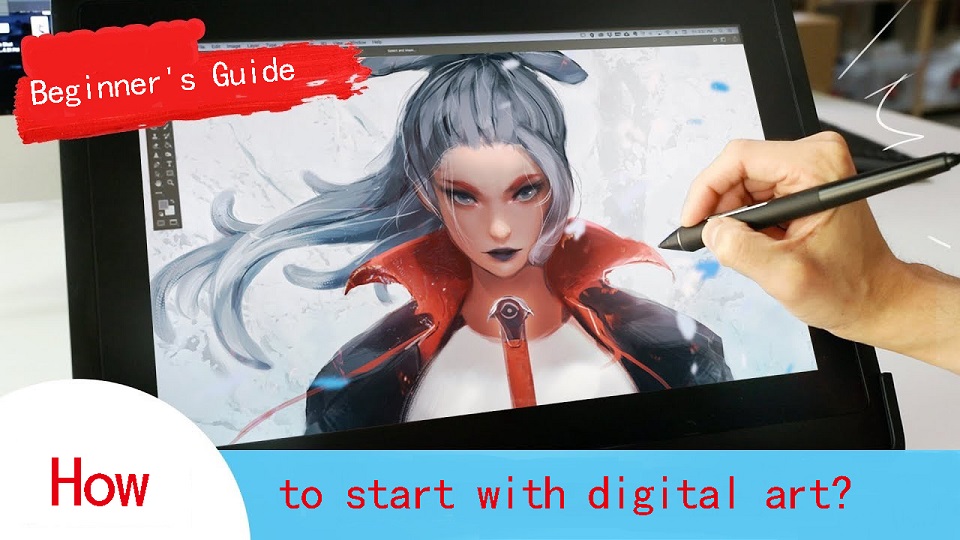
Nowadays, it seems that digital art is everywhere on the internet. There are dozens of types of digital art, ranging from digital painting to 3D animation.
Have you ever wondered how you can turn your creative ideas into stunning digital art? Anyone can be an artist in this digital age.
But getting started can be overwhelming. How do you begin? Fear not— it's easier than you think!
By providing an easy-to-follow beginner guide to start digital art, this article empowers newcomers to understand the types of digital art, choose the right tools and software, and where you can proudly display your masterpieces.
What is digital art?
Digital art is a contemporary artistic medium that encompasses a wide range of creative works produced using digital technology.
It is the fusion of traditional art techniques with the digital tools and techniques made available by computers, graphic tablets, and software applications.
Digital artists use these tools to create, manipulate, and enhance their artwork, resulting in a diverse spectrum of visual expressions.
The fundamental characteristic of digital art is the use of a digital canvas, such as a computer screen or graphic tablet, combined with digital drawing tools like styluses and pens.
This allows artists to paint, draw, sculpt, and design with remarkable precision, flexibility, and efficiency.
The artistry in the digital realm comes to life through the manipulation of pixels, vectors, and layers, making it a versatile and dynamic medium.
Different types of Digital Art
There are many different types of digital art, including animation, drawing, photo manipulation, 3d modeling, and more.
1. Photo Manipulation
Photo Manipulation is pretty simple — editing an image to whatever you want it to look like. Since you're using photos, this is a pixel-based, or raster, type of digital art.
There are subtler versions of it, like touching up a family portrait and fixing lighting and a few facial blemishes, and more prominent versions of photo manipulation, like combining a picture of a pirate ship and some planet images into a space pirate sci-fi scene.
2. Digital Illustration
Digital illustration, graphic design, and vector art is all around you, even if you don't notice it. It's in apps and app icons, websites, manuals and brochures, and even books.
This type of digital art is made of shapes all layered together to create an image like a flat illustration — shape/vector based, not pixel based. It's often used for branding and logos, and creates clean and crisp art.
3. Digital Painting
Digital painting is probably what pops into your mind when someone says ‘digital art'. It's raster/pixel-based, like photo manipulation, but unlike photo manipulation, which combines and edits images to bring them together.
with digital painting, you're creating something from a blank canvas. It's basically just drawing/sketching/painting digitally, and usually depicts characters, landscapes, and scenes.
4. Animations
Moving images or a series of drawings that come together to create motion. This includes everything from animated movies to GIFs you see online.
5. 3D Art
3D art is becoming more and more popular — it's graphics are being used in websites, apps, and interfaces in every category and subcategory.
3D modeling also has a huge role to play in the video game industry, as well as animated shows and movies. 3D models are digital objects that can be rotated and viewed from all angles. They're often used in games, movies, or product designs.
Choosing the hardware to get started with digital art
First thing you'll need when you want to get started making digital art, is hardware. There are two main options: computer + drawing tablet, standalone pen tablet.
1. Computer
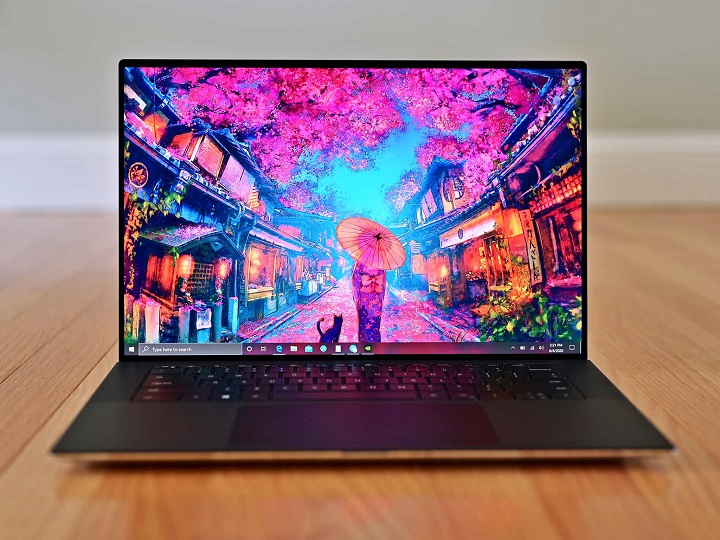
If the art program is heavy, your computer may use too many resources and you may end up getting lags while drawing.
This depends on the specifications of your computer; if it is a high-end one with the best in class CPU, GPU and copious amounts of RAM, then no need to worry!
Depending on your software, you would generally want a computer with:
-At least 16GB of RAM
-A discrete GPU separate from your CPU
-At, least an Intel Core i5 or Ryzen 5, or something equivalent
-You can also ignore all of these if you have a apple Mac with the M1 or M2 Processor.
2. Drawing Tablet
You can make digital art with a mouse, But a pen tablet with pressure sensitivity will give a much more natural feel when drawing.
Some things you want to focus on are: Drawing surface size, Pen, Pressure sensitivity, Express Keys, and Price.
There are two main categories of graphics pads for beginners: tablet without screen, tablet with display.
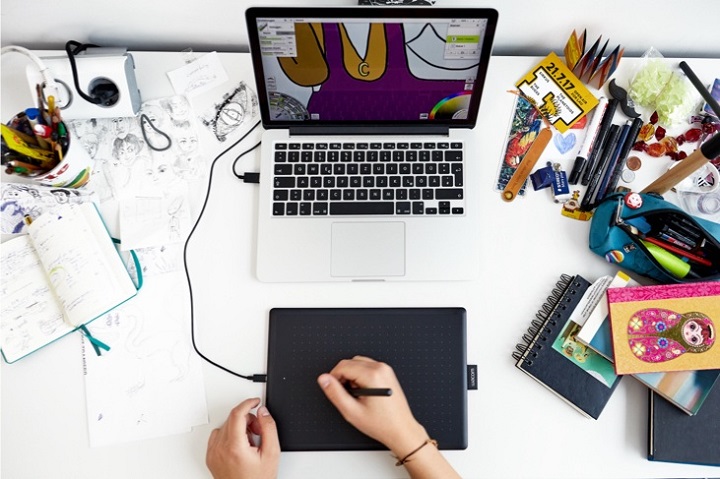
A non-screen graphic tablet have two components: a touch-pad, and a stylus. It works a bit like a mouse and needs to be attached to your PC or laptop.
In order to use the tablet, one needs a good sense of hand-eye coordination. These types of tablets are usually cheaper, but offer everything you would need to draw digital art.

Display tablets function like graphic tablets, but with a built-in monitor. You can draw directly onto a screen, which feels more intuitive, accurate and nature.
They are usually $200+ more expensive than graphics tablets, size range from 10-inch to 32-inch. But they still need an extra laptop or computer to plug your tablet into – these are essentially a screen monitor.
There are a number of brands for Drawing tablets, but the good 3 name brands you need to know are: Huion, XP-Pen or Wacom. Most tablets that these have to offer are really good, some being more expensive than others.
Wacom was meant for professionals, hence it has an expensive price. Huion and XP-Pen are brands generally bought by beginners and enthusiasts, because they have really good value for money. Other Best Wacom Alternatives include Veikk, Gaomon, and Ugee.
3. Standalone Pen Tablet
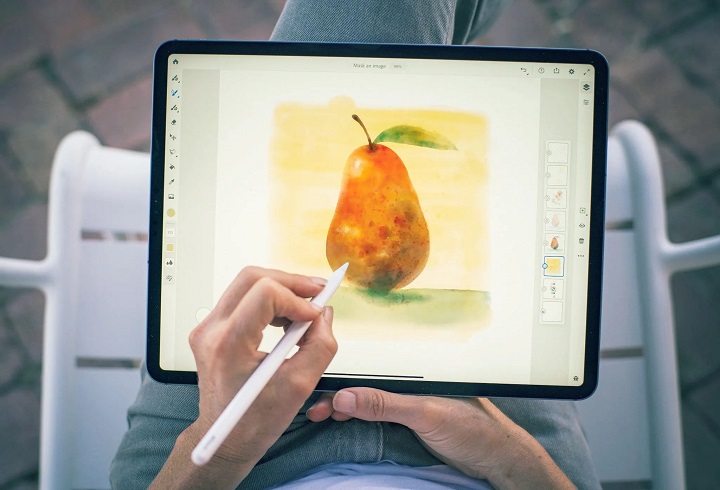
You can always use other standalone tablets, like the famous Apple iPad Pro (iPad OS), Microsoft Surface Pro (Windows) or Samsung Galaxy Tab lineup (Android).
All these tablets have pen input support, in-built computer and screen, This makes them very portable – you can take them anywhere, such as sketching on the couch or out in a cafe.
The downside is that they are more expensive, and you have a very limited selection of software available to you.
Choose a digital art software that suits you
This can be drawing software, or it can be 3D modeling software, or even animation software. Whatever works for you.
Each program has its unique strengths and features that can enhance your ability to create your own digital art.
Also, the choice of digital art software depends on your hardware and operating system, because not all software is compatible with all devices.
1. Photo Editing Software

To get started with photo manipulation, you need a photo editing program. While the industry standard is Adobe Photoshop, it's monthly recurring fee can be a bit steep for those just starting out.
Affinity Photo is a powerful and affordable image editor that is directly competing with Photoshop for enthusiasts and professional users.
A great free alternative that still has great function and a good amount of online tutorials is the desktop software GIMP.
Photopea, Canva or Pixlr Editor is perfect if you want to have a browser-based, online way to edit your photos.
2. Digital Illustration Software
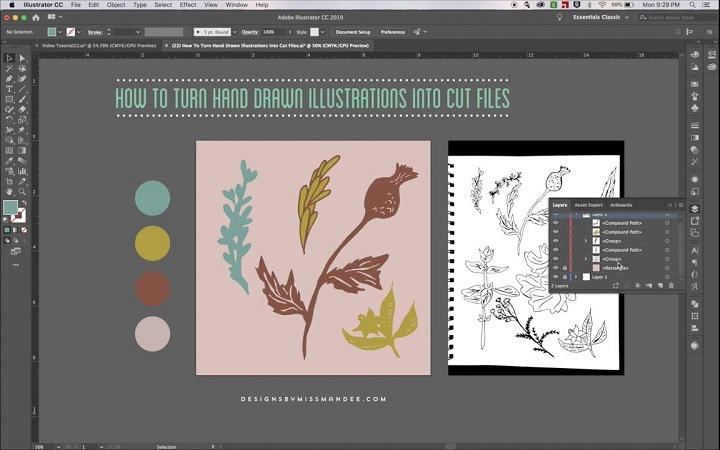
As for Digital Illustration software, the most popular digital illustration app is Adobe Illustrator, but as with Photoshop, it's monthly cost isn't all that appealing to beginners.
Coreldraw is another popular Illustration software for print ready graphics and illustrations, the UI is very user friendly and easy for graphics designers.
In terms of function and style, Affinity Designer is an impressive, low-budget alternative to Adobe Illustrator.
Good free alternatives to Illustrator is Inkscape, great to draw beautiful drawings, very fast and light weight.
3. Digital Painting Software

Many artists use Photoshop for digital painting because of Photoshop's wide range of brushes and tools, but there are also some other great alternatives with a cheaper price tag.
If you want to get into digital painting without spending a few hundred dollars every year. This includes Clip Studio Paint, Procreate, Corel Painter, Paint tool SAI, Sketchbook, and free drawing apps like Krita, Medibang Paint, Firealpaca, Mypaint, Artweaver, etc.
4. Animation Software
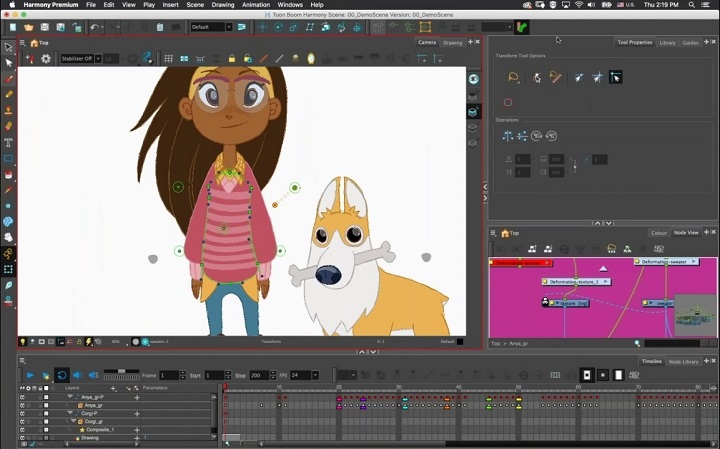
2D Animation Apps: For those who like drawing and creating 2D animation, Toon Boom Harmony, Adobe Animate, Moho Pro, Synfig Studio, Opentoonz, Pencil2D and TVPaint are all well-known and high-quality animations tools.
3D Animation Programs: For 3D animation, Start with any of the software - Blender , 3ds Max, Autodesk Maya, Cinema 4D, Houdini, Modo, Daz Studio, Cascadeur any one of them .
5. 3D Modeling Software
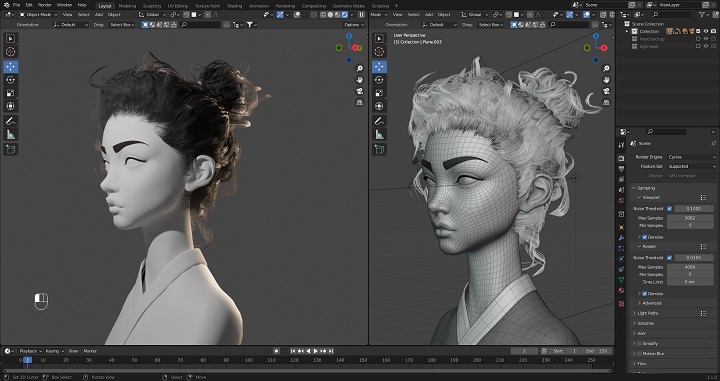
Maxon Cinema 4D, Autodesk Maya and 3DS MAX are three of the most famous 3D modeling software which artists and studios often use in many fields.
Pixologic ZBrush is a digital sculpting tool that combines 3D/2.5D modeling, texturing and painting.
Blender is the most popular 3D creation platform which is free, open-source and powerful. It supports the entirety of the 3D pipeline—modeling, rigging, animation, simulation, rendering, compositing and motion tracking, even video editing and game creation.
How to start Digital Art?
If you guys are a complete beginner with no art experience you should start with drawing by traditional methods first(pen and paper method).
We know that this is not the thing you were expecting but at least do some basic exercises which will give you the flow to draw in the drawing tablet or a iPad or any other gadgets you name it and it requires the skills.
Practice the Art
After getting comfortable with the basics, hardware and software, start your art journey by practicing art.
First choose your Niche or art of your interest and start working towards it. because in the field of art you will improve only when you practice daily or at least practice two to three days a week.
Once you started practicing you will see the results as time goes by and trust us guys it will give you a satisfaction which makes you happy and gives you motivation to draw more and practice more.
Best Digital Art Sites to Share Your Artwork
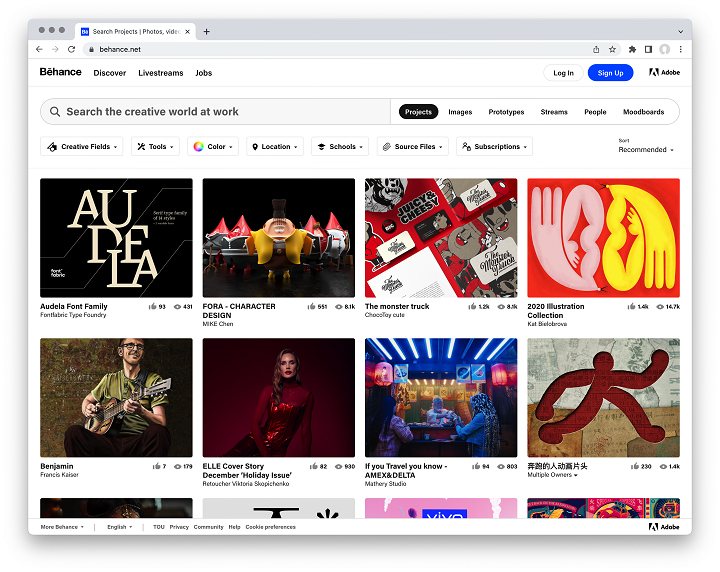
In the digital world, authenticity and connection are key.
Are you ready to show the world your artwork? These well-known online art sites are the right places to share and explore new digital art Ideas:
DeviantArt: The place to discover millions of works of art in every shape, size, and style. You can also join art tribes and make your voice heard.
Behance: Here you can exchange ideas with other digital artists, show off your portfolio, and let the community boost your creative ego.
ArtStation: For professionals and aspiring artists alike, especially those in gaming, film, and entertainment. Show them what you've got!
Dribbble: If you are interested in digital design, illustration, or animation, this is your stage to shine. It's also a place where you might land a gig.
Pinterest: Here you'll find an endless treasure trove of ideas and inspiration for all your digital art projects. Create boards, save pins, and unleash your creativity.
Medium: Not just for reading, but also your platform for sharing your stories, especially those related to digital art. Immerse yourself in the world of Blogging Guide, Digital Art, and Pixel Vision.
In addition, Utilize social media to your advantage. Share your art on platforms like Instagram, Facebook, and Twitter. Engage with your audience, and post behind-the-scenes glimpses into your creative process.
Conclusion
We hope our post gave you a better guide on digital art. Enjoy the process and not the destination so that you will feel the satisfaction guys.
Getting started with digital art can feel like an overwhelming task, but don't let the stress get to you.
Adjust your expectations, and watch some tutorials. Your goals won't seem so formidable once you get the hang of things.
If you can do that, you'll be well on your way to mastering a new skill set.
Source: https://pctechtest.com/beginner-guide-to-start-digital-art
-
IPad Pro vs Surface Pro 9 Comparison
Donnerstag, 30. November 2023
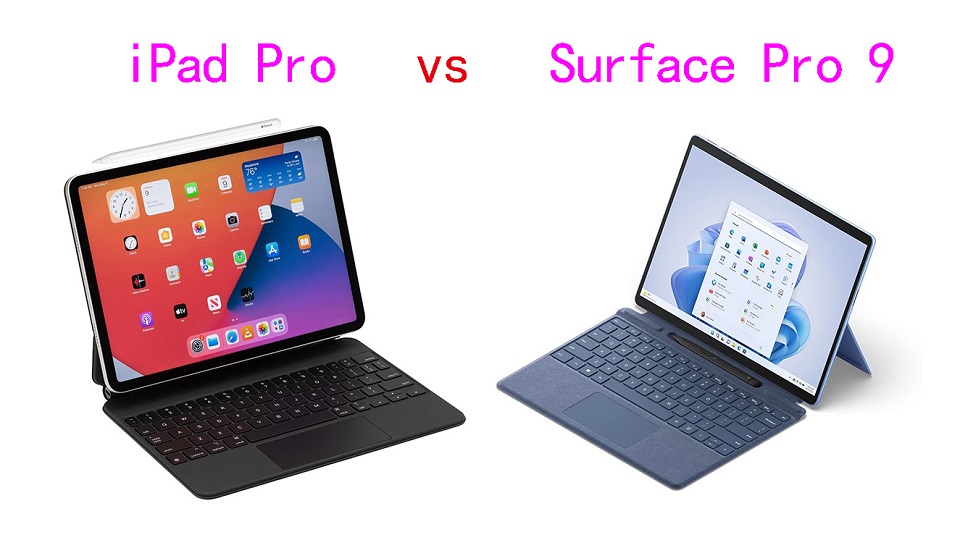
For artists, photographers, designers, students, and other creative professionals, a tablet can be a handy second device for getting work done.
In the portable and handy tablet market, Surface Pro 9 and Apple iPad Pro (6th Generation) are two dominant players, Because they comprise powerful hardware, sleek design, and diverse features.
Both are impressive. But, what's the differences between them? which one is better and best suited to meet your preferences/needs?
In this article, we shall be opting for an exploration of their strengths along with their weaknesses. It will further help you reach a fair decision.
IPad Pro vs Surface Pro 9 Comparison: Which One is Better?
We will take a look at the hardware, OS, pen input support, performance and many more features of these 2 devices: iPad Pro vs Surface Pro 9 Comparison.
Design
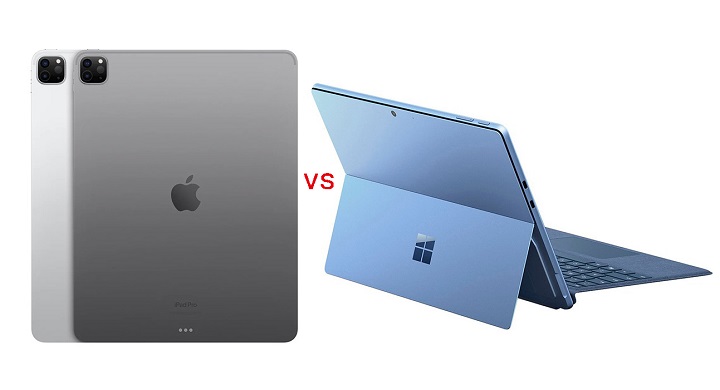
The 12.9-inch iPad Pro measures 11.04 x 8.46 x 0.25 inches and weighs 682 g. The Surface Pro 9 comes in at 11.3 x 8.2 x 0.37 inches and weighs 879g.
Both iPad Pro and surface pro 9 tablets are super slim, feature an anodized aluminum body, and pack a large, immersive display.
But the bezels on the iPad Pro are much slimmer and consistent all the way around. The bezels on the Surface Pro 9 are similarly narrow on the sides, but the top and bottom borders are thicker.
Both tablets are very close when comes to portability, They are still very compact and easy to bring around compared to the smaller 9 to 11-inch model, but when it comes to one-handed usage, the experience with the smaller model is significantly better.
The Surface Pro 9 comes in four colors: Platinum, Forest, Graphite, and the Sapphire option. The iPad Pro, on the other hand, is offered only in two colors: Silver and Space Gray.
Screen Panel
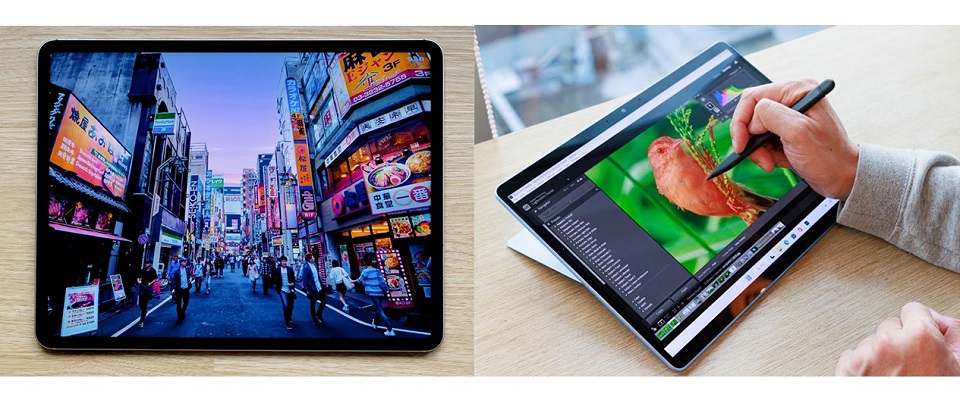
Both Surface Pro 9 and iPad Pro sport high-quality displays powered by proprietary technologies. Microsoft's Surface Pro 9 uses PixelSense Flow while Apple's iPad Pro relies on Liquid Retina XDR.
The difference is backlighting. Apple's iPad Pro features mini LED backlighting that gives better contrast and HDR quality than the Surface Pro's conventional IPS LCD panel.
iPad Pro's display has a contrast ratio of 1,000,000:1, which is impressively capable of producing deep blacks while maintaining a high brightness of up to 1600 nits, while the Surface Pro 9 maxes out at 450 nits and has a 1,200:1 contrast ratio.
This means that the iPad Pro is more colorful, brighter and better suited for outdoor use.
Screen Size and Resolution
Surface Pro 9's screen comes at 13-inch with a 2,880 by 1,920-pixel resolution, giving it a pixel density of 267 PPI.
The iPad Pro is available in two sizes, the 11-inch and the 12.9-inch. The 12.9in model offering a 2,732 by 2,048 resolution, delivering 264 PPI.
That 3-pixel difference aren't worth fussing over. At this pixel density, the display will look perfectly sharp.
The Surface Pro 9 has a 3:2 aspect ratio, while the 12.9-inch iPad Pro has a 4:3 aspect ratio. Both are fine and suited for viewing videos and working in documents, but the 3:2 aspect ratio is a bit longer in portrait mode.
Color Accuracy
The Surface Pro 9 has a color accuracy of 75.1% DCI-P3, while the iPad Pro has a wider color gamut of 100% DCI-P3.
This means that the iPad Pro is more accurate, vivid and vibrant when displaying colors.
Refresh Rate
Both displays have a 120Hz refresh rate, which makes content in motion on the screen smoother, crisper, and more responsive for scrolling, drawing, gaming, watching movies, and more.
Moreover, It dynamically adjusts the screen refresh rate up to 120Hz and down as low as 24Hz on an iPad Pro and 60Hz on the Surface Pro 9.
Performance
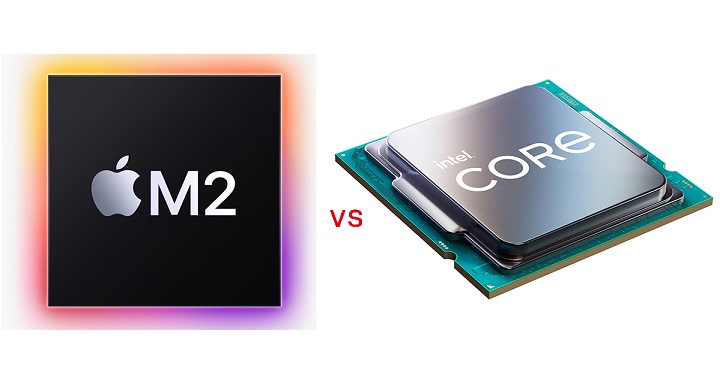
Microsoft's Surface Pro 9 relies on the 12th gen Intel processor found in laptops (i5 or i7), while Apple's iPad Pro is powered by its own proprietary M2 processor.
The cellular variant of the Surface Pro 9 uses a Microsoft-exclusive ARM CPU developed by Qualcomm. It will have a slower performance than Intel, but a superior battery life.
12th gen Intel processor can provide a speedy performance and should be ideal for productivity tasks like note taking and some light creative work (Photoshop or, say, Lightroom).
However, Since the Surface Pro 9 relies on Intel Iris Xe graphics instead of a discrete graphics card, you're going to have a rough time for advanced gaming, 3d modeling and animation.
Apple M2 SoC is renowned for both power and efficiency. It is faster than the Surface Pro 9, able to run more intensive tasks such as video editing and gaming with ease.
Memory and Storage
The iPad Pro start with 128GB of storage, with options for 256GB, 512GB, 1TB, and 2TB. The non-terabyte capacity models have 8GB of memory, while the terabyte ones have 16GB.
Microsoft's Intel models are available in configurations with 8GB, 16GB, and 32GB of LPDDR5 RAM, while the SQ 3 version has 8GB and 16GB LPDDR4x variants.
Microsoft also includes 128GB, 256GB, 512GB and 1TB storage options across all model.
iPad OS vs Windows 11
The Surface Pro 9 runs a full version of the Windows 11 operating system. This gives it more customizable features, access to an open file system, and access to powerful software, including the desktop versions of Office and Photoshop.
But Windows 11 is not as smooth as iPad OS, and the tablet mode is bad. The UI is very hard to use and nothing is optimised for touch as the iPad.
On the other hand, the iPad Pro uses the tablet-exclusive iPadOS, which have apps that are designed for a touch-based computer. So it is very limited for normal desktop OS functions eg multi-tasking, file manager.
There are really great apps on the iPad, and some are pretty much iPad exclusive, like, for example, Procreate, which is one of the best drawing apps out there.
However, most of the time, the mobile version of the app like photoshop, is not as feature-rich as Windwos desktop version.
The OS & software you use comes down to what you need. If you need a full operating system, then the surface is the obvious choice. As for consuming content, scrolling through the web, and such the iPad is great.
We don't recommend Surface Pro 9 SQ3 version, because some areas of Windows 11 and 64-bit apps aren't optimized for ARM-based chipsets. It should still be great for web browsing and other day-to-day activities while other apps like Photoshop might not work quite as well.
Apple Pencil 2 vs Surface Slim Pen 2
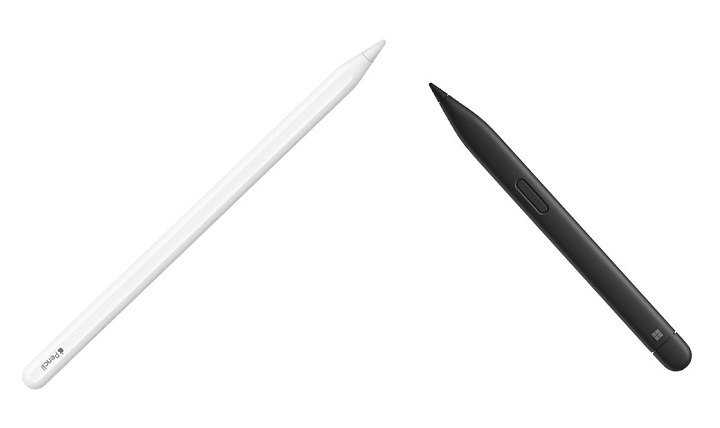
Neither The Surface Pro or iPad Pro comes with a pen but they are both pen compatible. It's an additional $100 and $ 120 respectively.
Surface Slim Pen 2 has 4,096 levels of pressure sensitivity and precision tilt detection, which allows for a natural writing and drawing experience.
Slim Pen 2 is really comfortable to hold on and it is also the only one of the two styluses to sport an eraser on its back. You could erase stuff by just flipping the pen around.
Still, when it comes to the overall drawing experience, Apple Pencil (2nd Generation) is the best active stylus on the market.
with a 9ms response rate that makes it feel responsive in use, It has a handy Hover feature, decent tilt sensing and pressure detection too.
Use it to take quick notes, use it for drawing, use it for general browsing even, it all feels great.
Apple Magic Keyboard vs Microsoft Signature Type Cover
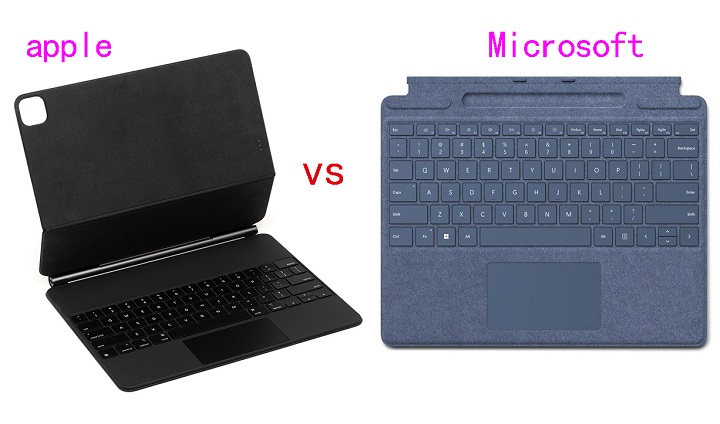
The Surface has a built-in kickstand, which is pretty useful. The iPad doesn't have a built-in stand, but of course, you can get a keyboard case that can double as a stand for it.
Microsoft's Signature Type Cover Keyboard has three levels of white backlighting and enough up-and-down key travel for satisfying tactile feedback. It also has an easy-to-use glass touchpad and room to put away the Surface Slim Pen 2 and recharge it.
Apple's Magic Keyboard Attaches magnetically to iPad, It folds smaller than most other keyboard cases, wrapping tightly around the iPad. With scissor-switch keys, Typing on it is comfortable and convenient.
The keyboard is a necessity if you want both tablets to replace your laptop. Apple charges $329 for its Magic Keyboard, while Microsoft's Signature Type Cover Keyboard costs $130.
Cameras
The Microsoft Surface Pro 9 doesn't pay much attention to its camera. You get a 5-megapixel camera on the front for video calling and Windows Hello authentication, with a 10MP autofocus camera on the back.
The iPad Pro, in contrast, is the significantly winner. You get two cameras at the rear (12MP and 10MP wide angle) along with a LiDAR sensor for depth mapping.
Combined with features like auto image stabilization and TrueTone flash, the iPad Pro's cameras are great for casual photography and 4K recording at 60fps.
The front camera sports a 12MP resolution with cinematic video stabilization. The Ultra Wide lens along with TrueDepth technology renders even the front camera footage high quality.
Luckily, the front cameras of Both tablets are able to do panning and zooming to make sure you're in the frame. Apple called "Center Stage", while microsoft called "Automatic Framing feature".
Audio
Surface Pro 9 comes with dual far-field microphones that pick up your voice clearly and a set of stereo 2W speakers. It is a superb device for video calls, then, but less so for entertainment.
It's hard for two speakers to beat four speakers on a tablet. The iPad Pro's quad-speaker setup produces loud and surprisingly balanced audio, whether you're streaming Pandora or immersing yourself in a flick.
Furthermore, The collection of five "studio-quality" microphones dotted around the iPad Pro's enclosure is paired with the speakers.
Connectivity
For local wireless networking, both Apple and Microsoft include support for Wi-Fi 6E, which will be handy when on appropriate networking infrastructure.
Apple does use Bluetooth 5.3 in the iPad Pro, while Microsoft use Bluetooth 5.1 in the Surface Pro 9.
Apple includes 5G cellular support in its iPad Pro as a paid extra, which supports both sub-6GHz and mmWave connections.
Microsoft limits its 5G connectivity to models sporting the SQ3 chip- ARM-equipped Surface Pro 9, You cannot get cellular on the Intel models.
On to physical connectivity, and this is where Microsoft pulls ahead.
Surface Pro 9 have two USB-C/Thunderbolt 4 ports, a Surface Connect port, and a Surface Type Cover port.
Apple includes a single USB-C/Thunderbolt 4 port, though it also has a Smart Connector for connecting with accessories.
This makes it easier to connect a hub and attach multiple peripheral devices to the Surface Pro 9.
Battery Life
If battery life is a huge priority, the iPad Pro might be the way to go.
The iPad Pro's battery lasted around 10 hours of continuous browsing or 8 hours of drawing on Procreate with the 2nd gen Apple pencil.
On the other hand, Surface Pro 9's battery offered 8 hours of web surfing or 6 hours of drawing on Sketchable with the Surface Slim pen 2.
The main reason behind the iPad Pro's better battery life is its less power-hungry M2 chipset. Surface Pro 9's 12th Gen Intel CPU is less efficient in battery consumption.
Price
Microsoft Surface Pro 9 starting at $1,099.99, This model comes equipped with an Intel Core i5 processor, 8GB of RAM, and a 256GB SSD for storage.
Retail prices for the 11-inch iPad Pro start at $779.97, while the 12.9-inch iPad Pro starts at $1,049.00. This model is equipped with M2 processor, 8GB of RAM, and 128GB storage.
Similar Posts: Samsung Galaxy Tab S9 Ultra vs iPad Pro Comparison ,Wacom Cintiq vs iPad Pro Comparison , XP-Pen Artist 22R Pro vs Wacom Cintiq 22 Comparison.
Conclusion
Surface Pro 9 is a great 2-in-1 device for productivity and compatibility in terms of Windows software.
iPad Pro excels in terms of touch-based interfaces, creative abilities, battery life, integration with the Apple ecosystem, and more.
With their many features and capabilities, the Microsoft Surface and iPad Pro are both excellent options for anyone looking for a powerful device.
Both are great for watching videos, browsing the web or video conferencing. They also each have solid touch screens you can draw or write on.
Ultimately, Whether you choose the iPad Pro or the Surface Pro 9 depends on your preferences and specific needs.
-
Ipad Pro vs Samsung Galaxy Tab S9 Ultra Comparison
Samstag, 25. November 2023
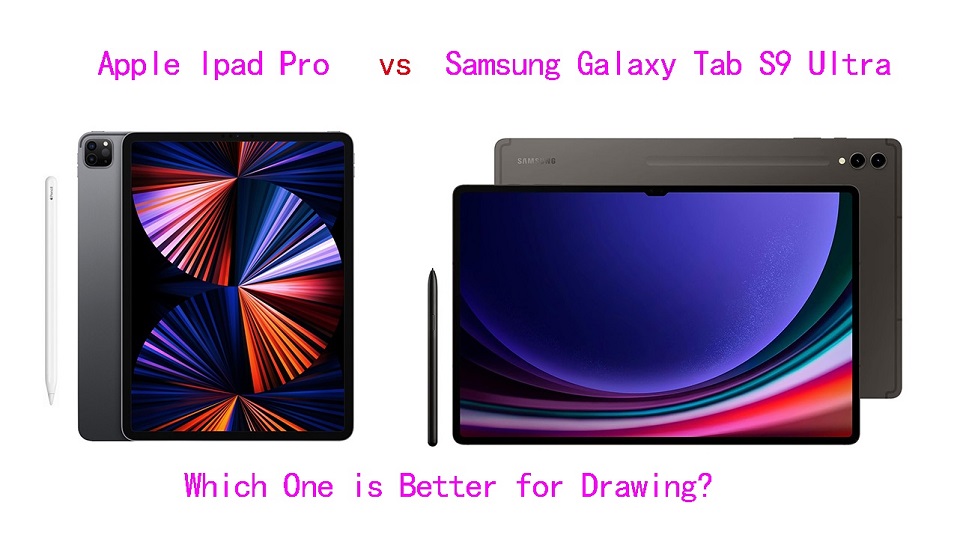
If you are looking for a portable way to draw on the go then both Samsung and Apple's offerings are worth considering.
Both the Apple iPad Pro vs Samsung Galaxy Tab S9 Ultra are premium tablets made for creative professionals and those who will make use of all the goodies they provide.
Which is better? The iPad Pro or the Samsung tablets? Many artists are in a never-ending conflict of deciding which one is best for taking notes, digital drawing and graphic design.
Well for your reassurance, we are here to resolve this conflict by stating the pros and the cons of both which might set a path for you making it easier for you to decide.
Apple Ipad Pro vs Samsung Galaxy Tab S9 Ultra Comparison: which one is better for drawing?
Below, We will dive deep into the important features of Apple IPad Pro and Samsung Galaxy Tab S9 Ultra, we discuss the stunning display, powerhouse performance, drawing capabilities, OS & Software, etc.
If you're into media consumption or productivity on the go, this review breaks down all the reasons which one could be your next tablet.
Other similar posts: IPad Pro vs Wacom Cintiq , IPad vs Graphic Tablet , Android Drawing Pads .
Size, Design and Build Quality
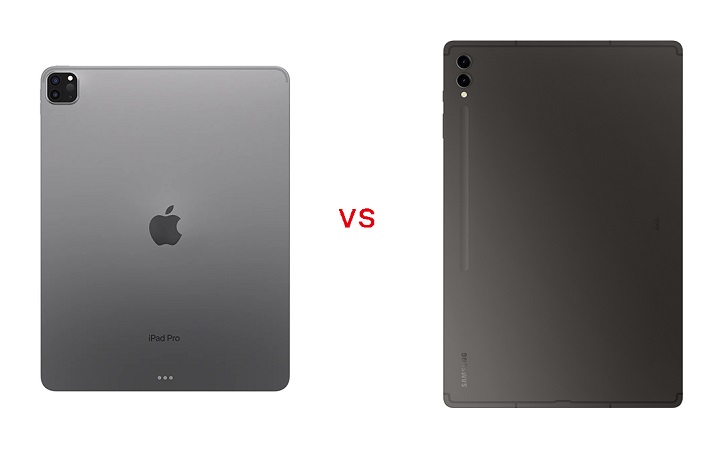
Samsung Galaxy Tab S9 Ultra measures 12.85 by 8.21 by 0.21 inches (HWD) and weighs 732g. For comparison, the iPad Pro (6th Generation) has a slightly smaller 12.9-inch screen in a slightly wider body of 11.04 by 8.46 by 0.23 inches and 643g.
Both Apple and Samsung offer excellent designs and build quality with their high-end tablets. They are all thin, strong, and lightweight. There are just enough bezels around the screen to hold the devices without activating the touchscreen.
However, the Tab S9+ stands out with a fully dustproof and waterproof IP68 rating. Apple doesn't make any sort of durability claim about the iPad Pro.
Aspect ratio of the iPad Pro is 4:3 and this makes the tablet useable in both landscape and portrait orientation.
Samsung Galaxy Tab S9 Ultra use the 16:10 aspect ratio which more suited for landscape orientation. When using Samsung tablet in vertical orientation, together with the UI elements, e.g. palettes, your canvas space is almost too vertical.
The iPad Pro comes in silver or dark grey, While the Tab S9 Ultra is available in two colors, Beige or Graphite.
If Galaxy Tab S9 Ultra is too big for you, the midsize Galaxy Tab S9+ has a 12.4-inch screen and measures 11.23 by 7.30 by 0.22 inches and weighs 581g, while the standard Tab S9 has an 11-inch screen and measures 10.01 by 6.53 by 0.23 inches and weighs 498g.
For most artists, another 11-inch iPad Pro is also a better choice. It's easier to carry around than the 12.9-inch model and cost $300 less, no matter which storage configuration.
Screen Size and Resolution
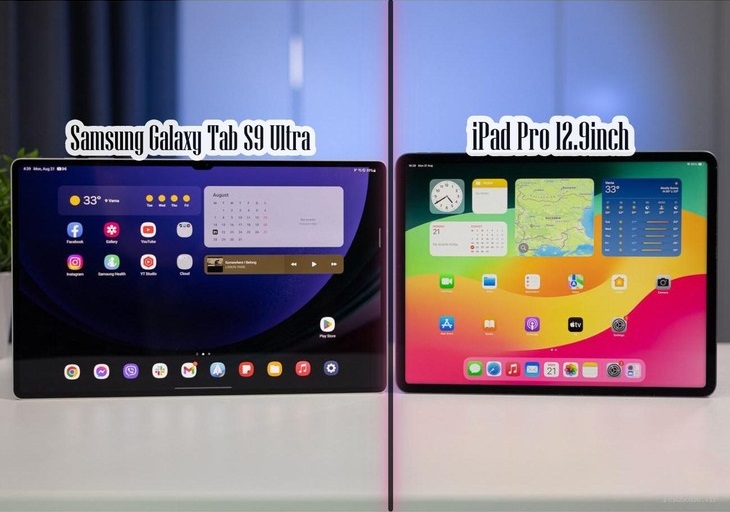
For a good drawing tablet, it is important for the display to have a decent size, high-resolution and good color accuracy.
Samsung's Galaxy Tab S9 Ultra sports a massive 14.6-inch AMOLED display with 2960x1848-pixel resolution, at a pixel density of 240 ppi, and HDR10 compliance.
The iPad Pro features a 12.9-inch Liquid Retina XDR (Mini LED backlight) display with a generous 2,388 x 1,668 resolution, at a higher pixel density of 265 ppi, supports HDR10.
The larger screen gives you a larger canvas resulting in a superior drawing experience. But you will likely need a big backpack to carry with you, less portable.
Samsung's AMOLED panel has much better contrast and better blacks and it's generally a bit snappier. But on the flipside, it's not as bright and mini LED will give you great HDR.
Anyway, both displays are superb, looks fantastic, vivid and crystal clear. At this level of quality, all of this seems like nitpicking.
Color Gamut
Color-wise, the iPad Pro's display covered 117.1% of the sRGB color gamut and 100% of the more demanding DCI-P3 color space. So it can represent colors accurately on their screen.
Samsung on the other hand has a tendency to oversaturate the colors, especially in the vivid mode.
In Natural mode, the display achieved 117.7% of the sRGB color gamut and 100% of the more demanding DCI-P3 color space. In Vivid mode, the display achieved 181.7% / 128.7 %, respectively.
We suggest you use the “nature mode” display settings on your Galaxy Tab S9 Ultra for true-to-life colors on your screen.
Brghtness
A display with higher brightness is ideal as the screen is more visible outdoors or when working in a bright environment.
The iPad Pro takes the lead what it comes to display brightness. It has up to 1,000 nits of full-screen brightness and 1,600 nits peak brightness when playing back HDR content, which can really make movies pop.
Samsung Galaxy Tab S9 Ultra has a decent 420 nits of standard brightness, and 930 nits of peak brightness. While it might seem like it's not that high, it is actually very bright, you can see the content clearly even under the sun.
Refresh Rate
Both Apple and Samsung table comes with a refresh rate of 120Hz, which results in a smoother animation and a buttery-smooth tablet experience.
It also massively affects your stylus experience and makes the lines drawn by the stylus appear incredibly fast on your screens with no apparent lag.
But iPad Pro which has a pro-motion display which means it can adapt the refresh rate according to the way you're using your tablet.
So when you're just reading some text, it will be super low and then it will jump to 120HZ for those visually demanding tasks.
There is an option on the Samsung where you can use Bixby routines to set the refresh rates on certain apps, but that's a rather tedious workaround and it still only lets you chose between 120 and 60Hz.
Power & Performance
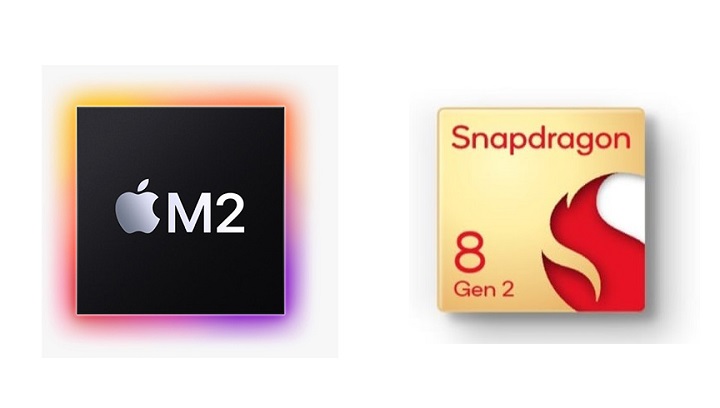
The Samsung Galaxy Tab S9 Ultra runs on a Snapdragon 8 Gen 2 octa-core processor, making it snappy and quick as well, which delivers a top-tier performance experience.
The entry-level model of Samsung Galaxy Tab S9 Ultra packs 256GB of storage and 12GB of RAM, but you can pay more to configure the tablet with up to 16GB of RAM and 1TB of storage.
Thanks to the M2 processor, the iPad Pro offers much faster performance than S9 Ultra, especially for graphics. This maybe not super important to a lot of users, but if you are a creative or you work with massive files, this is definitely something to consider.
There's 8GB of RAM for the 128GB, 256GB and 512GB storage options, while the 1TB and 2TB variants get 16GB of RAM. The 16gb ram version will help with performance.
Apple Pencil vs Samsung S Pen
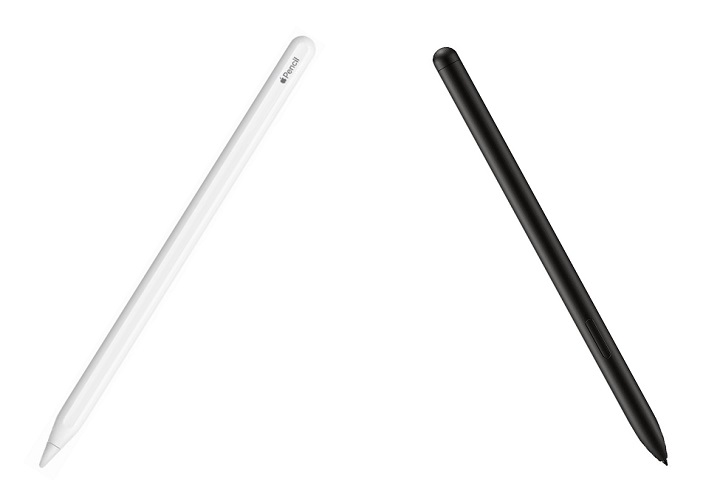
A stylus is the most essential part of the drawing device, Because it determines your drawing experience of using that tablet.
Design of Apple Pencil and Samsung S Pen is quite similar. Both are cylindrical except for a flat side that allows the stylus to attach to the side of tablet.
Whereas the Apple Pencil snaps to the edge of the iPad Pro, Samsung put a magnetized groove in the Galaxy Tab S9 Ultra's rear panel to hold the included S Pen stylus.
The Samsung S Pen has has a physical button and a soft rubberised nib that makes writing on the glass so much easier.
Charging is only needed to operate the shortcut button on the S-pen, you can still use it for writing and drawing when the battery is depleted.
Apple Pencil 2 has a hard tip and is powered by battery. There is a touch-based shortcut you can activate by tapping the side of the Apple Pencil.
By comparison, Apple Pencil 2 is slightly thicker, longer, and havier than the S Pen. Weight distribution is better, pairing snappier, you can use it between iPads instantly.
The feel of drawing with the pen tips are different and which is better will come down to personal preference. But the S pen is included with the Samsung tablet, whereas you have to pay extra US $129 for the Apple Pencil, which is a very Apple thing to do.
Both Apple Pencil 2 and Samsung S Pen supports tilt recognition, pressure sensitivity and palm rejection. They are low latency, responsive, and have accurate tracking.
However, Initiation activation force for the Apple Pencil 2 is lower than the S Pen. This means Apple Pencil is more sensitive at lower pressure. With the S Pen, you have to press slightly harder for the tablet to register your pen strokes.
OS & Software
When buying any mobile device these days an important consideration is the ecosystem. One of the major differences between iPad and samsung tablet is the OS and software.
The Samsung Galaxy Tab S9 Ultra runs on Android while the Apple iPad Pro Runs on iPadOS. Comparing Android with iPadOS from the point of view of an artist, the iPadOS have more advantages.
You will not find IPad drawing apps like Procreate, Adobe Fresco, Affinity Designer and many more of the creative apps you're used to in the Google Play store. Same goes for popular Handwritten notes apps like Good Notes and Notability.
The selection of apps in the Play Store is still limited in comparison to the App Store. Luckily, There are still plenty of android drawing apps available: Ibis Paint X, Infinite Painter, Clip Studio Paint, Sketchbook, Krita, Medibang Paint, which are equally good.
The decision will likely also depend on whether Android or iOS is more convenient for you. iPad Pro is a no-brainer option of the two if you own an iPhone and other apple devices.
If you're familiar with the Android ecosystem, especially if you own a Samsung Galaxy smartphone, this will be the better option of the two, more seamlessly fitting into your tech lifestyle.
Drawing Surface
Both Apple and Samsung tablets come with glossy screens. This can be problematic for drawing, as it can be slippery and make it difficult to maintain control over the stylus.
To address this issue, some users choose to apply a matte textured film to the screen protector.
The matte glass protectors aren't nearly as coarse and still provide all the grab/resistance to emulate a decent on paper feel.
You can learn more details here: Matte vs Glossy Screen .
Multitasking
The second advantage of the bigger and wider screen is multitasking.
Whilst multitasking on the iPad Pro did come a long way and works pretty well, the Samsung offers a lot more flexibility and more windows.
You can have three separate multitasking windows open and still add a popup window on top, you can resize them however you want, it's just overall more flexible.
Using with external display
There's an app called AstroPad that allows the iPad to show and use what's on your desktop computer. Basically, it allows you to use desktop software, such as the full version of Photoshop. The app performs quite well.
There are 2 other apps called "Duet Display” and “Sidecar” that lets you use your iPad as a display that extends or mirrors your Mac desktop.
Samsung Tab S9 Ultra can be used with an external display via Samsung Dex, basically the desktop user interface of Android where you get the taskbar, can resize windows, overlap windows.
When connected, the external display will show Samsung Dex and the tablet will show the usual tablet interface.
Connectivity
Both tablets feature GPS, mmWave and sub-6GHz 5G (optional), Wi-Fi 6E, Bluetooth 5.3, and USB Type-C ports.
However, the iPad Pro feature Thunderbolt 4 connectivity, which is 4x faster (40Gb/s) compared to Samsung's USB 3.2 Gen 2's 10Gb/s transfer speeds.
This wider bandwidth opens up a lot of possibilities, including higher-resolution video output and faster data transfer speeds when connecting to external storage devices.
The Galaxy Tab S9 Ultra can drive 4K screens, while the new iPad Pro models can drive 6K screens. This could be important for those who actively use a tablet in their workflow or entirely depend on them for getting things done on the go.
Apple Magic keyboard vs Samsung Book Cover Keyboard
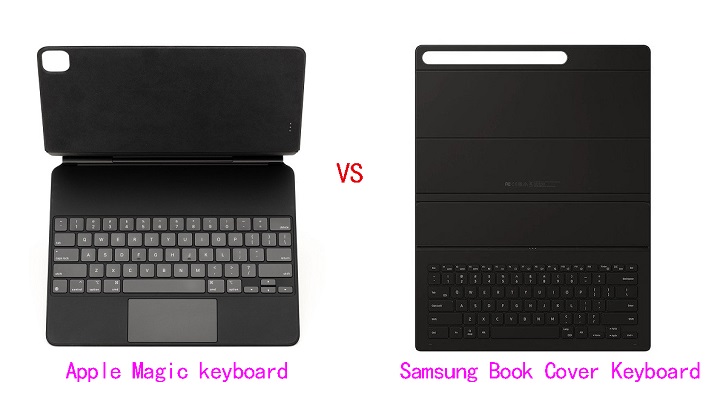
At the bottom of the Samsung Tab S9 Ultra and the iPad Pro, you will find a connection pin that snaps to the keyboard accessory.
Samsung sells a compatible keyboard case for $129.99. Apple, meanwhile charges $149 for a Magic keyboard case designed to work with the iPad Pro.
The typing experience on the Apple Magic Keyboard is absolutely superior. The Samsung keyboard feels flimsy and cheap.
In addition, Both tablets are compatible with third party wired (via USB C) and wireless (via Bluetooth) keyboards and mice.
Cameras
Both have 12MP ultra-wide cameras on the front. As for rear cameras, the iPad Pro has an f/1.8, 12MP Wide, and f/2.4 10MP Ultra Wide camera, plus a LiDAR scanner.
The Samsung has an f/2.0, 13MP wide camera but only a 6MP ultra wide, which shoots at f2.2 aperture. Both can record in 4K and let's just agree that the quality is alright.
Speakers
With audio this often tends to be a matter of taste and preferences.
In our experience, the iPad Pro offered clearer, fuller and richer audio that packed more bass than Samsung's, even though both slates have four speakers.
Privacy and Security Protections
On the security front, the iPad Pro includes a user-facing camera and IR scanner to enable Face ID. But it doesn't have TouchID.
Samsung Galaxy Tab S9 Ultra have great facial recognition, an optical fingerprint sensor and the usual PIN and password options.
Expandable Storage
For Samsung Galaxy Tab S9 Ultra, you can always add a microSD card for storage expansion.
Apple iPad Pro does not have any such option. Although you can plug in external hard drives via USB-C port.
Battery life
Apple iPad Pro as well as the Samsung Galaxy Tab S9 Ultra comes with really power-efficient processors.
Combined with larger battery sizes of 10,758 mAh and 11,200 mAh, respectively, all these tablets last a fairly long time.
M2 iPad Pro 12.9" battery life is around 10 hours with normal non-gaming usage. Samsung Tab S8 Ultra has 8hr+ battery life.
Additionally, the Samsung Galaxy Tab S9 Ultra is capable of 45 Watts of fast charging, whereas the iPad Pro can charge up to 30 watts.
Price
Apple's 12.9-inch iPad Pro starts at $1,078.94, and up to a maximum price of $2,224.00. You can pay extra for more storage or the option to have cellular connectivity in addition to Wi-Fi.
The entry-level Tab S9 Ultra comes with 12GB of RAM and 256GB of internal storage at $1,130.00, but Samsung is also selling two upgraded models: one with 12GB of RAM and 512GB of internal storage for $1,784.00, the other with 16GB of RAM and 1TB of internal storage for $2,299.00.
If you're more interested in doodling, the Apple Pencil costs $129, whereas Samsung includes an S Pen stylus for free with the Galaxy Tab S9 Ultra.
Conclusion
After careful consideration, Samsung's tablets offer better value, but the iPad Pro 12.9-inch (6th Generation) offers a better overall experience.
If you're looking for a large, immersive tablet with a great display for productivity, drawing and note-taking, the Samsung Galaxy Tab S9 Ultra is a very good option.
However, serious digital artists may want to stick with the iPad Pro. In addition to painting, it is also great for graphic design.
iPad Pro still takes the lead here with just the right screen size, higher processing power, the ergonomics of Apple Pencil, and the simplicity of the Apple ecosystem.
We will also recommend you choose based on the software/apps you want to use, and the other features you may find useful.
Source: https://pctechtest.com/ipad-pro-vs-samsung-galaxy-tab-s9-ultra
-
Best Alternatives to Wacom Tablets
Mittwoch, 22. November 2023
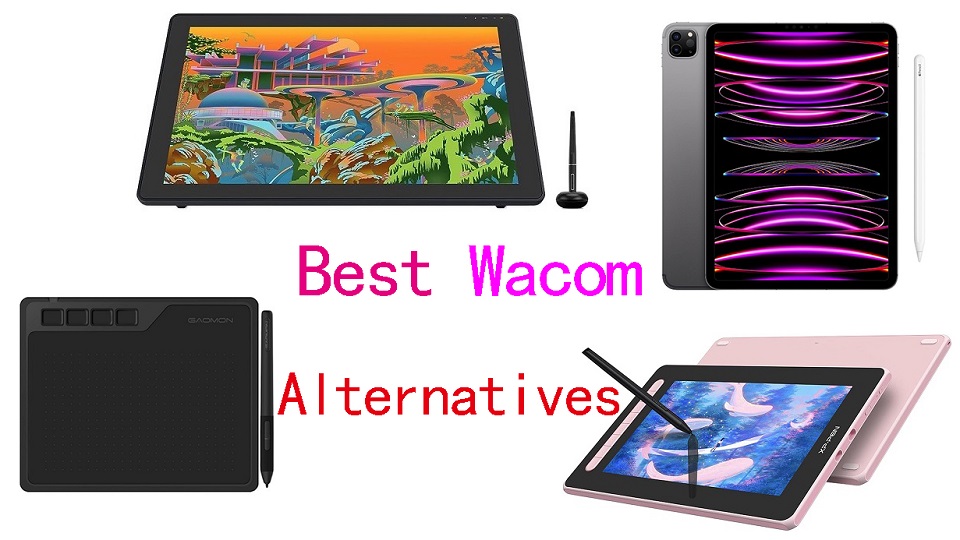
The graphic tablet is one of the most necessary accessories in the graphic artist's studio.
It allows artists to use a pen to make creative design such as incredible artwork, illustrations, and animations onto the computer screen.
In addition, it speeds up workflow, improves precision and offers greater ergonomics than a mouse.
Wacom is a well-known brand in the world of digital art, but their tablets can be quite expensive.
Fortunately, there are some best wacom alternatives that offer the same quality and performance without breaking the bank.
Why is Wacom considered the Best?
Wacom is considered by many to be the industry standard. Wacom has been creating drawing tablets for years. They are well known for creating reliable, long-lasting products, with a lot of key tech.
In the industry, most artists use Wacom products because of their quality, durability and superior accurate and precise.
Wacom is known for providing quality driver support. Their tablet drivers continue receiving updates long after a product is released.
Is the Wacom worth the Money?
Wacom tablets are very expensive, It costs twice as much as some of its counterparts in the market.
However, the brand is renowned for its high quality, And their tablet offers an accurate and pleasant drawing performance. In addition, there are some brand premiums.
If you are professional and have a flexible enough budget, then you shouldn't think twice about getting the Wacom.
What types of tablet does the Wacom Offer?
Wacom provides intuos pen tablets for beginners, Cintiq interactive pen displays, and MobileStudio Pro standalone drawing pads to equip and inspire everyone to make the world a more creative place.
Wacom Intuos and Intuos Pro are drawing tablets without a screen, so you need to draw on the tablet while looking at your computer screen.
These drawing tablets aren't as powerful as others but they are the most affordable. This makes them the best option for budding artists who want to start doing digital art without spending too much on a tablet, for now.
Wacom Cintiq has an Integrated screen that comes in various sizes and provide a pen-on-screen experience for precise and natural drawing.
Although the Cintiq models have a screen of their own, they are not “standalone tablets”. They need to be plugged in to your computer to work, and will use your computer's resources to work.
Wacom MobileStudio Pro is a computer and a portable small Cintiq, much like a Microsoft Surface, iPad and samsung galaxy tab.
Therefore, they don't need to be connected to your computer to be able to work with them. It's portable, easy to use, and allows you to draw on the go.
Still, they have one noticeable flaw: the price.
What brand competes with Wacom?
There are a hand full of really good competitive brands out there, and it's really hard to beat prices. Lots of features for a fraction of the Wacom price.
1. Huion
Huion is a chinese company, which was established in 2011. Its logo is a representation of 3 pencils. The number three symbolizes in the Chinese culture “stability, balance, the tripartite confrontation and development”.
Huion uses independent innovations to build digital panel and screen systems, stylus pens and other professional product lines.
At this moment, it has a total of three series: Inspiroy, Kamvas, and Kamvas Studio. They all have very iconic characteristics and you can select the right model that fits your demand.
2. XP-Pen
XPPen is another Chinese brand that makes great drawing tablets. It was originally founded in Japan in 2005 and is now affiliated with a parent Chinese company, Hanvon Ugee.
It is a professional and reliable supplier of graphic tablets, pen display monitors, stylus pens and more digital graphical products.
XP-Pen has a huge variety of graphic tablets as well as drawing accessories. Right now, the company provides tablets from 3 different series: Star Series Tablet, Deco Series Tablet, Artists Series Display tablet.
XP-Pen is currently the only company which offers company-developed Linux drivers (still in beta testing). As a comparison, Wacom's Linux drivers are community-developed, and are not actually official drivers.
3. Gaomon
Gaomon is a Chinese high-tech enterprise that is known for independently researching and developing core technology such as animation products and handwritten input digitizer products.
Since our establishment in 2011, GAOMON has developed over ten digital products that have found applications in various fields.
4. Ugee
Ugee is a professional manufacturer specializing in research, development, production, and sale of pen tablets and pen displays.
Founded in Shenzhen, China in 1998, they also established UGEE online drawing school, which served to help young artists learn about and improve their digital drawing skills.
5. Veikk
Founded in china in 2009, Veikk has been dedicated to the research, design, R&D, production, and marketing of digital pen tablets and we have obtained more than 60 product patents.
6. Xencelabs
Xencelabs is a new company which seems to be created by many veterans in the tablet field, such as developers with prior experience in Wacom and other such tablet companies.
Xencelabs developed about 5 different tablet models, 1 of them have a display surface.
How to Choose the Best Wacom Alternative Graphics Tablet?
When considering an alternative to Wacom, it's essential to consider factors such as pen pressure sensitivity, display quality, size, compatibility with software, and overall user experience.
Reading reviews, comparing specifications, and considering your specific requirements and budget will help you find the best alternative that meets your needs.
12 Best Wacom Alternatives in 2023

In this list of the best Wacom alternative models you will find on-par performance whether you need Wacom Intuos alternatives, Cintiq alternatives, or the MobileStudio alternatives, you will find it here!
1. Gaomon S620
2. XP-Pen Deco 01 V2
3. XP-Pen Artist 12 (2nd gen)
4. Huion Kamvas 13
5. Ugee U1600
6. Huion Kamvas Pro 16
7. Huion Kamvas 22 Plus
8. XP-Pen Artist 24 Pro
9. Huion Kamvas Pro 24
10. Apple iPad Pro
11. Samsung Galxy Tab S9
12. Microsoft Surface pro 9
Conclusion
In the end, you're just trying to reduce cost and get decently cheap products to make simple art, not to pay more to get the most performance tablet for professional drawing.
Wacom alternatives are not equal to wacom, but it's close. Every year their products get better and bette.
It's worth looking for good, affordable Wacom alternatives. For the rest of us hobby artists, spending that much is just not in the cards. But it's perfectly possible to find a suitable alternative without sacrificing quality.
With 10 tablets to choose from, Now you should be able to find the best Wacom alternative without going over budget. We hope you'll find this list useful!
Having a great pen tablet is always a good investment for an artist. Once you get used to using your device, you'll never want to use a mouse ever again.
Source: https://pctechtest.com/good-cheap-alternatives-to-wacom
-
Best Graphics Tablets for MediBang Paint
Dienstag, 14. November 2023
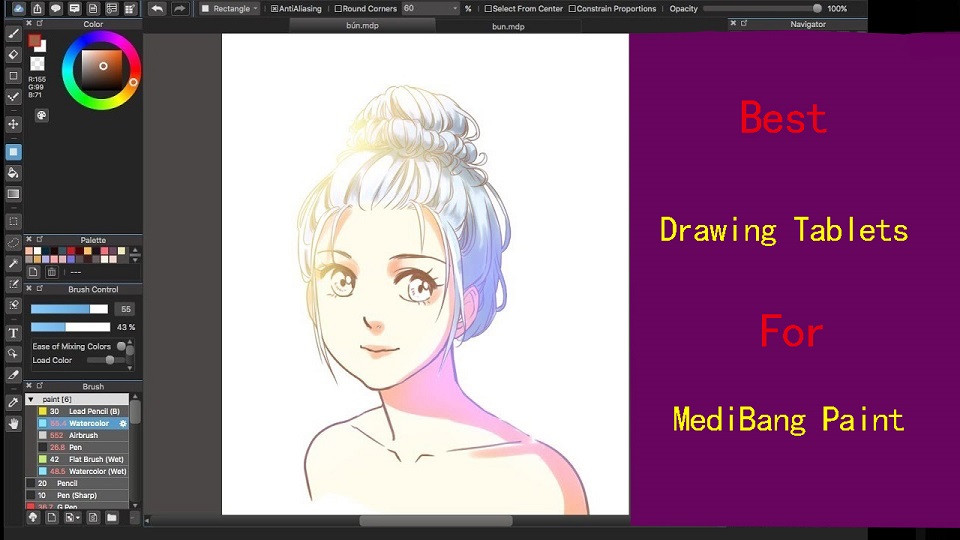
MediBang Paint Pro is a free lightweight digital painting program for illustrators and comic book artists.
MediBang Paint supports graphics tablets from popular brands such as Wacom. So you can use a pen tablet or display to draw directly in MediBang software.
Drawing tablet is a computer input device that enables a user to hand-draw images, animations and graphics, with a special pen-like stylus, similar to the way a person draws images with a pencil and paper.
If you work with a graphics tablet, you can control painting tools with pen pressure, or the angle. And that makes drawing in medibang very accurate and precise.
Choosing the best graphics tablets for MediBang Paint is not easy since we don't have to worry only about size or screen resolution but software compatibility, portability, price, and performance.
To help you buy the right one, pc tech test have drawn up a list of the best drawing tablets available today.
What types of drawing tablet to get for Medibang Paint?
There's 3 different kinds! drawing tablets without screen, drawing tablets with display, stabdalone drawing tablets.
The classic graphics tablet consists of two main parts: a flat surface that is mapped to your screen and a stylus. You look at your computer screen while drawing on the pen tablet. This takes a while to get used to.
Some have a highly sensitive LCD monitor upon which you can draw directly. so it's a bit more expensive but amongst the closest to pen on paper action.
Both of these need to be plugged in a computer or laptop to work.
Standalone pen tablets like ipads allow you to draw on the screen, without the need to plug it into another machine.
These are the most expensive, but the benefit is they're portable, set up is easy, and u can use em for other things.
Taking Medibang Paint to a New Level
Because the drawing tablet is operated with a pen, so it delivers more precision and control than a mouse that's optimized to work with Medibang Paint to speed workflow.
Tablets help a lot to people who suffer from carpal tunnel, They will always be more ergonomic, nature and comfortable to use than a mouse!
Tablets are absolute positioning devices, so all you have to do is just place your pen on the device's surface and your cursor position will be mapped precisely to your screen.
Pressure and tilt sensitivity are two amazing features that most good graphics tablets have that allow for perfect translation of pressure and tilt movements from your pen to your artwork.
By applying more pressure to your graphics tablet will result in wider brush strokes while putting less muscle into it will produce thinner strokes.
Most drawing tablets also offers customizable ExpressKeys, which can be assigned to application-specific settings of medibang paint, putting your favorite shortcuts at your fingertips.
What drawing tablet brands are good?
Wacom is still leading brand when it comes to drawing tablets. But good cheap rivals like XP-Pen and Huion are also worth considering.
Apple, Microsoft and Samsung, meanwhile, not only produce some of the best tablets in general, but ones that are increasingly good as drawing tablets too.
What graphics tablet size to get for Medibang Paint?
Drawing tablets come in different sizes, and the size you choose depends on your personal preference and the type of work you'll be doing.
Generally speaking, you'll want the graphic tablet size to be close to the size of your computer monitor.
The tablet surface is mapped to the whole screen. That means if you have a small drawing surface, everything you draw will be magnified much larger.
For medium size tablets, the difference of your tablet stroke and screen stroke is not as much, and hence it feels more natural to see your strokes come out the way they are on screen.
For large tablets, the difference is even less. They are great if you have a high budget, and these tend to be used by professional artists.
What drawing tablet is compatible with Medibang Paint?
MediBang is available for Windows, Mac OS X, Android, and iPad OS. So no matter what drawing tablet you get, it will work well with Medibang Paint.
Many similar posts: Graphics Tablets for Photoshop, Pen Tablets for illustrator, Drawing tablets for Krita, and etc
12 Best Drawing Tablets for Medibang Paint in 2023
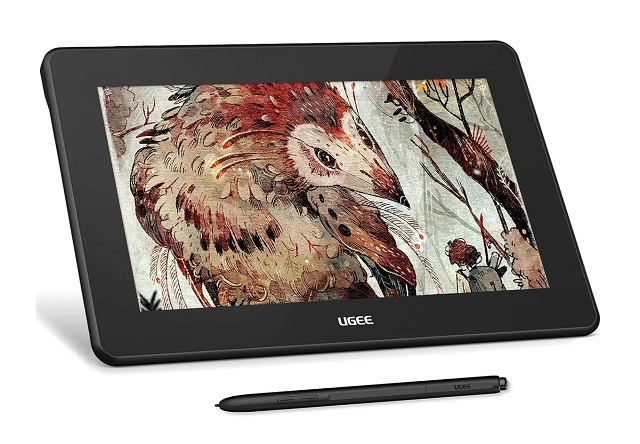
For our long research, we found the best tablets for Medibang Paint, which is suitable for animators, graphic designers, and any other artists. Let's discuss it.
1. Wacom Intuos
2. XP-Pen Deco 01 V2
3. Huion HS610
4. Wacom One 13
5. Huion Kamvas 13
6. XP-Pen Artist 16 (2nd Gen)
7. Ugee U1600
8. Huion Kamvas 22 Plus
9. XP-Pen Artist 24 Pro
10. iPad (10th gen)
11. Samsung Galaxy Tab S6 Lite
12. Surface Go 3
Conclusion
Anyone who has been working with MediBang for a long time will sooner or later consider purchasing a pen tablet for MediBang.
The choice of graphic tablet will depend on the individual's needs, budget, and preferences, as well as the type of work you will be doing.
From the above list of the 12 best tablets for Photoshop, you can choose one that meets your product specifications and budget.
If you need the portability, We can recommend you to use the surface, ipad and samsung galaxy tab cause they are really awesome standalone pen tablet.
If you are getting into the digital painting from a professional point of view, you should consider investing in a quality pen tablet that will make work easier and improve accuracy.
Source: https://pctechtest.com/best-drawing-tablets-for-medibang-paint
-
Wacom Intuos Pro vs XPPen Deco Pro Comparison
Freitag, 10. November 2023
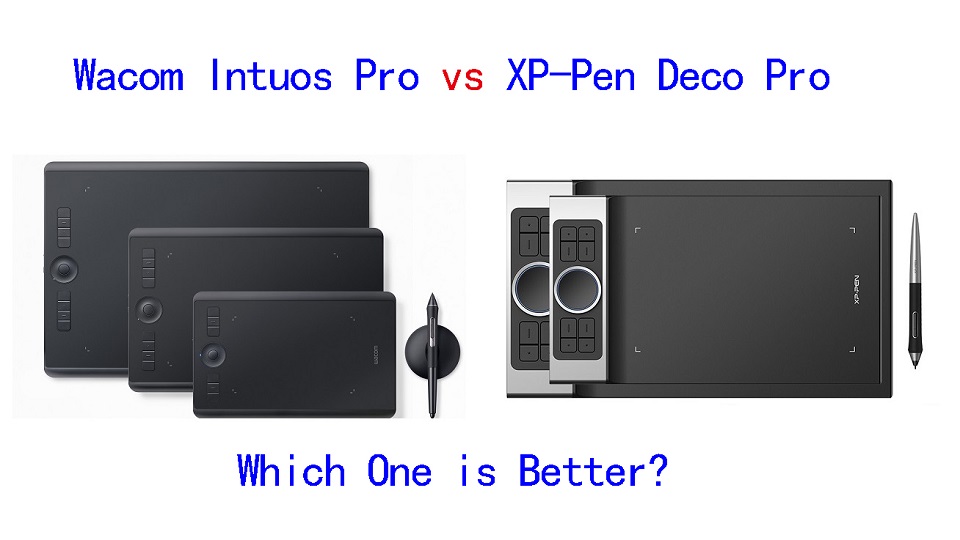
Whether you are doing photo editing, digital painting or 3D sculpting, having a professional tool is fundamental to fuel your creativity and productivity.
For the longest time, the Wacom Intuos Pro series was considered the pinnacle of screenless graphics tablets.
These offered the highest pressure sensitivity settings along with extra features such as wireless connectivity and touch support.
However, these tablets also tended to cost an arm and a leg. The justification for the pricing is that these products are targeted for professionals.
The Deco Pro is XP-Pen's high-end addition to their Deco series of screen-less tablets, which features a very sleek and unique design with Rich features.
It is made to compete with Wacom's Intuos Pro line while costing only as much as the low-end Intuos tablets.
Which one is better or more suitable for your needs? This article will help you understand the key distinctions between the two tablets and make the best decision possible.
Brand Comparison: Wacom vs XP-Pen
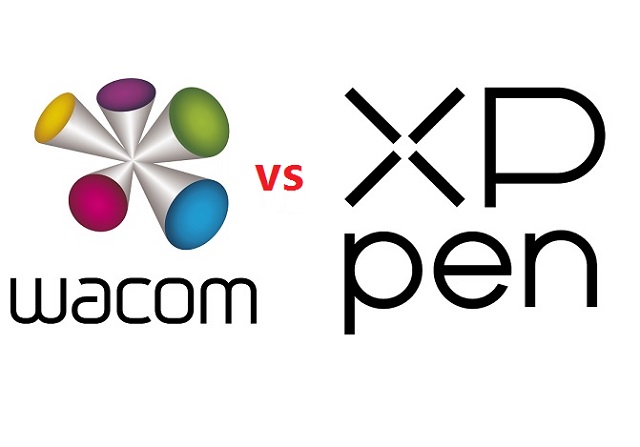
Wacom is more well-known and widely used because of its sturdy construction and widespread availability, plus it's an older brand which was established in Japan in 1983.
In the last couple of years Wacom has seen its grip on the entry level graphics tablet market loosening considerably.
Competitors like XP-Pen have artists who want to make their mark in the digital art world more choices in the tools that they can use.
XP-Pen tablets are generally cheaper than Wacom tablets and have more features.
If beginner artists wanted tools that were appropriate for their skill level, they could always get the XP-Pen tablets. This brand is also a budget tool for professionals.
Keep in mind that both of these corporations are successful and sell products that satisfy almost all their customers.
Features Comparison: Wacom Intuos Pro vs XP-Pen Deco Pro
So let's dive into the debate, Wacom Intuos Pro vs XP-Pen Deco Pro Comparison, Read on to find out…
Build Quality and Design
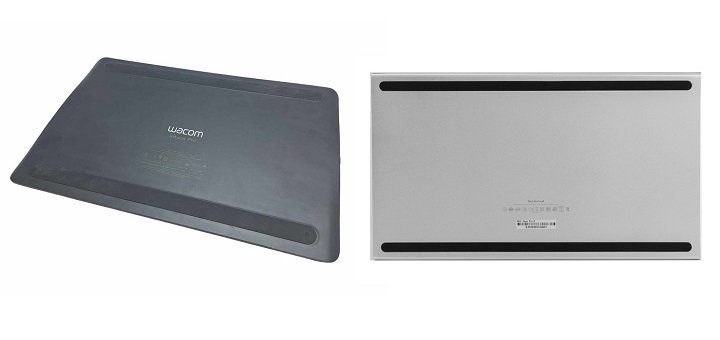
Wacom's build quality has always been stellar and this Intuos Pro is no exception.
The device is a sleek black, feels reassuringly strong even though it is only 8mm thick.. It has a sturdy anodized aluminum back panel, with a fiberglass composite resin shell on the front.
The XP-Pen Deco Pro has a rather unique design with its black plastic front and cool sliver aluminum base & dial. It is a nice looking tablet with solid build quality.
The device is extremely slim, with just 7 milimeters height on most areas, except on the side where the buttons are, where it reaches a 16.5 mm height.
The back of both tablets has two long rubber feet spanning the whole tablet for maximum stability, and the usual information sticker.
Compared to Wacom intuos pro tablet, the Deco Pro is much sleeker, thinner and more modern. It has won a few design awards, like the 2019 Reddot Design Award and the 2018 Good Design Award.
Wacom intuos pro tablet felt more heavy, which gave you a feeling of higher quality.
In additin, The edge of the Deco Pro tablet is a fairly sharp corner design, while the edge of intuos pro was slightly more rounded.
Active Area Size
The Wacom Intuos Pro comes in three different sizes: small version with 6.3 x 3.9 inches active area, medium version has 8.7 x 5.8 inhes while the large version offers 12.1 x 8.4 inches.
The Deco Pro is available in two sizes, small (9×5 inches working area) or medium (11 x 6 inches), but these should not be confused with Wacom's small and medium sizes as XP-Pen's small and medium sizes are much larger!
If you tend to work on a small monitor below 19 inches or a laptop, you should be just fine with the small version of wacom intuos pro. It should be enough.
If you really need a tablet with a larger drawing surface, the savings you would make on the XP-Pen Deco tablets far outweigh any advantage you would get by opting for the doubly priced medium sized Wacom Intuos Pro tablet.
Surface Texture
The surface of intuos pro is rough, meaning you get a good degree of friction as you sketch. This gives it that paper feel, plus it helps to control your stylus.
In actual use, the Wacom Intuos Pro works very well. But the friction/resistance on the surface eats down the nibs very fast.
The surface of Deco pro also has a slight grain to it, but it's smoother than the wacom, and after weeks nibs didnt wear down much.
It's worth noting that if you don't like the default surface, Wacom sells different overlays with smoother or rougher surfaces you can apply to the tablet. The packaging includes a sampler sheet of the surface options.
Shortcut Buttons
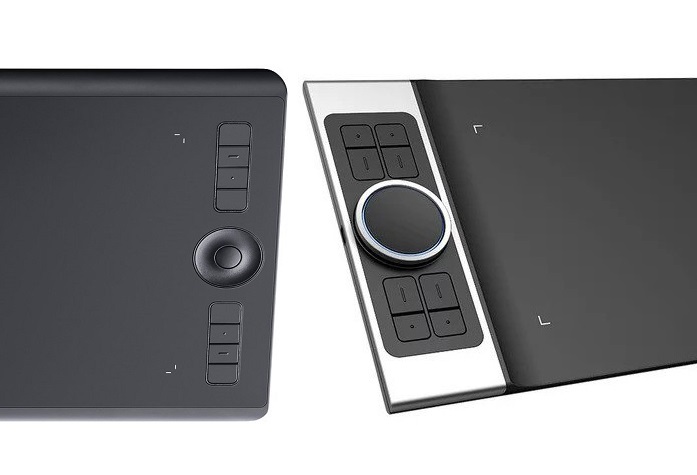
Both tablets had lots of macro buttons and a scroll wheel. You can program them to do all sorts of stuff, it's cool.
On the xp-pen you have eight shortcut keys and the innovative double wheel.
"double wheel" means that you can turn the outside rim of the dial (the mechanical wheel) and assign that to one function such as zoom in & out, or increase & decrease the brush size, etc.
And additionally you can use the inner or "virtual wheel", which is the circumference of the touch sensitive trackpad, assigned to something completely different, such as rotating the workspace, scrolling, etc.
On the wacom you have 6 to 8 shortcut buttons and a touch ring, which can help you resize the brushes quickly, it can also be used to zoom in & out, or to rotate your canvas.
The button in the middle of wheel is only for switching the function of the wheel and nothing else.
Stylus Pen
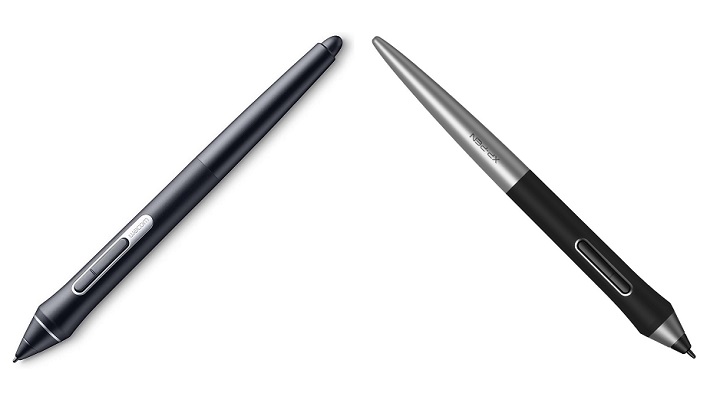
Wacom Intuos Pro tablet comes with the most precise stylus - Pro pen 2, which is battery-free, supports 8192 pressure levels and tilt sensitivity.
It has a semi-hard/semi-soft rubber grip with two side buttons and a pen eraser on the end. Holding this pen is very comfortable.
The XP-Pen Deco Pro tablet has a PA1 battery-free stylus with 8192 pressure levels and Tilt recognition.
It features 2 buttons, a semi-hard/semi-soft rubber grip with silver plastic for much of the rest of the pen. It is quite light but doesn't feel unbalanced.
The advantage of going with a greater number of 8192 pressure levels is that it enables you to make finer distinctions in the thickness of the lines, which is essential when working on high-resolution drawings.
Tilt sensitivity means that the tablet can detect the inclination angle of the stylus and change the brush stroke to achieve a more natural and realistic feeling. This is great for shading but has many more applications.
The wacom has the slight edge with pen handling over the xp-pen, it's pressure sensitivity is more natural and needs less force to draw.
In addition, Wacom's pen tilt is fast, precise, and doesn't change directions when you press the pens macro keys. It's completely smooth.
XP-Pen's tilt was slower by comparison to the wacom, and it jittered around a bit and changed directions when you pressed the macro keys on the pen. It's not precise enough.
Multi-Touch Support
The XP-Pen Deco Pro does not support and touch gestures, and will not recognize your fingers – it will only recognize the stylus.
The Intuos Pro has multi-touch and gesture support, which is incredibly useful. so you can use phone gestures on your tablet with your fingers.
You can customize some of these, so tapping four fingers might open a menu, while tapping three might open a new window, and pinching zooms in and out on an image.
If you don't like it, you can easily disable this feature from the side of the tablet.
Compatibility
The Wacom Intuos Pro offers excellent Windows and Mac compatibility.
The Deco Pro isn't just built to work on both Windows and Mac computers, it can also be connected to an Android device so you can paint and sketch on your phone or tablet.
Connectivity
Wacom includes a USB-C to USB Type-A cable, with the USB-C end plugging into the tablet for charging.
XP-Pen contains the USB-C to USB-A cable to connect the tablet to your laptop. it also has 2 adapters: USB-A to USB-C and USB-A to Micro-USB.
The Deco Pro tablet will support a USB-C to USB-C connector cable but it doesn't come with the cable.
Bluetooth Wireless is standard on the Intuos Pro and is optional on the XP-Pen Deco Pro.
Although you can get a cheaper version of the Deco Pro without Bluetooth, this is not recommended as the hassle from having extra wires is just not worth the small cost saving.
Drivers
To setup the tablet with a PC or Mac, all you need to do is connect it to your computer and then download and install the drivers.
The XP-Pen driver have a nice interface, letting you change active area size, pressure sensitivity, customize shortcut keys, etc. The actual driver software itself is quite simple and gets the job done.
Comparing it to the Wacom driver, it's very similar, maybe the Wacom app would win in the comparison as it has more features.
In addition, Wacom's driver software is notably simpler, convenient to update and install than that of the XP-Pen.
Accessories
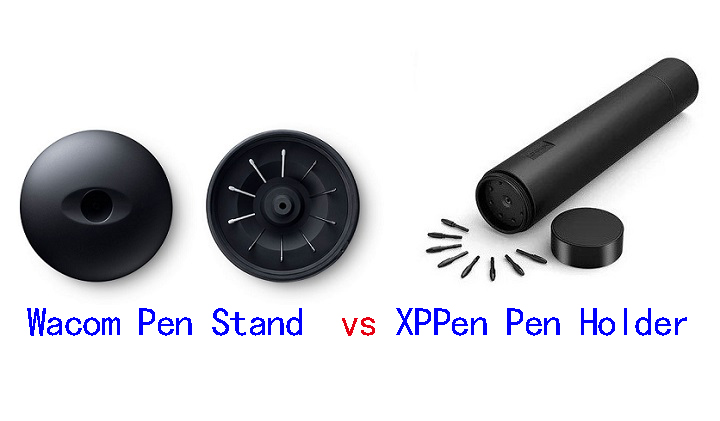
Despite being cheaper than the Intuos Pro, the XP-Pen Deco Pro comes with more accessories, such as extra black artist drawing glove, 2 adpaters, etc.
XP-Pen Deco pro comes with 8 nibs in total, all of which are of the same hard plastic design.
Wacom Intuos Pro has ten nibs, including four felt nibs which are similar to using paint brushes or pastels.
Additionally, the Deco Pro comes with a pen holder, while the Intuos Pro has a pen stand.
The weighted pen stand of wacom has a screw-in bottom and when you unscrew the piece, you will find a variety of 10 different pen tips.
To remove the included pen tip, there's a small hole on the bottom of the pen stand which you can use to easily remove the pen tip.
The pen case of xp-pen is a tube which holds the pen safely inside during transportation.
Both ends can be unscrewed, with the lid on one end acting as a pen stand, and the other end holding the pen nib replacements and the pen nib remover.
Bonus Software
When you purchase Deco Pro, and register it on the XP-Pen website, you get a choice of two software options for free. These are ArtRage 6 and openCanvas, and are for windows and Mac.
You can get a free 3-moth trial of Shapr3D and MASV, which comes with Wacom Intuos Pro purchase.
Luckily, there are many free drawing, photo editing, animation and whiteboard programs available, so you can use a pen tablet for online teaching, a graphic tablet for annotating pdf and etc.
Price
XP-Pen Deco pro is priced affordably and within reasonable, It is priced at $99.99 (Deco Pro Small), $129.99 (Deco Pro Medium), $129.99 (Deco Pro SW Bluetooth), $159.99 ( Deco Pro MW Bluetooth). Wacoms prices are more expensive, respectively $249.95 (Intuos Pro Small), $379.95 (Intuos Pro Medium), $499.95 (Intuos Pro Large).
Conclusion
Looking at the balance between specs and cost, we believe Either tablet will be a perfectly good buy. Which one you get really depends on your art style and preferences.
XP-Pen deco Pro series is known for its best value for money. Wacom Intuos Pro series is quite costly but they have a great experience and smooth user interface.
If you're a professional who is looking to invest in a tablet for multimedia manipulation, I will highly recommend Wacom's line of Intuos Pro tablets.
Wacom Intuos Pro tablet is known to be free from pen lag and extremely accurate. It's worth it's weight on gold for the time savings and increased accuracy.
If you're simply a consumer who is looking to utilize a tablet for recreational use, you'll likely be better off saving some money and choosing to one of the XP-Pen Deco Pro tablets.
The affordable price point of this means you could start on this as a beginner and really grow into it over time as you improve.
Source: https://pctechtest.com/wacom-intuos-pro-vs-xppen-deco-pro
-
Wacom Cintiq 22 vs Huion Kamvas 22 Plus Comparison
Samstag, 4. November 2023
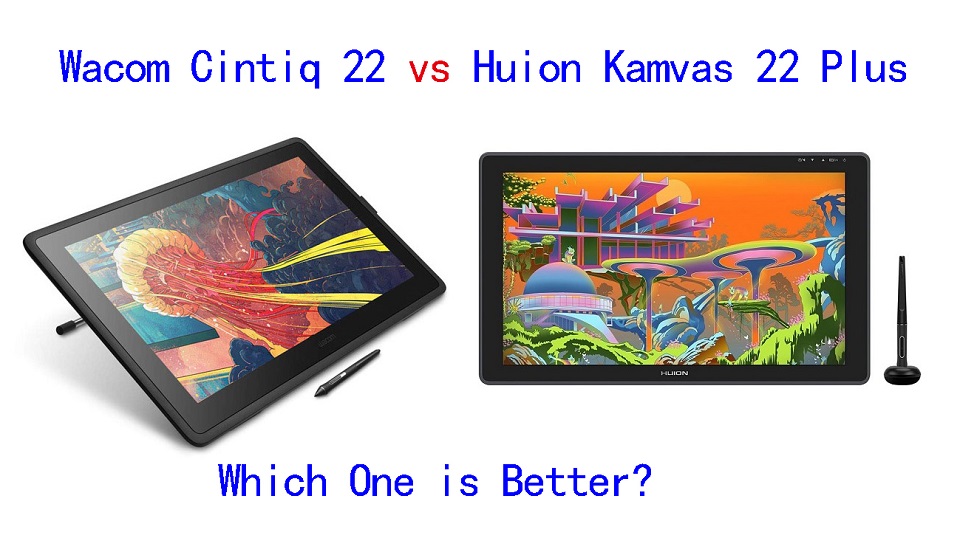
If you're not new to the digital art world, you're probably already aware that graphic tablet with display is a good tool for an artist.
These display tablets are unbelievably cool, allowing you to use a stylus and work directly on your artwork. Even traditional artists are surprised by how easy, nature, accurate and intuitive the process is for them.
Compared to sizes of 15.6-inch or smaller, the 22-inch gives you a physically larger drawing area that allows you to create more lengthy pen strokes and more comfortable arm movements as you draw.
If you are looking for a quality 22-inch pen display that has all the necessary drawing features you need while still being very economical, the Wacom Cintiq 22 and the Huion Kamvas 22 Plus are the two best and most popular choices.
One may be wondering which one of the two to get. For the most part, both devices are similar, like screen size, resolution and pressure sensitivity, but there are some differences here and there.
Keen on one or the other? We compared Wacom Cintiq 22 vs Huion Kamvas 22 Plus, divided all pros and cons of each model, describe all features to help you find the best device.
Brand Comparison: Wacom VS Huion
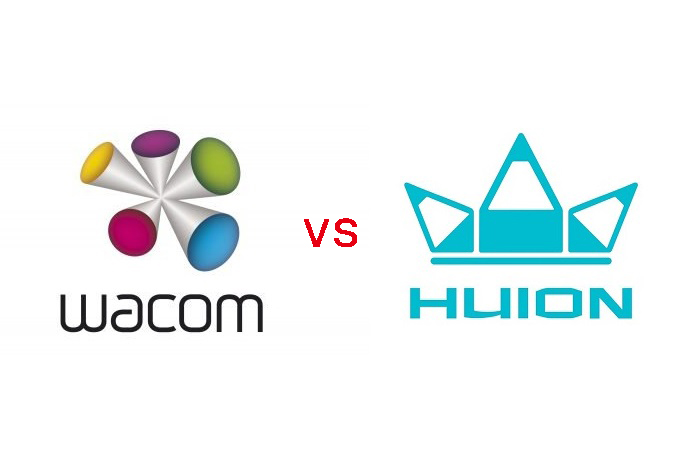
Wacom is the industry leader and standard. They have been producing high-quality drawing tablets for artists since its foundation in 1983.
If you weren't worried about price, you'd want a wacom and you wouldn't get remorse anyway because you'd own the best possible tablet.
On the other hand, Huion is a newcomer, founded on 2011. It is something of a market leader in terms of budget tablets, so there's plenty to cover.
Huion tablets are certainly becoming more and more popular. They are typically much cheaper than an “equivalent” Wacom and – on paper, at least – do the same things.
Features Comparison: Wacom Cintiq 16 vs Huion Kamvas Pro 16
For detailed information about Cintiq 22 vs Kamvas Plus 22comparison, you can find below:
Build Quality and Design
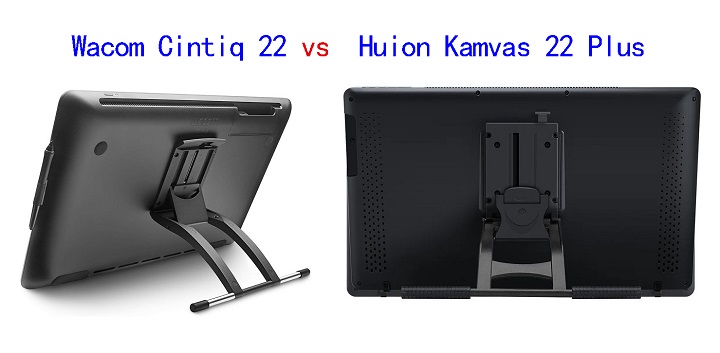
Huion and Wacom both take quite a minimalist approach with the design of their tablets.
If we compare the Huion Kamvas 22 Plus and the Wacom Cintiq 22, we'll see that both are mostly screen, without function buttons.
As for appearance, Both Tablets comes with a black plastic body, Build quality is solid and feels well made.
Both tablets also come with an adjustable stand that allows you to set it to your preferred height.
The Wacom stand offers angle adjustment from 16° to 82°, while the Huion stand provides angle adjustment of 20° to 80°.
In addition, With both devices, you can remove the stand to reveal a VESA mount, which gives you the option to mount an arm.
Both drawing tablets are big and bulky devices that are difficult to carry around.
But there is some significant difference in weight– the Huion Kamvas 22 Plus weighs 3.9kg including stand, while the Wacom Cintiq 22 weighs a considerably more hefty 5.9kg with its stand!
Screen Quality
Both devices offer the same screen size of 21.5-inch, as well as the same 1920 X 1080-pixel resolution.
We must say that these specifications perhaps have room for upgrades such as 2.5K or 4K resolution for a higher pixel density and clarity.
In terms of color gamut there is some significant difference – the Cintiq 22 features a color accuracy of 96% sRGB, while the Kamvas 22 Plus offers a hugely impressive 140% sRGB color gamut.
A wider color gamut will provide more accurate and vibrant colors, which is especially important for artists and designers who need to work with a wide range of colors.
This is down to Huion's new Quantum Dots Technology of QLED Panel, which also allows the tablet to boast a hugely impressive 1200:1 contrast ratio, while Cintiq 22 has an IPS panel with 1000:1 contrast ratio.
Since Wacom Cintiq display is calibrated out of the box, so the colors looks accurate. As for Huion Kamvas, it has a relatively inaccurate color calibration out of the box.
However, you can always manually tweak the colors by going through the OSD options of Huion. And If you're willing to do a bit of color calibration on setup, it's absolutely class-leading.
Screen Technology
Cintiq 22's screen is not laminated, which is cheaper to manufacture. Because there is a gap between the active screen and its top layer, this creates a parallax issue.
Kamvas 22 Plus has full lamination screen, which reduces the air gap, the parallax is minimal, resulting in a lag-free drawing experience.
Drawing Surface
The Kamvas 22 Plus uses etched glass on the screen, which is more scratch-resistant than the matte film that the Cintiq 22 uses.
Both type of textured screen is super nice and its really almost glare free and feels a bit rougher, somehwere in between glass and paper.
This texture helps give resistance against the pen while drawing to make it easier to control your strokes.
Stylus Pen
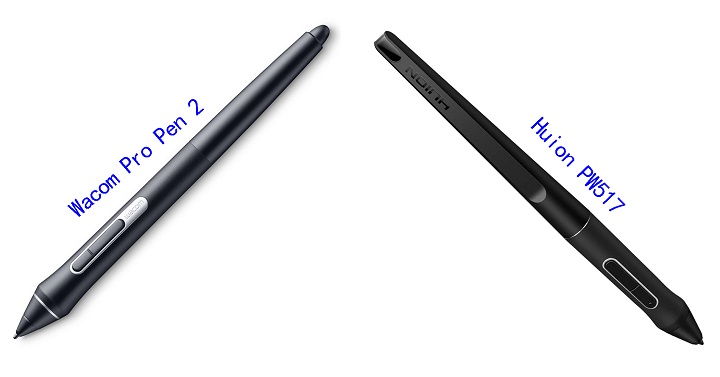
For the most part, the pens of the two devices are quite similar that is thickest on the area most proximal to the tip and tapers towards the other end.
They both have 2 customizable buttons, and a rubber grip for better and comfortable use. They are both battery-free, and requires no charging at all.
However, the wacom Pro Pen 2 that comes with Cintiq 22 has an extra eraser on the top end, which allows you to switch to the eraser tool the same way you could do with regular pencils.
On paper the two pens are very similar. Both Wacom and Huion PW517 stylus boast 8,192 levels of pressure sensitivity and ±60° tilt detection. This assures excellent accuracy in making manual inputs.
However, and with the caveat that this is subjective, the Wacom stylus still just feels better in use, with a smoother action in the hand.
Wacom Pro Pen 2 has a lower initial activation force where it better detects the lighter pressure! Much better than Huion stylus, The tracking is impeccable, no jitter at all.
Programmable Buttons

As mentioned above, neither the Cintiq 22 nor the Kamvas 22 plus comes with programmable shortcut buttons.
If you are someone who uses a keyboard for in-application shortcuts, this is not really a big deal .
If you want button control, you can pick up a Wacom Expresskey Remote for the Cintiq 22, which gives you 17 programmable buttons and a touch ring.
It connects wirelessly via 2.4Ghz to the computer and can work for around 160 hours on 2 hours of full charge.
The Kamvas 22 Plus also have a comparable accessory, the Keydial Mini K20, which includes 18 programmable buttons and a mechanical dial.
It feature with the Bluetooth 5.0 wireless function, And Its 1200mAh battery ensures continuous working for about 100 hours.
Note that both Expresskey Remotes are not included in the box and needs to be purchased separately.
Connectivity
Both tablets are not a standalone drawing tablet, so they needs to be connected to a computer.
Cintiq 22 connects to a computer via 3 separate cables for power, USB, and HDMI connections.
The Kamvas 22 Plus comes with a somewhat interesting power cable which Huion calls the 3-in-1 cable.
The cable comes with a USB-A, HDMI, and a port for the power supply which all converge into a single USB-C input plug for your computer.
Another difference to the Cintiq 22 is the addition of a USB-C to USB-C cable so you can attach your compatible android phone or laptop.
Compatibility
The two devices in this comparison can work seamlessly with devices running on Windows, or macOS, and supports various mainstream drawing and designing software.
However, Wacom Cintiq 22 lacks the Android connectivity that Huion offers on its Kamvas 22 Plus tablet, so if you use Android devices, this is worth bearing in mind.
Drivers and Software
Before drawing on the screen, you need to download the drivers from their official website, install them and then you are good to go.
The tablet driver software interface will detect the pen display and open the available options for you.
Wacom drivers are more stable and a bit more “plug-and-play” in terms of setup, with more options to speed up and simplify your creative experience, including customizable pen gestures and on-screen pen and touch controls.
Huion drivers may encounter more issues, and not as well as wacom in quality. But it still allows you to adjust your personal preferences on pressure sensitivity, tilt, and button mapping, all of which required only a few minutes of effort.
Accessories
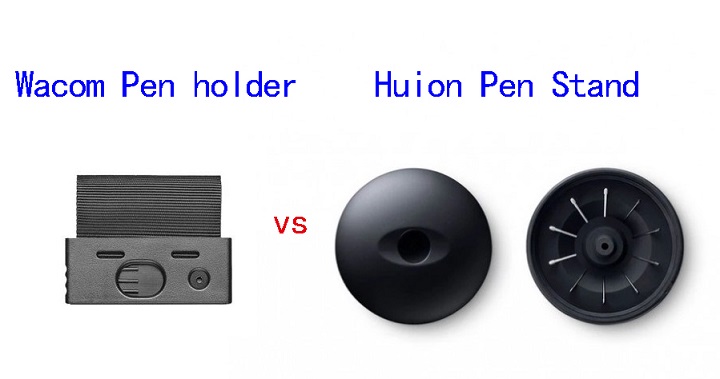
Despite being cheaper than the Cintiq 22, the Huion Kamvas 22 Plus comes with more accessories, such as extra black artist drawing glove, pen nibs, etc.
The Kamvas 22 Plus comes with a circular pen holder. It can hold your pen in an upright or flat position.
The pen holder also doubles up as nib storage, which houses 10 spare pen nibs. This can last you quite a while.
The Cintiq 22 comes with a simple fabric loop to hold the pen. The loop is attached to the side of the tablet. It also houses the 3 extra pen nibs.
Price
Price is one of the main reasons why so many artists are excited about the Huion Kamvas 22 Plus. It will cost you $549.00.
Compared to Kamvas 22 Plus, the Cintiq 22 is 1.2 times more expensive at $1299.95. But it still has the lowest price Wacom has ever offered for a drawing display of this size.
Additionally, If you can tolerate a non-laminated display, narrower 120% sRGB color gamut, a matte screen film instead of etched glass, then you can save extra $100 on Huion Kamvas 22 (basic, non plus version).
Conclusion
Both the Cintiq 22 and Kamvas 22 Plus are good drawing device for those who want a large screen at a budget-friendly price.
Wacom Cintiq 22 is more expensive, but still has the best pen and drawing experience. For most artists, Wacom's main feature is longevity and dependability.
But if your budget is tight, get a Huion Kamvas 22 Plus, It's more budget-friendly and offers great value for the price.
You won't go wrong with any of them, as they offer all you need to create good artworks. All depends on your levels of skill, preference, needs and budget.
Source: https://pctechtest.com/wacom-cintiq-22-vs-huion-kamvas-22-plus
-
Wacom Cintiq 16 vs Huion Kamvas Pro 16 Comparison
Mittwoch, 1. November 2023
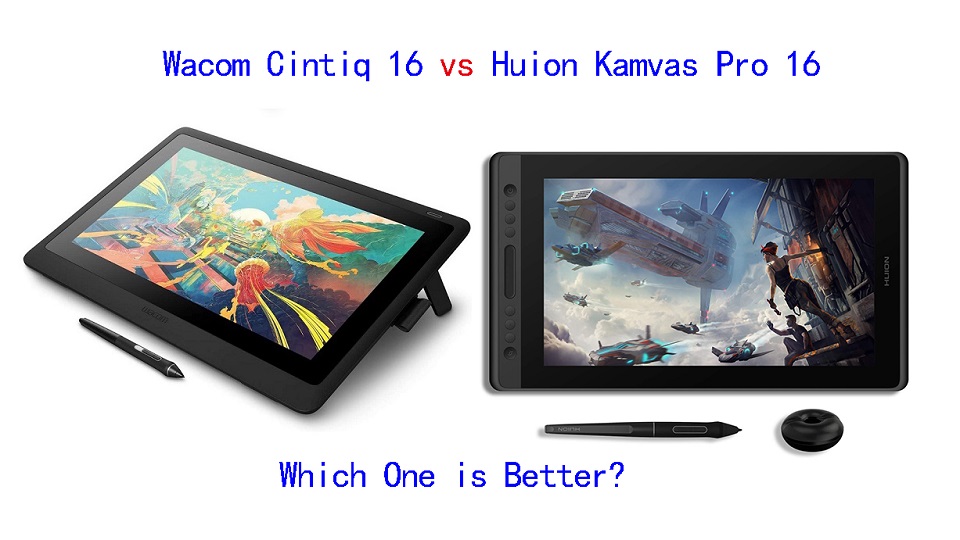
In today's digital age, finding the right tool that can meet multiple needs is crucial.
The graphic tablet with screen is objectively better in every concievable way over the non-screen versions, which feels more natural to traditional drawing.
15.6 inch is a popular size that gives you plenty of working space but without being too huge. It's still small enough to carry it around easily.
You might have seen the Wacom Cintiq 16 vs Huion Kamvas Pro 16. They are both budget-friendly mid-range display tablets that get fantastic reviews.
But which tablet is better? If you're a beginner, it is evident that choosing the right tablet between them will absolutely put you in turmoil.
This is where you'll require some advices that can guide you correctly. In this guide we place the two tablets side by side to compare and contrast their features, helping you decide which one is right for you.
Brand Comparison: Wacom vs Huion

Through the years, Wacom had been the main player in the field producing high-quality drawing tablets.
Huion came in later and started off with cheap drawing tablet options for beginner artists.
As years went by, Wacom also came up with beginner-centered drawing tablets that were cheaper and rookie friendly.
Huion on the other hand also grew to make high-quality professional devices that matched up to the high-quality standard set by Wacom.
Features Comparison: Wacom Cintiq16 vs Huion Kamvas Pro 16
Should you pay the extra money for Wacom Cintiq 16, or is the Huion Kamvas Pro 16 good enough? We have compared the two display tablets– including the display quality, parallax, stylus, drawing experience, and more.
Build Quality and Design
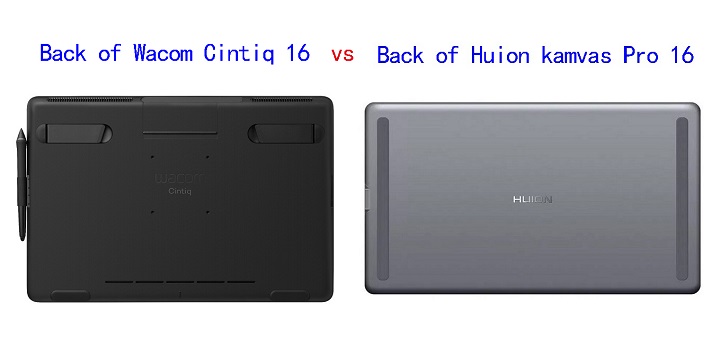
Huion Kamvas Pro 16 is a sleek looking device with an all black front with a shiny silver rim.
This tablet is made quite durably with premium feel. The back of the tablet is made of a silver aluminum alloy material which feels hard and cool to the touch.
Wacom Cintiq 16 is made of plastic, the overall build quality and polish impresses, it is very solid and the design is professional and clean.
Screen Quality
For drawing and photo editing, clarity and precision are key. Higher clarity allows you to see every detail on screen.
Also, you are going to want a color accurate display to ensure the colors you use are going to be colors you expect in the final product.
The tablet Wacom Cintiq 16 and Huion Kamvas 16 Pro comes with same screen size of 15.6-inch and reolution of 1920 x 1080-pixel. So they have same pixel density and clarity.
The screen of Huion Kamvas Pro 16 covers a wider colour gamut of 120%, While the Wacom Cintiq 16 only has 96% sRGB color support.
However, Wacom Cintiq 16 displays come pre-calibrated out of the box and show accurate colors right of the bat.
Kamvas Pro 16 is not precalibrated, the default calibration is somewhat off, a bit strong on the blues, but once you calibrate the display using a colorimeter, the colors displayed become very accurate and better as expected.
Screen Technology
Huion Kamvas Pro 16 comes with fully laminated screen, which have reduced the space between the glass and the screen, reducing parallax to almost zero and making drawing much more accurate in the process.
Wacom Cintiq 16 does not have a laminated display so you have some parallax, But It's worth noting that the parallax is minimal and less noticeable.
Drawing Surface
Wacom cintiq 16 have an anti-glare film applied to the glass surface, preventing any distracting reflections. The matte finish is also more pleasant and natural to draw on than the smooth glass.
It's glued more firmly onto the glass than a normal screen protector so it's tricky to remove it, you could also damage your screen if you use too much force.
Huion Kamvas Pro 16 comes with an etched glass surface with light texture. This gives it enough resistance to not feel like you're sliding around uncontrollably.
It doubles as an anti-glare texture to prevent too much glare from light reflecting off the screen.
This texture has been applied directly to the screen and is not a screen protector so you cannot take it off. Glass will last practically forever, whereas a plastic film wears down from use.
Stylus Pen

Both tablets come with a battery-free pen, so you don't need to worry about replacing the batteries often.
The wacom pro pen 2 and Huion PW507 stylus looks similar. They both have two side buttons, a soft rubber grip and same shape.
But wacom stylus has an eraser on the end that can be used just like a normal pencil eraser for a more intuitive, natural erasing motion.
️ Both pens have over 8,000 pressure levels, ensuring smooth transitions between thick and thin lines, as well as transparent and opaque paint.
Both pens also supports tilt functionality, measured at ±60°. This is great for those who like to use the stylus at an angle to get different effects in their artwork.
The difference here is that Wacom stylus comes with lower initial activation force, and better tracking + tilt accuracy, etc.
This means it better detects the lighter pressure, eradicates unnecessary lags, and the pointer will not shifts off-center.
Hotkeys
There are 6 programmable buttons and 1 touch bar along the side of the Huion Kamvas 16 Pro tablet. It allow for instant one-touch access to time-saving shortcuts in all your favorite creative applications.
The two bigger buttons at the top and bottom are unprogrammable with one of them being the power button, and the other being the function switch button (which doubles as the OSD settings button).
There are no express keys on this Cintiq 16 model and Wacom doesn't include the Express Key remote, but it is compatible.
The Wacom Expresskey Remote will give you 17 programmable buttons and a touch ring.
Accessories

Wacom Cintiq 16 comes with a detachable fabric loop, which is attached to a piece of plastic that slides and snaps into the side of the Cintiq 16. It also houses 3 standard replacement nibs and a nib removal tool.
With Huion Kamvas Pro 16, you get a pen stand, which allows you to keep your stylus in a horizontal or vertical position when not in use. Inside it, you'll find 10 replaceable nibs and a nib remover.
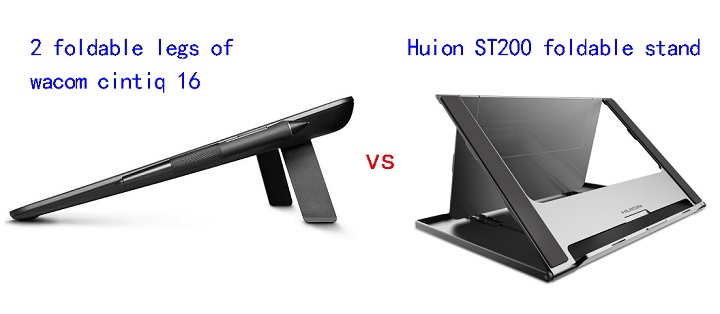
Wacom Cintiq 16 features VESA Support and 2 integrated foldable legs so you can go from almost flat to a 19° incline in seconds.
Kamvas Pro 16 comes with a Huion ST200 metal foldable stand, which offers six angle adjustments of 14.5, 19.5, 22.5, 37, 41.5 and 45 degrees to let you get the most comfortable angle possible for your hand. you will also get a drawing glove.
Connectivity
You can easily connect the Wacom Cintiq 16 and Huion Kamvas Pro 16 tablet with its Included 3-in-1 cable (USB-C to HDMI, USB-A and power) to your desktop.
In addition, Huion Kamvas Pro 16 also support a single USB-C to USB-C connection. This helps to avoid desk clutter and easily connect the tablet to your devices with USB-C port, but you need to buy the cable separately.
Compatibility
Huion Kamvas Pro 16 is compatible with Mac, Windows, and Android.
Wacom Cintiq 16 is only compatible with Windows and Mac devices.
So the Huion Kamvas beats the Cintiq for Android compatibility.
Drivers & Software
A tablet driver is a software program that allows a computer to communicate with a drawing tablet.
If you use your tablet without its drivers, the operating system will often see it as a mouse, rendering most of its features useless.
With the drivers installed, there will be a bridge between the two, letting the OS know how it should react when the tablet is used in a certain way.
The drivers also come with a handy user interface trough which you can change your tablet's settings.
Wacom is well known for providing stable drivers for all operating systems. Huion's software quality, the driver and configuration app can be lacking.
Price
If you were to go to Amazon right now and buy both tablets, the Wacom Cintiq 16 would cost you $599.95 whereas the Huion Kamvas 16 Pro tablet would cost you $399.99.
The Kamvas 16 Pro is priced substantially lower than the Cintiq 16. If you get the newer Huion Kamvas 16 Pro version with higher 2.5k Resolution, then they will hover around the same price.
Conclusion
Looking to upgrade from pen-paper to creating projects directly on the screen? These are the best upgrade for professional artists/designers.
Both the Wacom Cintiq 16 and the Huion Kamvas 16 pro are excellent screen tablets for artists. Both products are reliable, high-quality, and have a great reputation.
Wacom Cintiq 16 is still the best in terms of the drawing experience.
Comparing strictly in terms of functionality and price—the value for money—Huion Kamvas Pro 16 appears to be a more advantageous choice than Wacom Cintiq 16. A great drawing tablet for animation, drawing, photo editing and more.
Which tablet you go for will depend on your individual preference, budget and need.
Source: https://pctechtest.com/wacom-cintiq-16-vs-huion-kamvas-pro-16
-
Best Pen tablets for ZBrush and Blender
Sonntag, 29. Oktober 2023
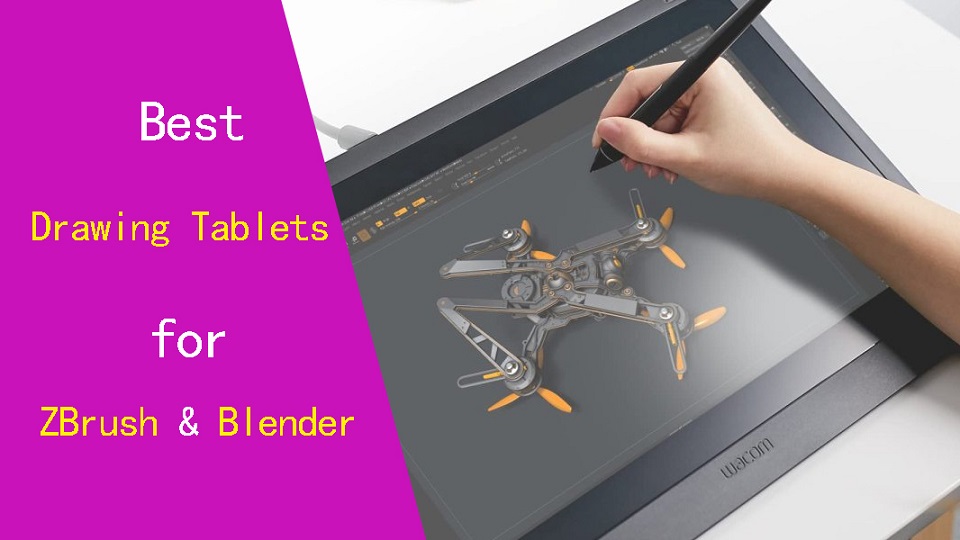
ZBrush and Blender are both 3D modeling programs that are popular among hobbyists, aspiring artists, and seasoned professionals, especially when it comes to sculpting.
Digital sculpting is a modeling method that tries to replicate the real thing: It starts with a ball of “clay”, and using brushes, you can pinch it, smooth it, divide it, and so on. It's mainly used for character creation and organic modeling.
Whether you're a beginner entering the world of 3D art or a professional in the field, ou may have considered purchasing a graphic tablet to streamline your workflow.
Graphic tablets offer a level of sensitivity and control you rarely get from a mouse, especially when used for sculpting and texturing in ZBrush or Blender.
The right graphic tablet can help you unleash your ZBrush or Blender skills to your full potential.
Hwever, With so many options available in the market, it can be challenging to determine which drawing tablet for 3D Modeling and Sculpting in ZBrush and Blender.
Fear not, This guide from pctechtest will help you choose the best tablet for your needs and budget.
Blender Vs ZBrush: Which one is better for sculpting?
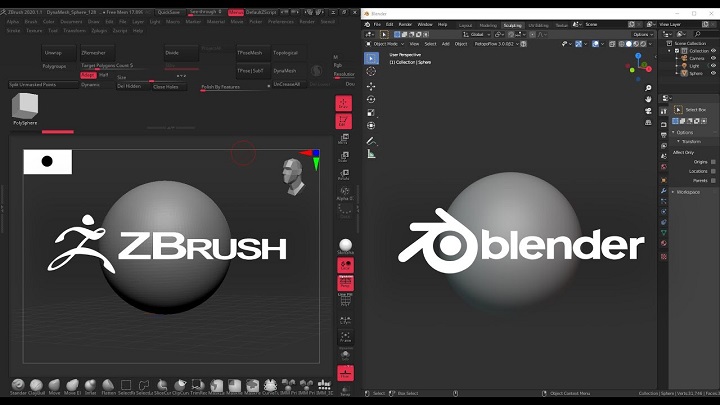
ZBrush is a premium software that is specifically designed for sculpting and has a reputation for being the industry standard for digital sculpting.
Blender, on the other hand, is a more versatile program that can be used for 3D modeling, animation, and even video editing. It offers a range of modeling tools, including sculpting.
Blender is free to use, while ZBrush costs money. This can be a major consideration for some people, as free software is always appealing.
When it comes to sculpting, ZBrush is the clear winner in terms of its powerful and intuitive sculpting tools. ZBrush offers an extensive range of brushes and tools that allow you to create intricate and detailed models with ease.
The program also offers features such as DynaMesh, which automatically creates a mesh with uniform polygons as you sculpt, and ZRemesher, which automatically retopologizes your models for optimal performance.
Blender, on the other hand, offers a decent set of sculpting tools that can be great for basic box modeling and low poly modeling.
However, the program lacks the more advanced features that ZBrush offers, such as the ability to sculpt with layers and the ability to create and manipulate UV maps.
ZBrush is better suited for modeling intricate details, while Blender is better for more general modeling.
If you have budget and are serious about sculpting, or organic sculpting, or you're not worried about poly counts then Zbrush is a good one for mainly detailed character Sculpting of any type.
However, if you're just starting out or don't have the budget for a premium software, Blender can still offer a decent sculpting experience.
The Graphics Tablet: What is it and types?
Graphics tablet is a device comes with a flat surface and a stylus pen, which works like a mouse. But you can draw on it, because the surface is touch-sensitive.
The tablet is connected to a computer or mobile device, which allows the artist to see their creations in real-time on their screen as they draw on the tablet.
There are screen based graphics tablet too. Its just a monitor with pen on which you can draw, However its more expensive.
Why Use a Drawing Tablet for ZBrush and Blender?
The stylus is generally much easier and more comfortable to hold in your hand than a mouse, and it allow for more precise control and accuracy when drawing.
If you've ever worked with a 3D modeling software like ZBrush or Blender you know that you spend a lot of your time looking at the character model and moving its body parts around.
Doing that with a pen feels so much more natural than a mouse, it's like touching the model with you hands. You get more precise with your tweaking and you move around incredibly faster.
In addition, The stylus pen's flexible design allows you to change the steepness of the angle of where your hand and thumb rest, greatly reducing RSI or carpal tunnel syndrome.
With a stylus pen, artists can draw clear lines and shapes, add color, change from line to shading, and much more with ease.
The pressure sensitivity allows for control over the thickness and opacity of the lines. This allows artists to mimic the physical process of sculpting with sculpting materials.
By applying more pressure, the digital tool in ZBrush and Blender can create deeper and wider marks, simulating the effect of pushing harder on a physical sculpting medium.
Plus, with all the extra programmable buttons of drawing tablet, it is much quicker and way more efficient to use within ZBrush or Blender as well.
Which drawing tablet should you use?
Choosing the right Graphic tablet for ZBrush and Blender is crucial to ensure a smooth and productive workflow.
And to do that, you will have to consider various important factors for a drawing tablet such as types, size, stylus performance, compatibility, customization options, pressure sensitivity, price, etc.
Smaller tablets are much cheaper and more portable, but Using a larger drawing area makes the whole creative process more comfortable and it considerably speeds up workflow.
Pressure sensitivity determines how responsive the drawing tablet is to the amount of pressure applied with the stylus. Higher pressure sensitivity allows more control over line thickness and opacity, providing a more natural drawing experience.
ZBrush and Blender runs on Windows and Mac OS, while Blender also supports Linux platform. Luckily, All drawing tablets on the market offers great compatibility with Windows and Mac. But you can't use an iPad or Android tablet like samsung galaxy tab with ZBrush and Blender.
As a beginner, graphics tablets without screen like the Wacom Intuos, Huion inspiroy, and XP-Pen Deco can serve you well. We suggest starting with this to get started to see if sculpting is really for you.
As you progress, you might consider investing in a professional-grade tablet with screen like the Wacom Cintiq, Huion Kamvas or XP-Pen Artist. You can have a Intuitive and natural drawing experience similar to drawing with pen and paper.
10 Best Drawing Tablets for ZBrush and Blender in 2023
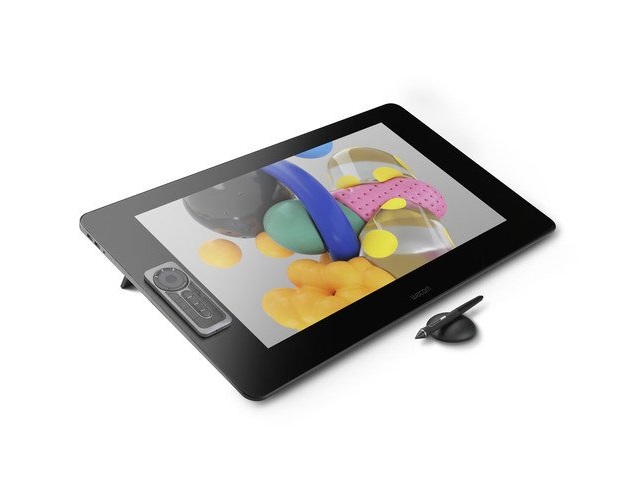
What are the best tablets for ZBrush and Blender these days? We have carefully selected these options based on reviews from professionals as well as the factors we have discussed above.
1. Wacom Intuos Pro
2. XP-Pen Deco 01 V2
3. Huion Kamvas 16 Pro
4. XP-Pen Artist 16 (2nd Gen)
5. Wacom Cintiq 16
6. Huion Kamvas 22 Plus
7. Wacom Cintiq 24 Pro
8. Huion Kamvas 24 Pro
9. XP-Pen Artist 24 Pro
10. Surface Pro 9
In Conclusion
A drawing tablet can help you create 3D models that require precision and accuracy, making it an excellent tool for assisting you with this art form
A good drawing tablet can be extremely beneficial to both beginners and professionals, regardless of their level of skill.
So if you want to create amazing 3D art in ZBrush or Blender, you should consider purchasing a high-quality tablet.
In this guide, we have picked out the 10 best graphic tablets for ZBrush and Blender available out there so that you can quickly choose an option.
Your choice of tablet should depend on your level of experience, preference, and budget.
Surce: https://pctechtest.com/best-drawing-tablets-for-zbrush-and-blender
-
Cheap Best Graphics Tablets with Screen for Beginners
Freitag, 27. Oktober 2023
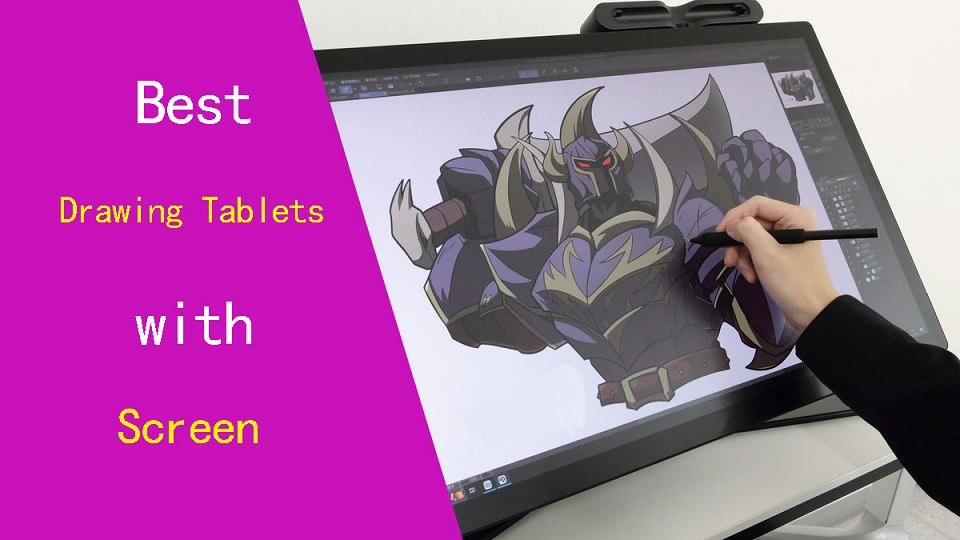
A drawing tablet with screen is a device that allows artists to draw directly on a screen using a digital pen or stylus.
They offer a more natural and intuitive way to interact with digital content than a standard graphics tablet. You won't need to switch between your drawing surface and computer screen anymore.
They're often pricier but tend to be more comfortable and efficient for artists who do a lot of digital work.
If you're an artist or graphic designer who is looking to take your creative skills to the next level, then a drawing tablet with screen could be the perfect tool for you.
How can you find the right drawing tablet with screen for your needs and budget? With a plethora of options available, this choice can be a bit overpowering.
To save you the headache of doing your own research, we've gone through the dozens of options and picked out the best for all levels and budget.
How to choose the best drawing tablet with a screen?
Choosing the best drawing tablet with screen for your creative needs requires careful consideration of pressure sensitivity, display quality, stylus responsiveness, compatibility, portability, and more.
This how to choose drawing tablet guide is an excellent place to start if you've never bought a tablet before, and if you're looking to make a list of the most important features before you buy.
1. Types of Tablet
Regular drawing tablets with screen, like wacom cintiq need to connect with a computer to function. Because It's basically a monitor you can draw on.
This type of screen tablet is less portable, but if you are planning to go for a larger screen size with more express keys, then they may be suitable for you.
On the other hand, Standalone screen tablets, like ipad pro, are self-sufficient and can function independently without the need of connecting to a computer.
They have everything packed into one – Hardware (processor, RAM, storage, screen, etc.), stylus and OS (the apps), making it an independent and portable device.
If you commute with your drawing tablet frequently or work on the go a lot, you will appreciate the standalone tablet type.
2. Screen Size and Resolution
A bigger screen will enable you to work on larger drawings more comfortable without the need for zooming and panning, but it is also more expensive.
A smaller tablet may be more portable and affordable, but it can also be more cramped to draw on for extended periods.
So the screen should be big enough to accommodate all the tools and also provide a sufficient area for sketching and designing.
Also pay attention to the display's resolution, A higher resolution will provide more clarity and sharpness, making it easier to read text and view images.
In addition, Size correlates to pixel density. Basically, smaller screen at a higher resolution means higher pixel density, and higher pixel density means sharper image.
3. Color Gamut
The color gamut represents the range of colors visible to the human eye on display monitor. The wider the color gamut range is, the richer the screen colors are.
There are a few formats accepted in industry as standards, including but not limited to sRGB, Adobe RGB, NTSC, DCI-P3, etc.
It is often represented by a percentage; the higher the percentage, the bigger the color range that can be displayed.
4. Screen Panel: IPS VS OLED Display
The screen panel for digital art can be roughly divided into two categories: Liquid crystal screen (LCD) category (which IPS is a type of) and self-luminous category (OLED display).
OLED is emerging as a superior choice for creatives. It's not only more color accurate and has deeper blacks than its LCD counterparts, and have better response times.
IPS is still favored because it offers a large viewing range of 178 degrees, a good color accuracy and the best thing, affordable price. OLED is still more costly than IPS panel.
4. Laminated vs Non-Laminated Screen
Using a drawing tablet with a screen built-in means you'll be able to see exactly where the strokes appear on the screen underneath the stylus pen, also known as parallax.
Parallax can be average on older non-laminated screen models. The only thing to reduce parallax on most these models is to calibrate the pen a few times until it is reduced.
Luckily, Full lamination technology eliminates the air gap that exists between the screen and the touch sensor.
It reduces parallax to a minimum, so your pen cursor appears exactly where you expect it to be, even at the edges.
Glossy screen has better color accuracy reproduction and can produce higher brightness than matte display given identical backlight panel. But it is shiny, reflective and difficult to see in direct strong light.
Matte screen has a coating that reduces reflections and isn't shiny. It also can give little more resistance, feels more like paper, that makes the drawing experience far better. But it gives off a duller, more subtle finish.
Glossy is technically better image, but with the drawbacks most people end up preferring matte, especially on a draw-oriented device.
6. Pressure and Tilt Sensitivity
Pressure sensitivity refers to the pen's ability to recognize how much pressure is being applied. A pen with high levels of pressure like 8192 pressure levels, will be able to recognize the pressure applied much more accurately and responsively compared to lower pressure levels.
The maximum you can go for currently is 8192 levels of pressure sensitivity, however depending on your budget 4096 levels are also good. You won't notice much difference until later on when you're doing more high-level artwork.
Tilt Sensitivity refers to the ability of the pen to create special effects when tilted, simulating the real-life effect (shade) of using the side of a traditional drawing tool. It's also crucial for digital drawing as it enhances the overall drawing experience.
7. Stylus
Stylus (pens) come in two varieties: battery-powered (AES) and electromagnetic resonance (EMR), but both are intended to simulate the feel of a pen on paper.
EMR styluses, like waccom, Huion and XP-Pen uses, has no battery and does not need to be charged. They can be used whenever you want and for whatever period of time.
AES styluses, like apple pencil, surface pen, and samsung S Pen, are rechargeable. So you'll have to remember to charge it. You will also be limited to the battery life of the pen.
8. Connectivity
Wireless graphics tablets with screen are not available currently, unlike with the screenless tablets.
Most tablets require several cables to be connected (often 1 USB for pen data, 1 HDMI for video and 1 power to a wall socket), which can be a pain to connect.
Luckily, some newest models support connectivity via a full-featured USB Type-C cable, this eliminates cable clutter.
9. Compatibility
All screen tablets on the market offers great compatibility with most operating systems, including macOS and Windows.
You can even link it up to your Android or Chrome OS devices if necessary.
Standalone tablets come with different operating systems, most of them will ship with either iPad OS or Android (like samsung galaxy tab) and only very few will ship with Windows (Surface Pro though).
This also means that your drawing software choices will be limited by your OS, for instance you are not going to get fully featured desktop software going on iPad OS or Android.
So It is important to check the tablet's compatibility with your specific device and the software applications you plan to use it with before making a purchase.
10. Express keys
Programmable express keys on the screen drawing tablet can improve your drawing workflow, but this mostly depends on personal preferences.
For professional artists, it's great to have several express keys to quickly switch between multiple brushes and tools within their drawing programs.
If you're a beginner, you shouldn't stress too much on this as you could do well without many of these features.
11. Brands
The main player in this field is the Wacom brand. It offers a wide range of Cintiq screen tablets with great quality. If you are professional or money doesn't bother you, this could be your choice.
There are good alternatives and also cheaper solutions, like XP-Pen Artist or Huion kamvas.
If you like standalone tablet, then take a look at Apple iPad, Microsoft Surface and Samsung Galaxy Tab. All are big names.
12. Price
Generally speaking, the price of pen displays is determined by the resolution, size, stylus and other features. Nowadays, it's quite possible to find a good pen display around US $200.
Standalone tablets are the most expensive type of screen tablet, but they offer the most versatility and convenience.
12 Best Drawing tablets with screen in 2023
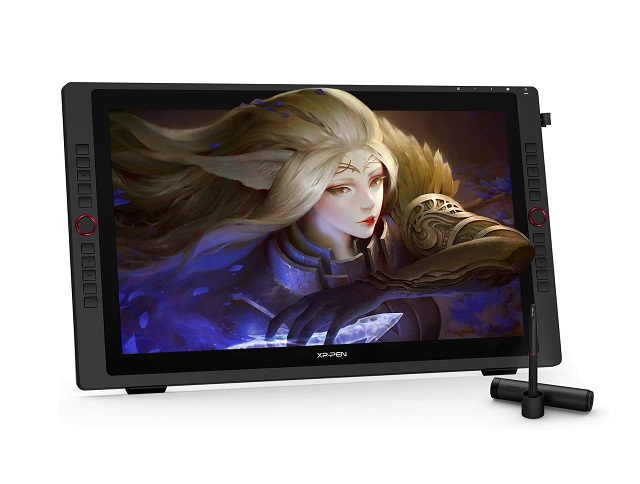
This list consists of the drawing tablets with built-in screen and are rated based on the types, features, and price point.
You can quickly compare all of the top tablets, and narrow down which one is right for you according to whether you want it for drawing, photo editing, or for something else.
1. XP-Pen Artist 12 (2nd Gen)
2. Wacom One 13
3. Ugee U1600
4. Huion Kamcas 16 Pro
5. Wacom Cintiq 16
6. Huion Kamvas 22 Plus
7. Wacom Cintiq pro 24
8. XP-Pen Artist 24 Pro
9. Huion Kamvas 24 Pro
10. iPad Pro
11. Samsung Galaxy Tab S9
12. Surface Pro 9
Conclusion
Drawing tablets with screen has become an essential tool for artists and designers who want to create digital art.
They can improve workflow, enhance creativity and the art of illustration while providing a more natural and intuitive experience for users.
In the list above, there are several high-quality options available, ranging from high-end models like the iPad Pro to more affordable options like the Wacom Cintiq, Huion Kamvas and the XP-Pen Artist.
Each of these tablets has its own unique features and benefits, so it's important to consider your needs and budget when choosing the right one for you.
Whether you're a professional artist or a budding hobbyist, one of these best tablets with screen is sure to suit your needs and will help you create stunning artwork.
Source: https://pctechtest.com/best-drawing-tablets-with-screen
-
Best Graphic Tablets for Corel Painter and CorelDraw
Mittwoch, 25. Oktober 2023
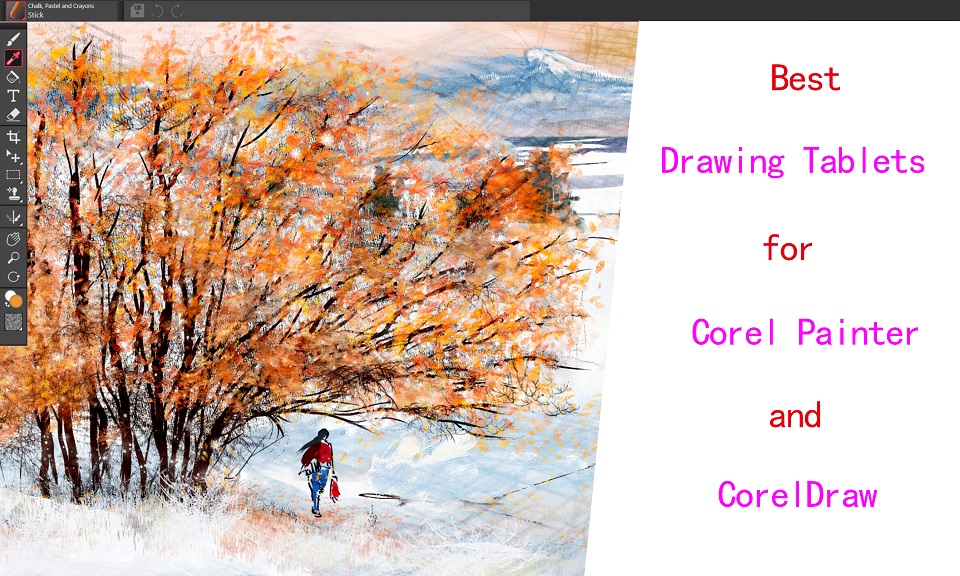
Corel Painter is a well-known digital painting software, while CorelDraw is a market-leading graphic design softwre. But in order to run smoothly, it needs the right device.
The graphics tablet is comprised of the drawing surface and the stylus. They have become an essential tool for artists, animators, photographer, graphic designers, and digital illustrators.
For them, This is a great way to produce many drafts and to be able to make changes, while being able to also directly digitise the image and edit it in various programs.
With a digital pen and powerful features, these devices allow unparalleled precision and flexibility in artwork creation.
Are you looking for the best drawing tablets for Corel Painter and CorelDraw? Whether that be for drawing, illustration or art, pctechtest have got you covered!
Corel Painter vs CorelDRAW: What is the Difference?
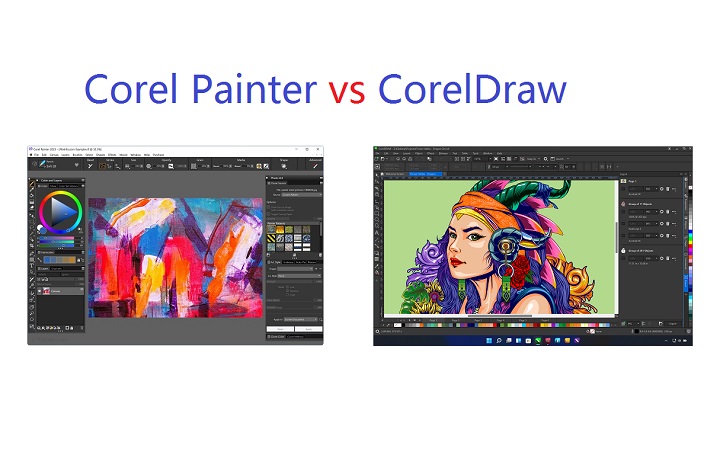
Corel Painter is built for digital painting, with all the features and tools needed for creating realistic digital artwork.
It has a robust painting engine, multi-layered brushes, cloning and photo-painting tools, and a drawing tablet compatibility that makes it very intuitive for painting.
It allow susers to make and edit raster based images or bitmaps like your JPGs, PNGs and BMPs among others… stuff made out of pixels. If you need a professional-level digital painting program, then Corel Painter is definitely the way to go.
CorelDRAW, on the other hand, is a vector-based graphic design software. It is a powerful and versatile application that provides a wide range of tools and features for creating, editing, and manipulating various types of visual content.
CorelDRAW is primarily used for graphic design and illustration purposes. It allows users to create and edit vector graphics, which are images defined by mathematical equations and can be scaled without losing quality.
This makes CorelDRAW suitable for designing logos, illustrations, posters, brochures, banners, and other printed or digital materials.
Advantages of using a Graphic Tablet for Corel Painter and CorelDraw
The graphic tablet allows you to draw with a pen or stylus, which feels more natural, easier and comfortable than using a mouse. This can be especially helpful for people who are used to drawing on paper.
graphic tablet allow more accurate control than a mouse, which makes it possible to do very detailed work.
A graphic tablet can be more ergonomic than using a mouse, as it allows you to keep your arm and wrist in a more natural position. This can help to reduce fatigue and pain.
When you use a pressure-sensitive stylus or pen tablet with Core Painter and CorelDRAW, the amount of pressure that you apply controls the width of your strokes.
Each person uses a different strength or pressure level in a stroke, and you can set the application to match your stroke strength by specifying pen settings.
Best of all, The brushes of Corel Painter and CorelDraw are built to take advantage of pressure and many also allow for tilt, rotation and bearing control so that you can create your ultimate art.
In addition, You'll also like that the Hotkeys on the side of the tablet can be customised to suit Corel Painter and Corel Draw so that you can work even more easily without having to use your keyboard.
Combine a drawing tablet with Corel Painter and CorelDraw's wide selection of brushes and features, like the bezier tool, It will fit all your digital art needs and take your digital art to the next level.
You're in for a treat when you get used to it; and when you start using the tablet for drawing in Corel Painter and CorelDraw software, you're going to start to wonder how you ever lived without it...
What Drawing Tablet Types is Best for Corel Painter and CorelDraw?
There are 3 types of drawing tablets available and which type you intend to get will drastically alter your required budget.
1. Graphics Tablets
The first type is called a graphics tablet. Usually, the tablet is interacted with a pressure sensitive pen with the surface of the tablet mapped to the display of the computer.
Notably, drawing pads for beginners are relatively inexpensive at less than $100 USD, and perfect for beginners. But there is a learning curve of feeling your position on the tablet with what you are seeing on your monitor.
The most popular such device at the moment for instance would be the wacom intuos, XP-Pen Deco, and Huion Inspiroy.
2. Display Tablets
The pen display tablet has an in-built screen so that you can just draw straight on the display. The learning curve is much less than the hand-eye disconnect experienced with a non-screen graphics tablet.
The obvious disadvantage of a display tablet is the increased cost which can exceed $200 USD. So you will need to decide how much you are willing to spend.
Display tablets come in a variety of sizes and display resolutions. But they still require a computer in order to function. You can think of it like an extra monitor that handles drawing on the screen.
The most popular such device at the moment for instance would be the Wacom Cintiq, XP-Pen Artist, and Huion Kamvas.
3. Standalone Tablets
Some mobile tablets come with pen input support and when they do you can usually buy an optional pressure sensitive stylus. Of course, they are usually the most expensive.
The most popular standalone portable graphic tablets at the moment for instance would be the iPad Pro + apple pencil, surface pro + slim pen 2, and samsung galaxy tab + s pen.
Compared to regular drawing tablets, they allows you to more easily draw digitally on the go, when you're out and about since these are highly portable devices.
These devices can come with different operating systems, most of them will ship with either iOS or Android and only very few will ship with Windows (Surface Pro though).
This also means that your drawing software choices will be limited by your OS, for instance you are not going to get full fledged corel painter and corelDraw going on iOS or Android.
In addition, These Mobile Android & iPad Painting Applications will never match up to their fully featured desktop counterparts.
10 Best Graphic Tablets for Corel Painter and CorelDraw in 2023
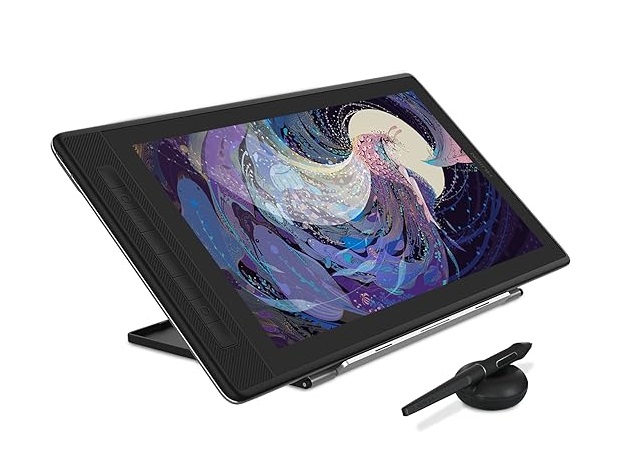
The drawing tablets for Corel Painter and CorelDraw do not differ based on the app- they typically work just as well in each software.
We've compiled this list of the best tablets for Corel Painter and CorelDraw based on various criteria. We've included such factors as screen size, resolution, color accuracy, pressure & tilt sensitivity, and price.
1. Wacom Intuos Pro
2. XP-Pen Deco Pro
3. Huion Inspiroy Dial 2
4. Wacom One 13
5. Huion Kamvas Pro 16
6. XP-Pen Artist 16 (2nd Gen)
7. Wacom Cintiq 16
8. Huion Kmavas 22 Plus
9. XP-Pen Artist 24 Pro
10. Microsoft Surface Pro 9
How to Use Pressure Sensitive Digital Pen in CorelDRAW?
The following tools in CorelDRAW let you use the pressure of your pressure-sensitive pen, stylus, or other device: Artistic Media (Expression mode), Eraser, Smear, Twirl, Attract, Repel, Roughen, and Smudge.
In addition, you can vary brushstrokes by using pen tilt and pen bearing with the Artistic Media (Expression mode) tool, Eraser , Roughen and Smudge tools. Note that pen tilt and pen bearing can be used only if your pen or stylus supports these features.
Conclusion
If you are drawing in Corel Painter and CorelDraw, we recommend that you take advantage of using a graphic tablet since with it, you will gain speed, precision, and comfort.
Almost any drawing tablet will be a massive improvement on trying to use something like Painter and CorelDraw with a mouse.
You should find the right tablet for you from this list! Whether you're looking for a graphics tablet, pen display, or a standalone tablet.
There are plenty of options out there for artists, It all boils down to what your preference, workflow, ecosystem, skill levels and budget are.
If you've got a small budget to start with, pick something cheaper from our list and start with that.
As you grow, you can upgrade to something a little more loaded with features. Happy drawing!
Source: https://pctechtest.com/best-drawing-tablets-for-corel-painter-and-coreldraw
-
iPad Pro vs Wacom Cintiq comparison
Dienstag, 24. Oktober 2023
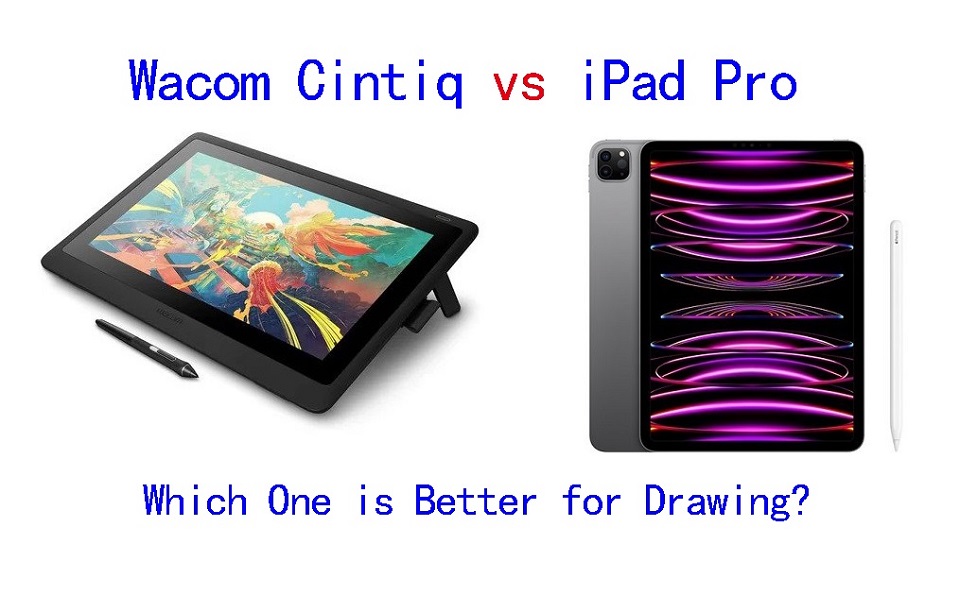
Are you an illustrator looking to get the iPad Pro or consider a Wacom Cintiq for digital art? They looks very similar and allows you to draw directly on the screen.
What is the difference between them? which one is better? what is the best one for you? This should be identified if your goal is to find the best fit for your digital art projects.
It can be tricky to choose between two really good options for beginners who started out in digital art. There are def pros and cons to each mode.
To help you avoid that, Pctechtest.com are covering the main differences so you can make an informed decision when picking between an iPad Pro or Wacom cintiq tablet.
iPad Pro vs Wacom Cintiq comparison: What are the main differences
They are two vastly different devices, the Wacom Cintiq is tied to a computer, and looks like a highly professional display device with lots of features, but that is all it is.
The Apple iPad Pro however, is a tablet and is therefore completely portable, and can run its own apps and software, the Wacom Cintiq cannot.
Wacom Cintiq vs iPad Pro: Features to Consider
When trying to ascertain which is best for creative work and digital illustration, we need to consider a couple of factors. Let's begin!
Brands
Wacom has been around a lot longer, since the early 1980s. It was the first company to produce high-quality tablets for artists.
Over the decades, Wacom has Leading the industry and is known for its line of Cintiq pen displays. Designers have trusted the brand for years.
On the other hand, Since 2015, the iPads with Apple Pencil, have given creative professionals a range of affordable and portable options to consider.
Still, many artists consider dedicated wacom cintiq tablets the gold standard for illustration and design.
Design
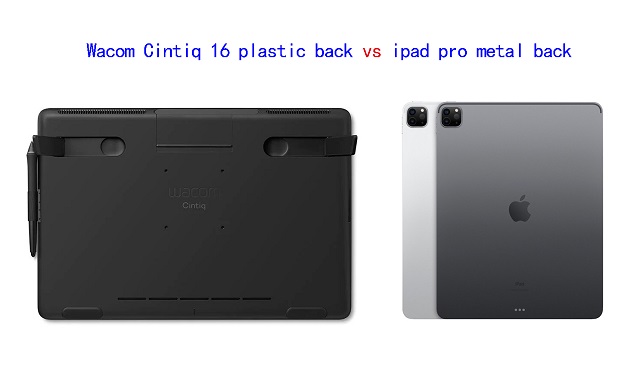
When it comes to design, the iPad Pro absolutely crushes the Wacom Cintiq.
And this is evident when you line up both devices side by side because the Wacom Cintiq looks clunky and purely functional, whereas the iPad is a visual treat.
Apple has used metal and glass to put together the iPad, whereas the Wacom Cintiq are made of glass and plastic, especially the back.
Portability
With iPad you don't need any laptop or computer to be able to draw, just an Apple pencil and installed drawing application. It's a great all-in-one device.
Even the biggest iPad Pro with 12,9” screen is truly portable. You can easily put it in a backpack and go to a park or café, and keep drawing while enjoying your favorite coffee.
Wacom Cintiq tablets need to be connected to your computer or laptop and a power, so you can't move around much with them. so say goodbye to drawing on the go
Screen Size
The iPad Pro is currently available in two sizes — 11-inches and 12.9 inches.
Wacom Cintiqs can get really massive in size, which include 13.3 inch, 15.6 inch, 21.5 inch, 23.8 inch, 27inch and even 32 inch.
A 12.9-inch iPad Pro isn't so bad for drawing and actually makes for improved portability.
However, professional artists will still need a lot more space to deal with real serious work. The Wacom Cintiq provides that space in abundance.
Based on experience, Having a larger screen makes a difference when consulting references while painting. So it's really useful if you like using a giant screen.
Screen Quality
The iPad Pro features a Liquid Retina XDR display with impressive 2K high-resolution, 1000 nits of brightness, 1000000:1 contrast ratio, and a 100% DCI-P3 color accuracy.
Its gorgeous screen delivers stunning visuals, bringing out the finest details in your work. Its wide color gamut further ensures vibrant and true-to-life colors, making your artwork come alive on the screen.
In comparison, the regular Wacom Cintiq (Cintiq 16 or Cintiq 22) has an IPS screen with 1080p resolution, 210 nits of brightness, 1000:1 contrast, and 96% sRGB color gamut. so they have a lower clarity and color quality than what you get with ipad devices.
However, the Cintiq Pro boasts a 4K resolution display, providing an exceptional level of detail and clarity. Furthermore, its support for 98% of the Adobe RGB color gamut ensures accurate and rich color reproduction.
So, if you have high requirements about both precision and using an effective workflow, the ipad pro and Cintiq Pro line may be the best match for your needs.
Wacom Cintiq screens only refresh at 60Hz, while the iPad Pro have 120Hz display using Apple's ProMotion variable refresh rate tech.
The improved refresh rate of the ipad pro display will help your line-drawing appear even smoother than it did before.
There's also the hover feature but that's exclusive to the 2022 iPad Pros. If you mostly sketch and draw, it's not a huge game changer, but if you paint a lot it's very useful.
Screen Technology
Both Cintiq Pros and iPad Pros have fully laminated screens with no noticeable parallax.
However, The regular Wacom Cintiq does not have a fully laminated screen, although Wacom's manufacturing process effectively eliminates parallax.
Drawing Surface
iPad Pro features a glossy, smooth screen which can be a problem for drawing, as it can be slippery and make it difficult to maintain control over the stylus.
To address this issue, some users choose to apply a matte textured film to the screen protector.
On the other hand, Wacom Cintiqs has a matte finish so it doesn't have that glossiness and you get more of that paper feel than you will on the iPad Pro.
So if you like drawing on that more–with that paper feel, or that textured feel–you're going to be wanting to lean more towards the Wacom Cintiq.
Hardware
Wacom Cintiqs solely act as another monitor that doubles as a drawing canvas, they don't have any of their own processing power. All the computing power you need to operate the Cintiq will come from the Windows PC or Mac that you connect the device to.
The iPad Pro, on the other hand, comes with the same M2 chipset as the apple MacBook Pro. You also get 8GB of RAM in the entry models and 16GB of RAM on the top models.
The powerful specs of ipad pro means that you will be able to do several things at once without having to worry about it slowing down. You can play music in the background, work on your drawing without any problems.
Compatibility and Software
The iPad Pro runs iPadOS, The most popular drawing app on the iPad currently is Procreate, which is not available for other operating systems.
While the iPad Pro has a couple of applications, such as Adobe Photoshp, Sketchbook and Clip Studio Paint, the usability is limited compared to what you get on a full desktop version.
The Wacom Cintiq is versatile in terms of operating system compatibility since it can run both Windows and Mac apps. This gives customers access to various software, including popular art programs like Krita, Corel Painter, illustrator, and ToonBoom.
One key difference is that you get drawing tablet for 3D modeling and sculpting work done on the Wacom Cintiq, which you can't do on the iPad Pro. such as Blender, Zbrush, Cinema 4D, Maya, 3DS Max, SketchUP, etc.
Stylus Pen
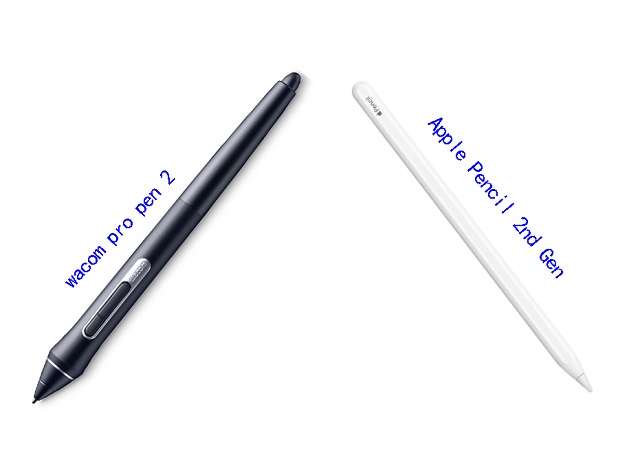
Both the Wacom Cintiq & Cintiq Pro uses the Pro Pen 2, which offers 8,192 levels of pressure sensitivity and tilt response. What's more, you don't have to buy stylus separately, as it is already included.
Wacom stylus is battery-free and picks up its power through Electro-Magnetic Resonance right off the tablet surface itself. The Sensitivity is amazing with higher levels of pressure for smoother thick to thin transitions.
The Pro Pen 2 has an eraser & two buttons that can be programmed to do all sort of things for you, the tips of the pen is small enough to make it easy to draw. The pen itself is thick compared to the Apple pencil.
The wacom stylus also has a rubber grip that helps to ease fatigue as you draw.
The iPad Pro uses the Apple Pencil (2nd gen), which is long and looks closer to a normal pencil, it doesn't have any button on it.
With low latency of 9ms, support for tilt and pressure sensitivity, the Apple Pencil allows for precise and natural pen input, allowing you to create artwork with incredible detail and control.
Apple hasn't disclosed the pressure & tilt sensitivity of the iPad pro, but it works fine for many applications.
However, the apple pencil is sold separately, needs to be charged, which is a little boring and old fashioned. Luckily, it's quick to recharge and takes a mere 15 minutes.
When it comes to replacement nibs, the wacom Pro pen 2 comes with 9 replacement nibs inside the elegant case it comes in. The Apple Pencil only comes with one.
Both styluses are the best on the market, They work equally well and produce similar levels of performance and accuracy.
Multi-Touch
All of ipad pro devices has touch capabilities, which can make drawing easier by making it faster to draw as gestures like pinch-to-zoom and rotating the screen with two fingers can come in handy.
If touch controls are a big part of your workflow, Note that the wacom Cintiq has two versions: a cintiq pro version that supports touch, and a regular wacom cintiq that doesn't, but is more affordable.
Battery Life
For a portable device that could be used to draw on the go, battery life is important, and a minimum of 3-4 hours is required to be able to do that, if not more.
The iPad Pro can provide at least 5-6 hours of battery life under extensive use, and it can provide up to 10 hours under normal usage.
Since the Wacom Cintiq is not a portable device, it is out of this part of the comparison.
Connectivity
The iPad Pro offers versatile connectivity options, including USB-C, which allows you to connect a wide range of accessories and external devices to your mobile device.
In addition to USB-C, the iPad Pro supports wireless connectivity options such as Bluetooth and Wi-Fi, enabling seamless integration with compatible devices and networks.
The Wacom Cintiq doesn't support wireless connectivity, You'll need to connect the display to your windows pc or Mac with both HDMI and USB-A cables.
In addition, you will also have to connect it to power. This can be cluttered and make cable management a bit annoying. Once connected this wacom cintiq will mirror your desktop.
To make the wacom cintiq work, you will also need to download the tablet driver from wacom official site. This undoubtedly increases the complexity.
Versatility
The iPad Pro leads in terms of Versatility. As a great all-in-one device, the iPad pro does more and is more likely to suit a wider range of users and needs.
So you can do a lot of different things apart from creating art, like browsing internet, playing games, watching netflix and youtube videos, facetime your friends etc.
The Wacom Cintiq is just a pure drawing, painting, and sketching tablet.
Price
The iPad Pro is much more affordable than any Cintiq Pro tablet you get from Wacom—particularly when considering the bigger size than 15.6-inch.
Only two regular wacom cintiqs (cintiq 16 and cintiq 22) and wacom cintiq pro 13 are much cheaper than iPad Pro.
Perhaps the iPad Pro can be seen as a cheaper yet close enough alternative to a Wacom Cintiq for those on a budget.
Which Wacom cintiq should you get?
The regular cintiq 16 and Cintiq 22 are suitable for most people, which has a decent size, 1080p resolutin and are more "affordable" than the other Cintiq pro options on the market.
The Cintiq Pro Line has higher 4K resolution, wider color accuracy of 98% Adobe RGB, multi-touch, laminated screen and etched glass surface, ideal for technically demanding digital artistry projects like animation and 3D modelling.
1. Wacom Cintiq 16
2. Wacom Cintiq22
3. Wacom Cintiq Pro 13
4. Wacom Cintiq Pro 16
5. Wacom Cintiq Pro 24
6. Wacom Cintiq Pro 27
7. Wacom Cintiq Pro 32
Conclusion
Each of the two devices in this comparison has their own advantage, to the degree that there is no clear winner here.
For that, the device you are going to pick up depends mainly on your needs for portability, preference, budget, apps and the workflow you have right now.
If you're traveling a lot, working on trains, and doing a lot of sketching — an iPad pro might work great for you.
iPad pro has the best portability, and it is great for sketching & practicing your drawing, and it has the potential to be used in professional settings as well.
On the other hand, The Wacom Cintiq might be a better choice to draw on screen using the professional desktop software, it is not portable at all, but it is great to use in your existing studio or workspace.
The iPad Pro is great for 2D illustrations, but for 3D work or more advanced features, a Wacom cintiq tablet may be a better investment. Furthermore, If you still want to be mobile but favor a Wacom, then their MobileStudio could be the solution for you.
Ultimately, it's your decision on what you wanna use to complete your artwork.
Happy Drawing!
-
Wacom One vs Huion Kamvas 13 Comparison
Mittwoch, 18. Oktober 2023
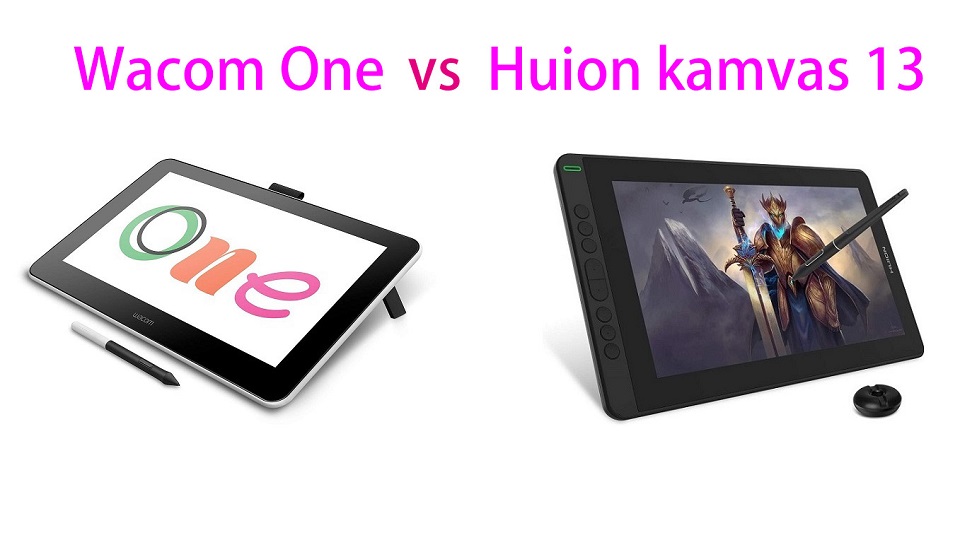
Wacom One and the Huion Kamvas 13 are very similar pen display tablets. both are fantastic devices for students and hobbyists in the market for a display tablet on a budget.
So, which is better for you? To help you make the choice, Pctechtest have compared the Wacom One vs Huion Kamvas 13 on both specs and value or money.
Which brand is better and why?
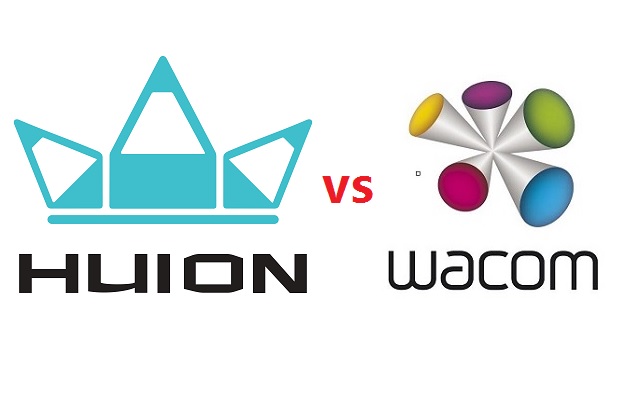
In the field of digital art and graphic design, two brands come up as contenders for the best tablet for artists.
Through the years, Wacom had been the main player in the field producing high-quality drawing tablets. Huion came in later and started off with cheap drawing tablet options for beginner artists.
As years went by, Wacom also came up with beginner-centered drawing tablets that were cheaper and rookie friendly.
Huion on the other hand also grew to make high-quality professional devices that matched up to the high-quality standard set by Wacom.
Design and Build Quality
The wacom one has a very minimalist look with just a screen at the front.
On the other hand, Huion Kamvas 13 has 8 shortcut buttons along with the screen at the front.
Both the tablets are made of plastic and have comparable built quality.
Screen Quality
Both the tablets come with a 13.3 inch 1920 x 1080 pixel full HD display.
Wacom one has a TFT LCD panel with 72% NTSC / 99% sRGB color coverage .
Huion Kamvas 13 has an IPS LCD panel with 120% sRGB color gamut. It means that the Kamvas 13 has a wider color gamut.
A monitor with a wide color gamut can display more colors, making the image more vivid and immersive.
Screen Technology
Huion Kamvas 13 has a laminated screen, while the wacom one doesn't.
The parallax is minimal thanks to the fully laminated screen, which reduces the gap between the pen tip and the display surface, resulting in a more accurate drawing experience.
In addition, Both the tablets use anti-glare matte films on their displays which helps reduce glare and reflections on the screen.
These films are textured which provides resistance to the stylus while drawing, giving you more control over your stylus.
Stylus
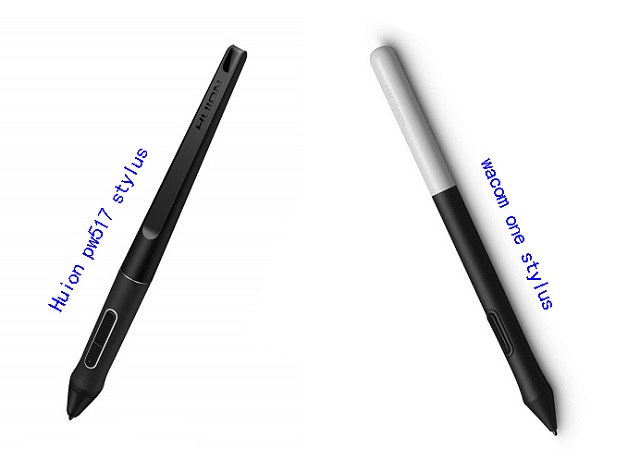
Both of the pens are comfortable to hold and come with a very ergonomic design. Also, They have the same EMR technology for unlimited hours of ergonomic, battery free creativity.
The Wacom one Pen supports 4,096 levels of pressure sensitivity, 2,540 LPI resolution and tilt recognition.
The Huion PW 517 pen supports tilt response, 5,080 LPI resolution and up to 8192 levels of pressure sensitivity.
Comparing the two styluses, the Huion stylus has a higher pressure levels and it will allow you to make finer differences in line thickness.
However, Unless you're doing hyper-nuanced creative work, you likely might not note a lot of a distinction between having eight,192 pressure tiers and having a fragment of that quantity.
Shortcut Buttons
The Wacom One lacks any buttons on the tablet – there are only one on the pen itself. You can buy an optional remote, which adds 17 buttons, including a touch ring, but this is extra expense.
With eight shortcut buttons, the Kamvas 13 beats the wacom one hands down in this area. If you value using keyboard shortcuts, then this may be the deciding factor for you.
Tablet Stand
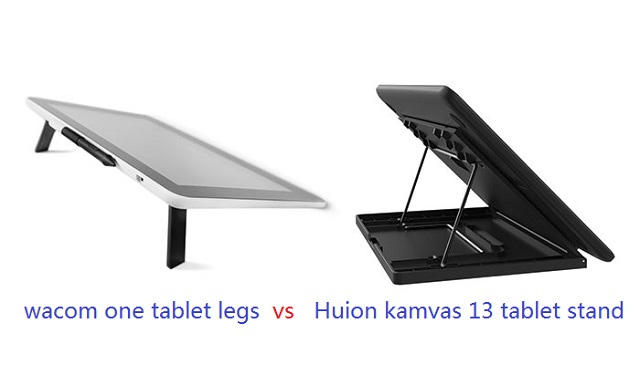
The wacom one has foldable legs that lift the tablet at an angle of 19°.
With Huion Kamvas 13, you have an adjustable plastic stand that allows you to create at your best angle.
Compatibility
Both Wacom One and the Huion Kamvas 13 works with Windows, Mac as well as certain Android and chromebook devices.
For Windows and Mac OS computers, you need to download the respective drivers of Wacom One and Huion Kamvas 13 from their official site.
For Android and Chromebook devices, you don't need to download any driver. You can simply plug in the tablet and start using it.
Connectivity
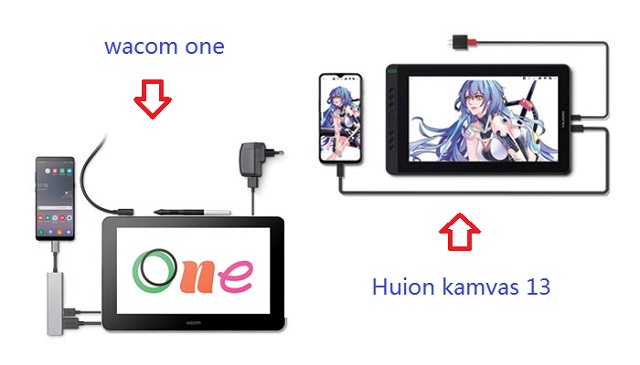
Both wacom one and huion Kamvas 13 tablet come with a 3-in-1 cable.
The end that goes into the tablet is USB-C. The other ends requires 2 USB-A ports and one HDMI slot on your computer.
However, Huion Kamvas 13 also supports single USB-C cable connection. This method requires devices that support USB3.1 Gen1, DP1.2 and above standards.
The USB-C to USB-C cable can be purchased separately in their store. 3rd party USB-C cables are not supported because of the custom size of the slot.
Accessories
Wacom one only providing a limited number of accessories, It has a built-in tablet stand, an all in one super-simple cloth loop and only 3 replacement nibs.
Huion is more generous with accessories, Kamvas 13 comes with a lot of accessories like drawing glove, tablet stand, pen holder and 10 replacement nibs.
Bonus Software
Wacom One is bundled with some free trials of photo editing software, graphic design software and art drawing software . such as wacom bamboo paper, 3 months of Clip Studio Paint Pro, 3 months of Magma Pro Plan, 3 months of Skillshare, 3 months of Affinity suite and 3 months of Bluescape.
Huion Kamvas 13 doesn't come with so-called bonus software. Anyway, you can always opt for free art software like Medibang Paint Pro, Gimp, Mypaint and Krita.
For one time paid software, consider Sketchbook, Paint tool SAI, Artrage 6, or the Clip Studio Paint.
Price
Huion Kamvas 13 pen display cost as little as $260, while wacom one 13 cost 400 dollars.
Surprisingly, the Huion Kamvas 13 is significantly cheaper than the Wacom one despite having better features.
Does the Wacom One and Huion Kamvas work without a computer?
The Wacom One needs a computer or at least an Android device to work. The same goes with the Huion Kamvas 13.
Conclusion
The Wacom One and Huion Kamvas 13 are solid entries into the budget drawing tablet market.
They both are great devices, have a very comparable stylus and overall have very similar drawing experience.
If you're looking for a digital display that includes Wacom's world-class input, look no further.
Despite lacking some features that would be nice to have, wacom one performs its core functions extremely well.
If you're just starting out with digital art, you might want to consider a more budget-friendly option - Huion Kamvas 13.
You cannot go wrong with either of them. it all comes down to your budget and preferences.
-
Dienstag, 17. Oktober 2023
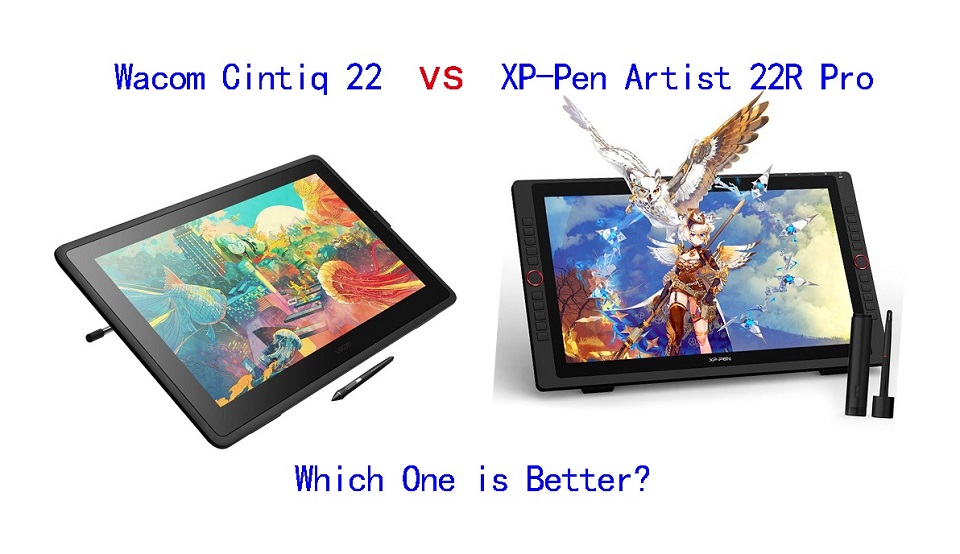
Drawing on a display tablet is far more enjoyable, intuitive and natural than doing it on non-display tablets. It feels like actually drawing on paper.
22 inches is a practical size for most artistic needs, which promises ample space for creativity to flow freely.
Of course, It is best for use on a desk or art table in a studio or other fixed location.
If you are an artist looking for an affordable larger 22-inch drawing tablet monitor, the Wacom Cintiq 22 and the XP-Pen Artist 22R Pro are two of the best options in the market right now.
Which of the two tablets are packed with better features? and which tablet provides a superior drawing experience?
In this Wacom Cintiq 22 vs XP-Pen Artist 22R Pro comparison, we will take a detailed look at both these tablets in order to find out which tablet will suit your needs better.
Brands

Since digital tablets were invented, Wacom has had a position at the forefront of the industry.
But in recent years many new brands have arisen to challenge it, XP-Pen among them.
While XP-Pen tablets are generally cheaper than Wacom tablets and have more features, Wacom tablets tend to have more of a premium and durable build, better stylus, and a lot more brand recognition.
Build Quality and Design
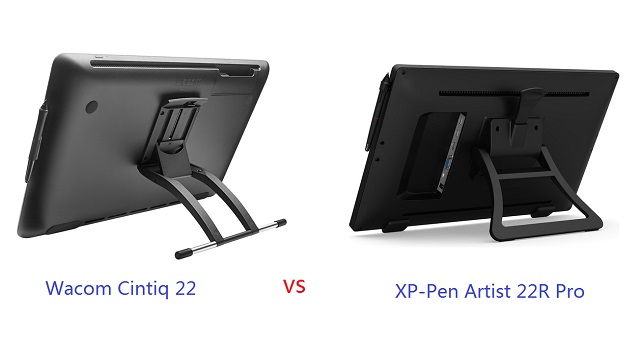
The Cintiq 22 has a very minimalist look with just a screen at the front. On the other hand , Artist 22R Pro has two row of shortcut buttons along with the screen at the front.
Both the tablets are made of plastic and have comparable built quality. The tables feel strong and sturdy and with no flex or wobble to be found anywhere.
The tablet has all the ports at the back, this helps with cable management with no cable running across your working region.
In addition,Both tablets have an adjustable stand built into the tablet. Thus, you can tilt the display until you achieve your desired and comfortable drawing angle, from 16 degrees up to 90 degrees.
Screen Quality
Wacom Cintiq 22 and the XP-Pen Artist 22R Pro both come with a 21.5-inch IPS screen with a resolution of 1920 x 1080 pixels, perfect for viewing applications and programs with extensive menus.
The color accuracy is one of the main areas where these displays differ the most. The more color-accurate display means the screen has a wider color palette and can displays minute difference in colors.
The Wacom Cintiq 22 comes with a color accuracy of 96% sRGB. The XPPen Artist 22R Pro, on the other hand, comes with a wider color gamut of 120% sRGB, which is more rich, vibrant and vivid.
However, Wacom Cintiq 16 displays come pre-calibrated out of the box and show accurate colors right of the bat.
XP-Pen Artist 22R Pro is not precalibrated, which means it does not have the right color settings. So you need to fix it by manually changing the color settings or using a color calibrator.
Screen Technology
The technology that enables the Cintiq 22 and XP-Pen Artist 22R Pro to work means there are two planes you interact with: the glass you draw on, and the actual screen presenting the image you're drawing.
Too great an air gap between the two leads to a disconcerting disconnect between the point of your stylus and where your pen mark appears on-screen, whiwch is called parallax.
A good solution is fully-laminated display, the layers of the display are laminated together, thus helps reduce parallax.
Unfortually, Neither the Wacom Cintiq 22 nor the Huion Kamvas 22 comes with a laminated display.
With that said, these tablets do a good job of minimizing air gap. The parallax is still there but it's subtle and perfectly acceptable.
Drawing Surface
With Wacom Cintiq 22 and the XP-Pen Artist 22R Pro, you get a thin plastic film applied over the glass surface of the tablet which is responsible for introducing texture to the surface.
The added friction feels a lot more natural and also improves brush control. The plastic film also resists glare and protects the glass from getting scratches.
However, the matte film on the surface of the Artist 22R Pro is not quite up to the level of the anti-glare protector on the Cintiq 22, with a less textured feel and consequently less lifelike drawing experience.
Stylus Pen
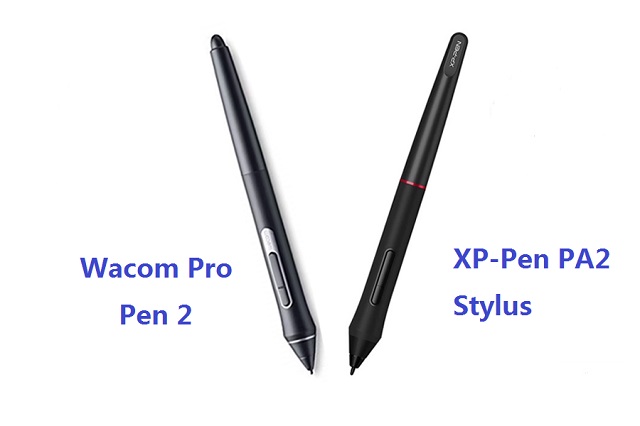
Wacom cintiq22 comes with the Wacom Pro Pen 2 stylus, which is the exact, same stylus the most expensive Cintiq Pro uses.
At present, the XP-Pen PA2 is almost as good as the Wacom Pro Pen 2 and provides a very similar drawing experience.
Both of the pens are comfortable to hold because of the rubber grip and ergonomic design.
You get a pair of side buttons on the Pro Pen 2 along with a pressure-sensitive eraser at the back. On the other hand, the PA2 Pen from XP-Pen doesn't have an eraser but comes with two side buttons.
In the pen settings, you can configure these side buttons to any hotkey of your choice.
Pressure and Tilt Sensitivity
Both the stylus are battery-free, supports 8192 levels of pressure sensitivity and ±60° of tilt recognition.
The 8192 pressure levels allows you to make subtle and minuscule changes to your artwork and by simply adjusting pen pressure , you can change line weight and brush size, as you would with a paintbrush.
However, The Wacom Pro Pen 2 performs slightly better in the initial activation force – where it better detects the lighter pressure. With XP-Pen PA2, You will have to draw the lines with more pressure.
Furthermore, The Wacom Pro pen 2 takes a slight edge in tilt sensitivity. When you tilt the XPPen stylus the pointer shifts slightly away from the center. In the case of Wacom, the pointer remains at its place when tilted.
If you value drawing accuracy, the Wacom Cintiq 22 is therefore the better pick.
Hotkeys And Controls
The Wacom Cintiq 22 lacks any buttons on the tablet, You can buy an optional express remote, which adds 17 buttons, including a touch ring, but this is extra expense on top of an already expensive product.
With a total of 20 shortcut buttons and two red roller wheels, the Artist 22R Pro beats the Cintiq 22 hands down in this area. If you value using keyboard shortcuts, then this may be the deciding factor for you.
They're customizable to fit your needs, and to speed up workflow. The two unique roller wheels even allows you to scroll or zoom, cycle layers, change brush size, and rotate.
Accessories

Although the XP-Pen Artist 22R Pro is way cheaper than Wacom Cintiq 22, it still comes with more Accessories like drawing glove and Pen holder.
The two-finger black artist glove aims at reduce the friction between your hand and the drawing surface. Also, it will avoid smudges from your hands.
The XP-Pen Artist 22R Pro comes with a cylindrical pen holder, which provides excellent protection to the pen. The cap of pen holder also act as a pen stand and a storage space for 8 extra pen nibs.
With Wacom cintiq, you do not get a dedicated pen holder. Instead, you get a small fabric loop that can clips into either side of the tablet. It also cleverly hides three extra stylus nibs.
Connectivity and Compatibility
Both these tablets uses three separate cables to connect to a computer: USB, power, and HDMI.
However, XP-Pen Artist 22R Pro also supports a USB-C to USB-C connection, letting you directly connect your iMac/Mac Book Pro or other windows devices with usb-c port.
Since Most Macs do not use HDMI, so you may need to purchase an adapter separately for Cintiq 22.
Both XP-Pen Artist 22R Pro and Wacom Cintiq 22 are compatible with the popular operating systems Linux, Windows and Mac.
In addition to Linux, Windows and Mac, the XP-Pen Artist 22R Pro also supports and can connect to Android smartphones and tablets.
Drivers
After connecting to the computer, you can download the drivers from their official websites.
Drivers of both Wacom and XP-Pen are available for Linux, Windows and Mac devices.
The drivers allow you to customize things like buttons and the pressure sensitivity of the pen and the color settings of the tablet.
Comparing the two drivers, you can say that the drivers of Wacom are slightly better as they are more simple to learn, easy to use, stable, and less issues.
Bonus Software
When you purchase your XP-Pen Artist 22R Pro tablet, you get a free license for one of 2 available digital art drawing software: ArtRage 6, and openCanvas.
With Wacom Cintiq 22, you can get a 6-month free trials of Clip Studio Paint EX, and 3 months (or 250GB) of MASV.
Price
If you were to go to Amazon right now and buy both tablets, the Wacom Cintiq 22 would cost you $1200.99 whereas the XP-Pen Artist 22R Pro tablet would cost you $621.99.
The Artist 22R Pro is priced substantially lower than the Cintiq 22. Actually if you don't need shortcut keys you can also get XP-Pen Artist 22 (2nd Generation) to save an extra $100.
Conclusion
They both have a very comparable stylus and overall have very similar drawing experience. And the 22-inch canvas is great for large format illustration, 3D Sculpting and detailed photo editing.
On pure drawing performance, the Wacom Cintiq 22 might be the better option, but when you bring price into the equation, the XP-Pen Artist 22R Pro seems a much better choice.
All comes down to your Skill levels, budget, preference and needs. If you are looking for a large drawing monitor in a budget the Artist 22R Pro is the best choice for you.
But if you don't mind spending more for slightly better hardware and stylus and do not mind the lack of shortcut buttons than Wacom Cintiq 22 will not disappoint you.
Source: https://pctechtest.com/wacom-cintiq-22-vs-xppen-artist-22r-pro
-
Best OnePlus SmartPhones You can Buy
Dienstag, 10. Oktober 2023
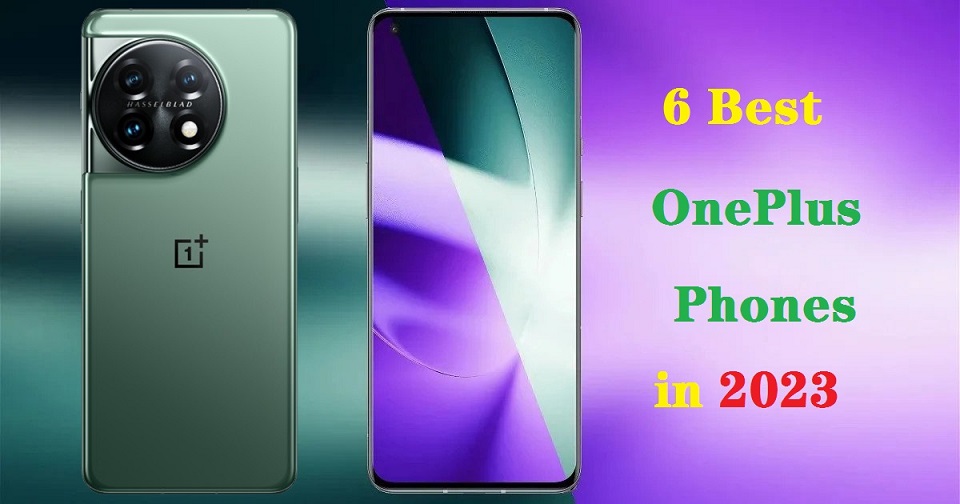
It is difficult to imagine a day without a smartphone in the present era because it allows us to stay in touch with others.
The best OnePlus phones are a great choice if you don't want one of the latest Apple iPhone, Samsung Galaxy phone or Google Pixel phone models. OnePlus phones tend to be slightly cheaper than other smartphone devices, but they're still high-end phones packed with the latest features and technology.
OnePlus has become one of the most popular and beloved phone brands in the world. OnePlus smartphones offer a unique combination of design, performance, and affordability that have made them a go-to choice for many consumers.
When OnePlus first started selling phones back in 2014, it positioned its devices as flagship killers, offering similar specs and performance as high-end phones from Samsung, Google, and others, but for half the price.
Later, as OnePlus grew and matured, even though its phones may not have offered quite the same level of savings, OnePlus began challenging the big brands with things like faster updates, cleaner, more streamlined builds of Android, and high refresh rate displays.
The latest OnePlus 11 with high-end features but sell for an affordable price, and they're easily one of the best Android phones available today. Furthermore, And with the newer model out, we should see some very tempting price cuts for the older model.
If you're interested in the OnePlus brand but aren't sure which is the model for you, then this is the guide for you. Pc Tech Test help you pick the right OnePlus phone deal for you.
What kind of company is OnePlus?
OnePlus is a Shenzhen-based start-up and producer of smartphones founded in December, 2013. Now It is a subsidiary of Oppo.
From exclusive, invite-only sales to holding its own against the likes of Samsung and Apple, OnePlus has come a long way since its humble word-of-mouth beginnings.
The company's claim to fame is its bid to offer flagship-level specs in its smartphones, at affordable prices.
With its commitment to innovation and customer satisfaction, OnePlus has quickly become a leader in the mobile phone industry.
As the price of OnePlus flagships has gradually increased in recent years, the company unveiled the cheap Nord series, which nevertheless manages to cram a few premium features into affordable phones. These mobile phones are suitable for everyone.
Why are OnePlus phones so popular?
OnePlus phones have consistently been praised for their clean and intuitive software, cutting-edge hardware, and competitive pricing.
OnePlus smartphones often released with adequate RAM and ROM so consumers can play and store with ease.
OnePlus devices leverage crisp, vibrant, expansive OLED screens with high refresh rate to give users a variety of options for working across multiple apps.
They are known to provide a clean and almost stock Android experience with their OxygenOS mobile operating system. The company slogan is “Never Settle”.
From 2023 year, select smartphones will get four major OS upgrades, along with five years of security patches.
It is the only Android brand that uses an alert slider for switching to and from silent mode.
You can get top-notch cameras, the Hasselblad camera is a big leap forward for OnePlus. OnePlus has partnered with Swede camera-maker Hasselblad for the OnePlus 9, OnePlus 10, and OnePlus 11 series.
OnePlus phones are known for their solid battery life and fast charging support, which is why so many users prefer them.
You can expect OnePlus phones come with a battery capacity of at least 4,500 mAh. This means your phone will last you a whole day without needing a recharge.
Dash Charge is a quick-charge technology from OnePlus. It promises to provide 63% of a full charge in just 30 minutes of charging.
Not only this, oneplus mobiles provide with slim, gorgeous design, and advanced connectivity options like 4G and 5G network, WiFi, GPS and NFC.
Moreover, oneplus mobile prices are quite reasonable so a consumer would not hesitate when buying a oneplus smartphone.
The 6 Best OnePlus Phones in 2023
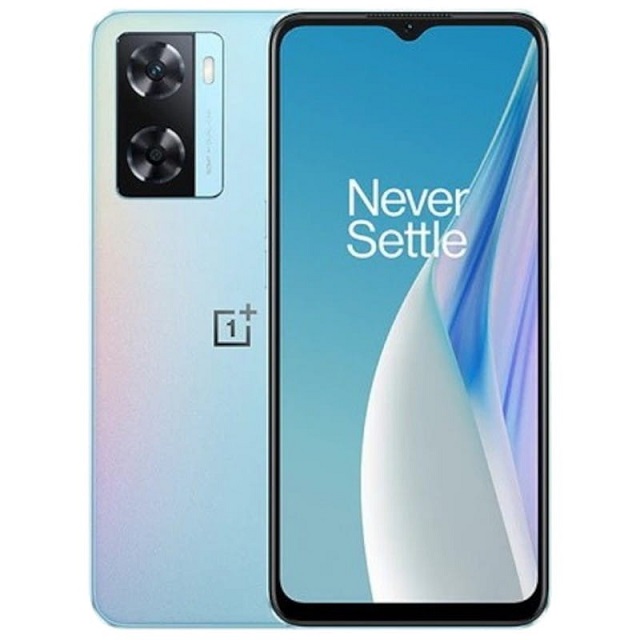
To help you choose the best Oneplus phone, we'll go through all the OnePlus phones on sale today in this article, highlight the main differences between them – and point you to the best advantages of each phone.
From the most advanced flagships to the most sought-after mid-range models, you'll be able to find the best OnePlus phone for your needs and budget.
1. OnePlus 11
2. OnePlus 10 Pro
3. OnePlus Nord N20
4. OnePlus Nord 2T
5. OnePlus Nord CE 3 Lite
6. OnePlus Nord N200
Conclusion
We have already selected the 6 best OnePlus models for you that will diversify your options, and you can choose a product that suits you the best.
Boasting the latest designs and technologies, these phones are ideal for anyone seeking a sophisticated and powerful device. And they will be quite relatable to its users and will live up to their expectations.
Whether you're looking for a powerful gaming device or a more budget-friendly option, OnePlus has something for everyone.
Find the best OnePlus phone for yourself or your family and friends here.
-
Best Graphic Pen Tablets for Adobe Photoshop
Samstag, 7. Oktober 2023
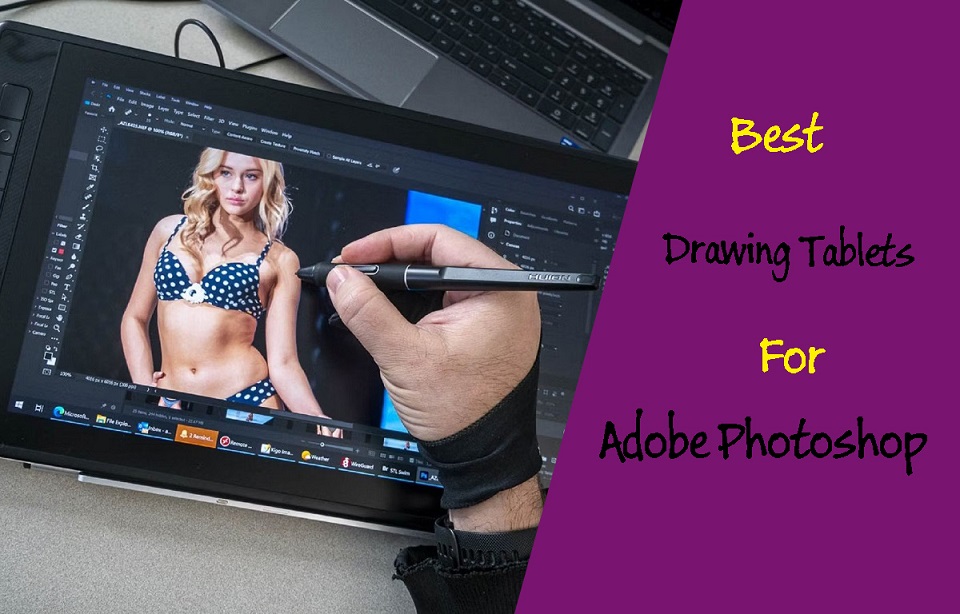
If you are learning editing photo or drawing in photoshop, you must have heard others recommend getting a graphics tablet.
The right drawing tablet can help you unleash your Adobe Photoshop skills to your full potential and accelerate your learning speed.
However, there are so many choices for graphics tablets in the market that it is almost impossible to decide which tablet to pick over the other.
So which type of tablets are better suited for photoshop, what are the features you should be looking for, these are some of the questions we will be answering in this article.
We've also rounded up the 10 best drawing tablets for adobe photoshop, from expensive surface pro to pen displays and simple options, and explained exactly what makes them so good.
What is Adobe Photoshop?
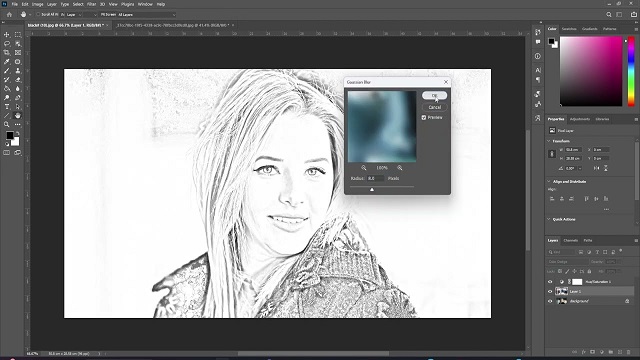
Adobe Photoshop CC has long been a byword for image editing program. The renowned software is the go-to solution for artists, illustrators, designers, and photographers.
It contains almost everything you need to edit, modify, or enhance your photos and images. Adobe Photoshop has many basic retouching tools and functionalities like cropping, painting, filling, blurring, sharpening, erasing, and dodging, and this will satisfy most casual users.
However, it can also cater to power users with its options to edit multiple layers, masks, channels, sky replacements, pattern previews, the all-encompassing Adobe Sensei, and a whole lot more. the power of its layer-based editing system can handle the most complex of creative projects.
Adobe Photoshop supports RAW file formats, This means you can edit your photos without losing any data, and you can make advanced adjustments to exposure, white balance, and more.
Since it was designed to be picture editing programme, it is really good at changing colours. It also supports CMYK, the standard format for written works.
Additionally, Adobe Photoshop is absolutely a good drawing program. While its primary function is built around photo editing, it has the tools you need to draw.
Its numerous pen, marker, brush and pencil tools allow users to create realistic effects in their illustrations, from watercolor-style paintings to cartoon-style lines.
The default brush engine is not that good with lineart, but still, it's can be considered the best in everything overall. You can also customise your own brushes to create wonderful textures and effects that can emulate traditional painting mediums.
No matter how unique your illustrations, Adobe's software can accommodate your style. Plus, additional features such as the Creative Cloud libraries make it easy to jump from one device to another and keep drawing.
The program is updated all the time. You never have to wait long for new features to be introduced. And it keeps them ahead of the competition.
However, Photoshop comes with a steeper learning curve. It's also somewhat expensive compared to other apps.
What is a Drawing Tablet?
A drawing tablet is a device used to input digital drawings and illustrations. The device consists of a stylus and a flat surface that is capable of detecting pressure and movement. This information is then transmitted to a computer or other computer-based device, where it can be used to create digital art.
Do You Need a Drawing Tablet for Photoshop?
Using a stylus on a drawing tablet makes editing and drawing much more natural than using a mouse, and allows you to work faster and more accurately too.
Tablets help a lot to people who suffer from carpal tunnel, no matter how long you work with a stylus, you'll never feel tired or get a soar wrist.
While using a mouse you only have your wrist movements whereas while working with a pen you get a full range of motion with your arms and wrists.
Tablets are absolute positioning devices while mice are of the relative positioning variety. Your clicks and selections will be accurate with a tablet as your pen cursor position will be mapped precisely to your screen.
Drawing tablets have pressure sensitivity, something a mouse simply does not have. so you can draw like a pen or pencil, applying thicker or thinner strokes as you go. This makes it better suited for photoshop especially when you are doing detailed retouching.
You can also control the shape of the strokes by simply tilting the pen, a feature that is better for high-end professionals.
The shortcut keys on tablets reduce the need to switch between tools, allowing you to concentrate on the work at hand. This enables you to work faster and eliminates the tedium and strain that come with performing seemingly repetitive tasks.
Things to consider when choosing a drawing tablet for Adobe Photoshop
For digital art in Photoshop, Here are a few of the most important factors that impact the quality and functionality of a drawing tablet.
1. Types of tablet
Drawing Tablets that don't have a display are some of the most common types of digital tablets in the market.
You'll be making drawing motions on the tablet in your hands, yet looking at your computer screen. So you may need a little time to build up the hand-eye coordination.
However, They are generally cheaper, more durable and come with some neat features like support for wireless connectivity.
Pen displays are drawing tablet with a built-in screen. These tablets come in multiple sizes starting from 10 or 12 inches all the way up to 32 inches.
Drawing directly on the screen will feel more akin to putting a pencil to paper. But again, this is the more costly option. So they are mainly bought by more professionals and established artists.
Note that Pen display tablets do not have a processor of their own and need to be connected to a computer in order to work.
Increasingly, major brands, such as the Apple iPad Pro, the Samsung Galaxy Tab, or the Microsoft Surface Pro, are promoting their media tablets as graphics tablets.
For hobbyists, amateurs, and creative professionals who need a lightweight tool to work with on the move, this type of standalone tablet and digital stylus combo is cost-effective. It's great to use at leisure and offers a decent drawing experience.
2. Reasonable Working Space
The active area is the portion that you draw on.
A bigger active area will enable you to work on larger drawings more comfortable without the need for zooming and panning, but it is also more expensive.
A smaller tablet may be more portable and affordable, but it can also be more cramped to draw on for extended periods.
3. Pressure Sensitivity
Pressure sensitivity refers to how sensitive the tablet is to the amount of pressure you apply with the pen.
The harder you press the thicker your strokes are and the lighter you press the lighter the strokes are.
Most modern drawing tablets come with varying levels of pressure sensitivity, usually ranging from 2,048 to 8,192 levels.
The higher the level of pressure sensitivity, the more control an artist has over the thickness, opacity, and texture of their lines and strokes.
4. Tilt Recognition
Tilt Recognition is a digital tablet feature that allows the device to perceive the angle of the digital pen over the tablet surface.
That data is used by the device software to react in consequence. So, the resultant traces tent to look like it would do on physical work, according to each drawing tool used.
Tilt Recognition is a feature that comes with most of the latest generation of tablets.
5. Stylus Type
Drawing tablets come with one of two types of styluses: rechargeable, or electromagnetic resonance (EMR).
Rechargeable styluses need charging, And if they die you will have to charge before you can draw again. They are usually slimmer and fit comfortably in your hand.
EMR styluses employ an innovative electromagnetic frequency that transfers power to the pen wirelessly right from the tablet, so there's no need to charge it.
Regardless of which type you get you'll be able to draw all the same. Just make sure the tablet you choose has a comfortable stylus that fits well in your hand.
6. Display
The display is a factor to consider if you're getting a tablet with a screen.
Normally, a display with full HD resolution works just fine. however, owning a better resolution like 2K or 4K display will represent a huge advantage for any kind of creative work.
If you work with colors a lot, it's a good idea to get a display that covers a large range of colors above 100% sRGB.
If what you need is portability, going for tablets from 10” to 16” would be the best choice. If you do a lot of illustrations, We would recommend going for a 22-inch or larger size.
7. Programable Buttons
Having programmable function buttons are by far not essential but are great to have. They allow you to map keyboard shortcuts to them to avoid having to use a keyboard for some actions.
With Photoshop you can utilze these keys while drawing or editing photos for instance by mapping them to functions such as undo, smoothing or inverting the brush.
8. Additional Features
For standalone drawing tablet, you also need to pay attention to processing power includes processor, ram, storage, and graphics card.
Artists may spend several hours at a time working on a digital piece, so it's important to have a portable tablet with a battery that can last for a long time.
Look for tablets with a battery life of at least 8-10 hours, and consider devices with longer battery life if you plan on using the tablet for extended periods of time.
9. Compatibility
Photoshop is available for Windows and macOS. Photoshop also has a version for iPad, but many artists still prefer using the desktop version for the full suite of features.
If you choose to buy an Android tablet you'll need to download the Photoshop Express App on your device.
There are certain tablets that only support a specific operating system, for example, Apple iPad only works for iPad OS, samsung galaxy tab only runs on android and Microsoft Surface only supports Windows OS. So it's a good idea to check the specifications before placing your order.
Luckily, most traditional drawing tablets work for both Mac and Windows, so you can use the tablet for different devices that you have.
10. Brands
Some of the top brands in the drawing tablet industry include Wacom, Huion, and XP-Pen.
Wacom is the most expensive, tend to have more of a premium and durable build, and a lot more brand recognition. It is ideal for seasoned digital artists, graphic designers, and photographers.
Huion and XP-Pen are generally cheaper than Wacom tablets and have more features, which are an excellent choice for novice and hobbyist artists.
For standalone drawing tablets, Apple, Microsoft, and Samsung are the main players.
10 Best Drawing Tablets for Adobe Photoshop
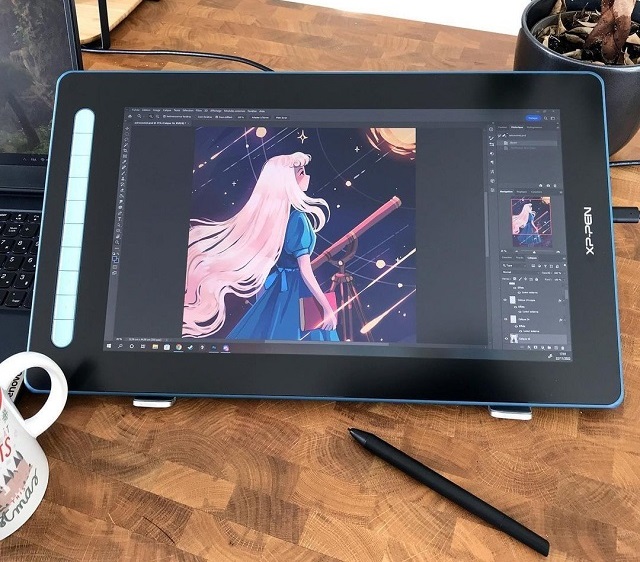
Each tablet on this list has something unique to offer, from their high pressure levels to their stunning displays that will help you take your creativity to the next level.
Whether you're a professional or just starting out, these tablets are sure to impress.
1. Wacom Intuos Pro
2. XP-Pen Deco Pro
3. Huion Kamvas 13
4. Wacom Cintiq 16
5. XP-Pen Artist 16 2nd gen
6. Huion Kamvas 22 Plus
7. XP-Pen Artist 24 Pro
8. Apple iPad Pro
9. Samsung Galaxy tab S9
10. Microsoft Surface Pro 9
Conclusion
All of the drawing tablets mentioned above are perfect for use with Photoshop and can help you create amazing pieces of art.
Each tablet has its features, so it is important to consider your specific needs when choosing one.
iPad Pro, samsung Galaxy tab or Surface Pro is the best choice if you don't mind spending a bit extra for superior features, as it offers Portability and an impressive screen for an enhanced drawing experience.
However, if you're looking for a more budget-friendly solution, then the other Wacom, Huion or XP-Pen tablet could be great options.
Whichever tablet you choose, you're sure to have a great experience creating art with Photoshop!
Source: https://pctechtest.com/best-drawing-tablets-for-photoshop
-
Best Drawing Pads for Adobe Illustrator
Freitag, 29. September 2023
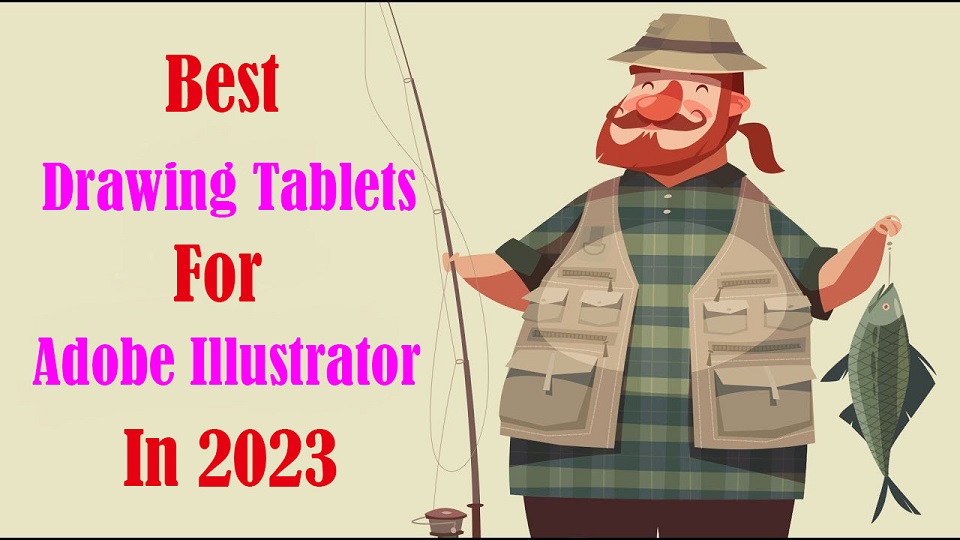
Adobe Illustrator CC is a powerful vector graphics editor that is widely used by professionals in various industries such as graphic design, illustration, web design, and branding.
It allows you to create scalable artwork that can be used for print, digital media, and multimedia projects.
To produce quality artwork in adobe illustrator, you need both the right skills and tools. The most important tool is the hardware on which you'll draw or edit the graphics on.
If freehand drawing and sketching is your thing, and you're an Adobe illustrator user, you might want to get a drawing tablet, which is easier and more fun than using a mouse.
With an ergonomic design and powerful features, these pen tablets allow unparalleled precision and flexibility in artwork creation.
However, With so many options available in the market, it can be challenging to determine which graphic tablet is best suited for drawing in Adobe Illustrator.
In this article, we will explore the best graphic tablets for Adobe Illustrator, their features, and their pros and cons.
What is Adobe Illustrator CC?
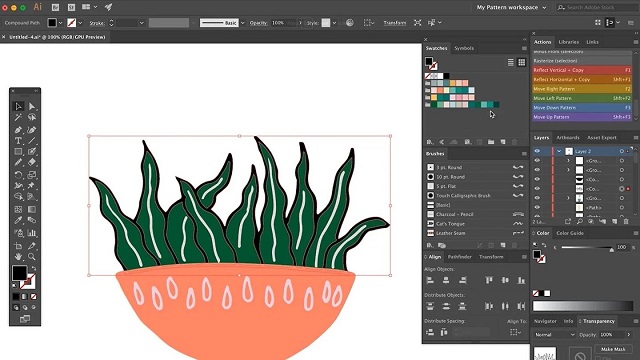
Illustrator has been the industry standard for vector graphics editing for many years. It is used by professionals around the world, and its file format (.ai) is widely supported.
The vector based nature of Adobe Illustrator means that it's perfect for creating graphics that need to be resized without losing quality. This makes Adobe Illustrator ideal for creating logos, icons, and text effects since they will look equally good at any size.
Illustrator offers a wide range of tools and features that allow you to create intricate and complex artwork. It provides precise control over paths, shapes, colors, and typography, enabling you to create stunning illustrations, logos, icons, and other design elements.
Professional artists and graphic designers can easily create stunning designs through easily accessible templates and presets. In fact, it provides over 80 million in-built templates, graphics, videos, and images to make online drawing and graphic design easier.
Illustrator comes with a bunch of useful features, some of the best features include advanced glyph snapping, team collaboration tools, and cloud storage.
Illustrator integrates seamlessly with other Adobe Creative Cloud applications like Photoshop, fresco and InDesign. This allows you to easily transfer files and assets between different programs, enhancing your workflow and productivity.
Illustrator can be used for a variety of projects, including print design (such as business cards, posters, and brochures), web design (such as icons and illustrations), mobile app design, packaging design, and more. It provides the flexibility to work on diverse creative projects.
Illustrator is a professional tool that requires a lot of practice to master. If you are serious about illustrations, you should definitely learn how to use a professional tool like Illustrator. Just be prepared for it to take some time. Remember to be patient!
Why get a drawing tablet for Adobe Illustrator?
As graphic designers we're accustomed to designing with a keyboard and mouse, but sometimes a task or design requires the precision of a freehand tool, and this is where a drawing tablet comes in handy.
If you're doing fairly solid objects, icons, logos, etc, then using the pen tool via a mouse or trackpad is fine.
If you're trying for more of a sketch or hand-drawn style, such as cartoons, then the pencil tool is perfect - and here's where the drawing tablet is a better option.
A graphics tablet consists of a pressure-sensitive surface and a stylus. The stylus acts as a pen or pencil, allowing you to draw, sketch, and paint directly onto the tablet.
To capture any freeform drawing gestures, nothing beats the hand with a stylus ! The stylus offers a more intuitive, nattural, effortless and comfortable way to draw and paint than a mouse could ever provide.
This also allows you to have much more control over the strokes that you make. You will be able to draw nice smooth lines just how you want.
Using a stylus can help reduce the risk of repetitive strain injuries (RSI) or carpal tunnel syndrome. Because it eliminates the repetitive clicking motion that comes with using a mouse.
Modern drawing tablets have up to 8,192 different levels of pressure sensitivity. When using illustrator, the pressure sensitivity applies to your brushes as well, like the Paintbrush Tool and Bob Brush Tool .
The pressure sensitivity allow you to vary the thickness or intensity of your lines based on how hard you press down. This can help you to create a wider range of effects and add more depth and nuance to your artwork.
Using the tablet and stylus also has an impact on workflow. Once you get going your workflow will become more efficient as well. Especially if you end up programming your own quick keys, you'll be unstoppable!
How to choose a graphics tablet for Adobe Illustrator?
While every tablet may have comparable benefits, not all tablets are created equal—so which tablet is best for Adobe Illustrator?
Below are the most important things you can look at to tell if the drawing tablet is worth buying.
1. Types of tablet
The first choice you need to make is to decide whether you want a simple graphics tablet without screen, a pen display monitor or even a standalone tablet with stylus.
graphics tablet: The graphics tablet has to be connected to a computer to work and visualize.
You have to learn to look at the computer screen instead of the tablet surface as you draw.
Because of the way it works, non-screen tablet have a bit of a learning curve and it does take quite a bit of getting used to.
However, non-screen tablets are often more affordable than pen display monitors, last longer and will always be better to carry around.
pen display monitor: A drawing tablet with screen, also known as a pen display monitor, is also a form of input hardware. The drawing surface, however, is a screen where you can see your artwork as you draw it.
Pen display monitors are far more intuitive, natural and comfortable than non-screen graphics tablets. At the same time, they are more expensive.
Since Pen display monitors are usually bulky and still need to be connected to a computer to work, they are not really portable like standalone tablets.
Standalone drawing tablet: A standalone tablet has both an inbuilt screen and a computer, supports pen input. You do not have to connect a computer to use it.
If you want the portability of an all-in-one tablet and enjoy drawing on the go, then thats probably your best bet.
But Standalone tablets are super expensive and has its limits, such as no built in keyboard and stylus (sold separately), limited/overpriced pc specs, etc.
2. Size
The size of the drawing area on the tablet is an essential consideration. It should provide you sufficient space to draw and express your artwork comfortably.
Smaller tablets are portable and convenient for artists, while larger ones offer more room for detailed work.
We recommend you to choose a tablet size that matches your screen ratio and allows you to draw without straining your arm or wrist.
3. Screen Quality
A good display is an important thing you should consider when shopping for a drawing tablet.
Drawing on a low-quality display is not only frustrating, but it will also produce low-quality work.
A fairly good display should consist of:
A high refresh rate for a snappy perceived response.
High resolution (FHD+ and above) for crisp images.
High brightness to be able to work with it outdoors.
Scratch resistance to withstand rough stylus pens.4. Pressure Sensitivity
Pressure sensitivity allows the tablet to respond to the varying pressure applied by the stylus.
This feature enables artists to control line thickness, opacity, and brush strokes, making the drawing experience more natural and similar to traditional art techniques.
Pressure levels on tables start at about 2,000 levels of pressure and go up to around 8,000.
In this case, the higher the number, the more responsive the tablet will be for you.
5. Tilt Recognition
Tilt Recognition is great feature for artists who like shading and depth. It reflects traditional tools like pencils and brushes, creating beautiful shading effects in your digital art.
Choosing a tablet with tilt recognition adds precision to your creations and make it realistic.
6. Stylus Type
There are different types of stylus: with or without battery.
Battery-free stylus don't need batteries or any wires to function, reducing maintenance and weight for a more natural pen feel.
The stylus of Wacom, huion and XP-Pen has no battery and doesn't require charging, they use advanced EMR technology which receives its power from the tablets.
Rechargeable stylus need charging just like your phone or laptop, such as the Apple Pencil, Surface Slim Pen 2 and Samsung S Pen.
If they run out of battery you will have to find a power source to charge before you can draw again.
Additionally, Some standalone tablets like apple ipad and microsoft surface don't come with a pen, so you'll have to get the pen separately.
7. Compatibility
Standalone tablets come with embedded operating systems which means that you cannot change them later.
iPad runs on iPad OS, samsung galaxy tablets runs on android while microsoft surface runs on Windows 11.
The Operating system will determine which graphic design software you can install.
Although adobe illustrator is available across most platforms: Windows, Mac and iPad OS, but it is not available on Linux, Android and Chrome OS devices yet.
Luckily, traditional drawing tablets are all compatible with both Windows and Mac operating systems, so they definitely works well with adobe illustrator.
8. Additional Features
Many advanced drawing tablets will include additional features like hotkeys, multi-touch, and wireless connectivity that are required to streamline your artistic process.
For standalone tablets, you also need to pay attention to tech specs include processor, ram, storage, graphics card and battery life.
9. Brands
Wacom is one of the most trusted brands in drawing tablets, It has the best stylus and the most expensive price.
But other brands, including Huion, XP-Pen and others, offer more added features at a lower price to compete with the wacom.
For standalone tablets, Apple, Microsoft, Lenovo, and Samsung are the the big players.
10 Best Graphics Tablet for Adobe Illustrator
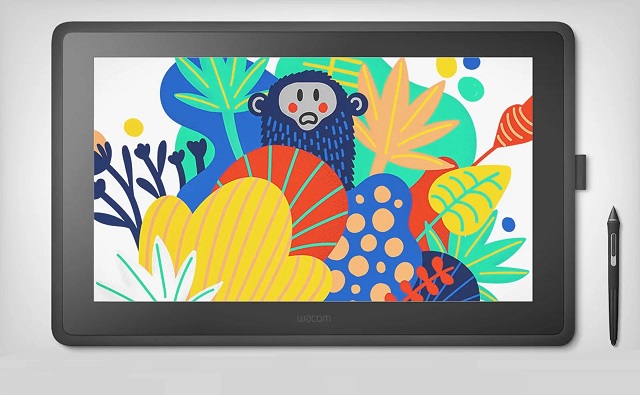
We have tested various brands from exclusive ones like Wacom to versatile options like iPad Pro and Surface Pros, and very affordable ones like XP-Pen and Huion.
Every adobe illustrator user will have different requirements, so we made sure to have a variety of top drawing tablets you can buy in 2023.
1. Wacom Intuos Pro
2. XP-Pen Deco Pro
3. Huion Inspiroy Dial 2
4. XP-Pen Artist 16 (2nd Gen)
5. Huion Kamvas 16 Pro
6. Wacom Cintiq 22
7. XP-Pen Artist 24 Pro
8. Huion Kamvas Pro 24
9. Surface Pro 9
10. iPad Pro
Conclusion
Despite having different sets of features and specifications, these are the best drawing tablets for adobe illustrator in 2023.
Whether you're a beginner or a professional, You can go with any of it if it fits in your budget and provides what you need.
Investing in a graphics tablet can help you take your digital art and design in adobe illustrator to the next level.
It will give you a lot of power to bring the objects of your imagination to the screen.
So consider adding this gadget to your toolkit and enjoy the benefits of a more natural and precise design process.
Source: https://pctechtest.com/best-drawing-tablets-for-adobe-illustrator
-
Best Pen Tablets for Creating Pixel Art
Sonntag, 24. September 2023

Pixel art is fun! It is a form of digital art drawn with graphics software in which color is applied to individual pixels to create an image.
It didn't die out in the nineties, and even started to regain popularity in video games.
If would like to make pixel art for artwork and video games you will need the right tools to create your pixel sprites.
When drawing Pixel Art, A lot of pixel artists work with a drawing tablet and others with a mouse.
Which one Is Better? Should you invest in a drawing tablet for pixel art, or stick with a mouse?
Both options have their advantages and disadvantages, depending on your style, preferences, and budget.
In this article, we'll compare the pros and cons of using a tablet vs a mouse for making pixel art, and help you decide which one suits you best.
Best Pixel Art Editors
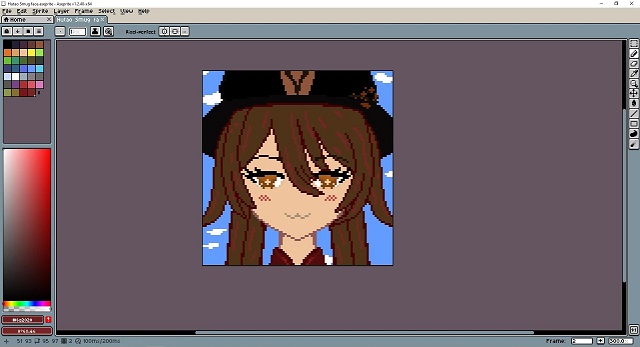
Digital art software allows you to draw on a computer will be your best ally for making pixel art.
There are also many programs available that are specifically designed for creating pixel art, such as Aseprite, GraphicsGale, and Pyxel Edit.
These programs often have features that are specifically tailored for pixel art, such as the ability to zoom in for precise pixel-level control, and a limited color palette that can be used to ensure that the final image has a consistent, retro look.
Here's a list of software commonly used for pixel art:
Aseprite: Great professional editor with many time-saving features and yet simple to use.
Graphics Gale: A free classic japanese pixel art tool, used in many games. Excels at animation with features such as onion skinning.
Piskel: A free and open source online pixel art editor with a user gallery.
Pyxel edit: a pixel art drawing app especially designed for working with tiles. pretty good, and the price tag is quite reasonable.
Photoshop: Powerful image editor not intended to make pixel art but you can set it up to use it.
Gimp: A multi-purpose image editor, designed to be a free replacement for photoshop. Can be configured to use for pixel art.
Paint.net: A free image editing program for windows, originally intended as a replacement for MSPaint. It supports pixel art.
Krita: A free, open source graphics program. It is intended for digital painting and 2d animation but can be set up for pixel art.
What is a drawing tablet?
A graphics tablet, also known as a drawing tablet, is a popular tool for digital artists, including those who create pixel art.
It allows you to draw directly on a screen or a surface with a stylus, which mimics the feel of a pen or a brush.
There are many different types of graphics tablets available, from entry-level models to professional-grade tablets.
Some tablets come with a built-in screen, while others connect to your computer and use your computer screen.
Mouse vs Drawing Tablet for creating Pixel art: which is better?
Tablet benefits
It is much easier, natural more comfortable to draw with stylus than mouse.
The pen tablet can reduce the risk of strain or injury on your wrist, hand, and arm, as you can adopt a more ergonomic posture and movement.
Since graphics tablet allows you to point at any point of the screen very fast, it cannot just make you draw or retouch comfortably, but faster as well.
Best of all Using a stylus can give you greater control and precision in your strokes compared to using a mouse.
This can be especially useful when creating pixel art, where precisely control the size and shape of each pixel is important.
Tablet drawbacks
However, a drawing tablet can be quite expensive, especially if you want a high-quality one with a large screen and advanced features.
Secondly, a tablet without screen can have a steep learning curve, as you need to get used to the disconnect between your eye and hand.
It might take you some time and practice to get used to a tablet and master its functions.
Thirdly, a tablet can be less portable and convenient than a mouse, as you need more space to use it. You might also face compatibility or connectivity issues with different devices or platforms.
Mouse benefits
Using a mouse can have some benefits for making pixel art, especially if you're used to it or prefer it.
A mouse can be more affordable and accessible than a tablet, as you can find one easily and cheaply in any store or online.
A mouse can also be more compatible and versatile than a tablet, as you can use it with any computer or software without any hassle.
Moreover, a mouse can be more precise and accurate than a tablet in some cases, such as when you need to make fine adjustments, edits, places or selections.
Mouse drawbacks
On the other hand, a mouse can be less intuitive and expressive than a tablet, as you have to rely on clicks and drags instead of natural strokes and gestures.
A mouse can also limit your creativity and flexibility, as you don't have access to pressure sensitivity, tilt recognition, or other features that a tablet offers.
Secondly, a mouse can be more harmful and uncomfortable than a tablet, as you can develop repetitive strain injury or carpal tunnel syndrome from using it for long periods.
6 Best drawing tablets for pixel art
A graphics tablet can be a valuable tool for creating pixel art, especially for blocking out shapes and clusters.
You can get away with using a cheap tablet when it comes to pixel art since you don't really need a super accurate pressure sensor!
1. One By wacom
2. XP-Pen Deco 01 V2
3. Huion Kamvas 12
4. XP-Pen Artist 10 (2nd gen)
5. ipad (9th generation)
6. Samsung Galaxy Tab S6 Lite
Conclusion
pixel art is doable with a simple mouse, because you actually don‘t „draw“, you just place the pixels. You don‘t have to draw dynamic and smooth lines.
If you want to make a quick sketch and easily draw your pixel art's form, especially curves, a graphic tablet helps. But most of the time you'll need to clean things up manually.
The common opinion that using a pen to rough and mouse to detail.
But really it's up to you!
Ultimately just use whatever you are most comfortable with and you should be fine.
Of Course, the final result will depend on the skills and creativity of the artist, as well as the features and capabilities of the software being used.
Source: https://pctechtest.com/best-drawing-tablets-for-pixel-art
-
Best gaming laptops in the world
Mittwoch, 20. September 2023
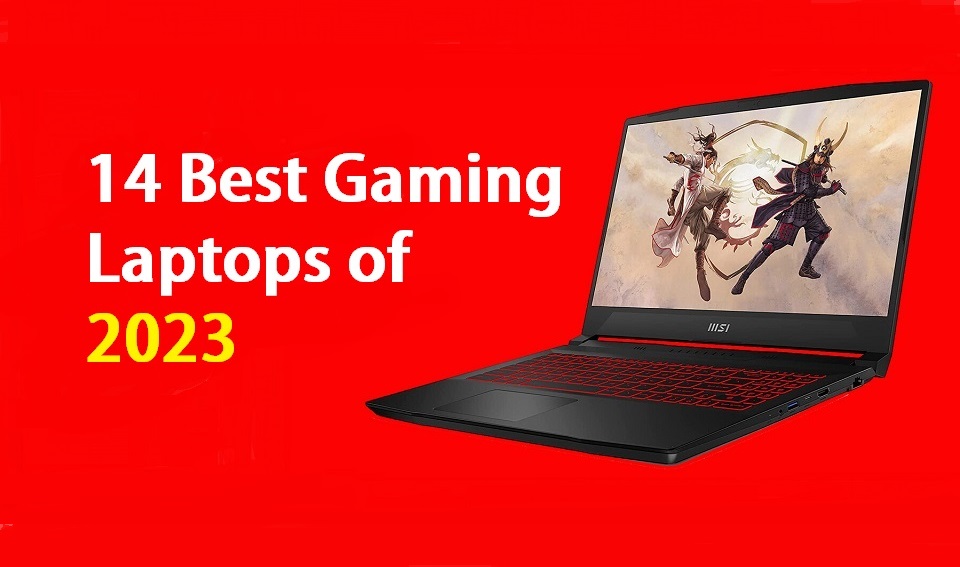
If you like to play games on the move, prefer a gaming laptop. It will also consume lesser space as compared to desktop.
Gaming laptops have come a long way in recent years, with advancements in technology allowing for more powerful and portable machines.
Smaller chips and lighter hardware have made it easier than ever to find a laptop powerhouse with high refresh rates, 2K or 4K displays, and the latest Nvidia's GeForce RTX 40-series graphics cards.
When it comes to potent, playable portable gaming laptops, there's more to choose from than ever. In this article, we'll take a look at some of the best gaming laptops of 2023.
Whether you're a hardcore gamer or just looking for a laptop with the horsepower to handle demanding applications, there's never been a better time to invest in a gaming laptop.
14 Best Gaming Laptops in 2023
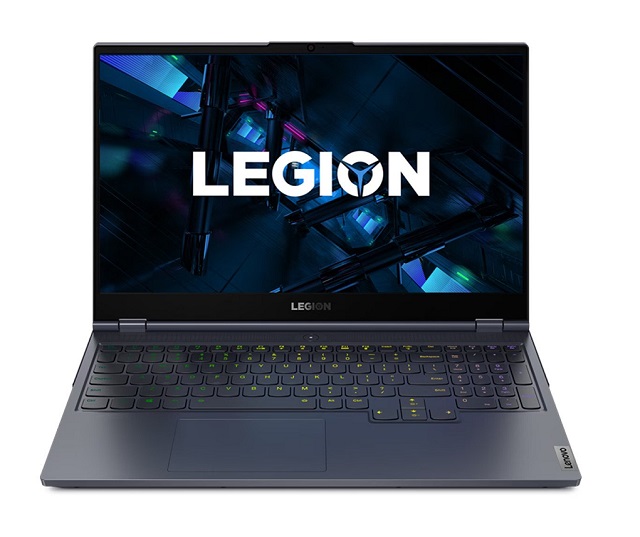
Below, We will review and comparison the top 14 gaming laptops in 2023 with their pricing, features, and technical details to help you select the best laptop.
As a reminder, this list isn't a definitive list to determine what you should get. It should give you an overall idea of what you should be able to expect in a given price range.
This category applies to anyone who is on a tight budget, all the way to the most expensive devices. It applies to anyone who want to play lighter games, as well as demanding games.
1. Razer Blade 16
2. MSI Titan GT77
3. Lenovo Legion Pro 7i
4. Asus Rog Strix Scar 16
5. Acer Predator Triton 500 SE
6. Asus TUF Gaming F15
7. Acer Nitro 5
8. HP Victus 16
9. Lenovo IdeaPad Gaming 3i
10. MSI GV15
11. Gigabyte G5
12. Asus ROG Zephyrus G15
13. HP Omen 17
14. Dell Alienware M15 R6
What should you consider when buying a gaming laptop?
There's never been so much to consider when it comes to hunting down your ideal gaming laptop.
On the outside, you've got to think about the screen, the build quality, and the keyboard– and the weight and the dimensions if you want to carry your machine around.
And then, on the inside, a good graphics card, a processor that can handle the card, and a RAM that does the work.
These components work together so you can get an overall good gaming experience, so the best thing you can do is look for a balance.
Graphics Card
For high demand on-screen purposes, the CPU integrated graphics is not sufficient.
Gaming laptops all have discrete graphics cards for a smooth gaming experience and high resolution. This is what gives your gaming laptop its extra oomph.
Please keep in mind that for this generation of GPUs, wattage matters a lot, often more important than the GPU model. For example, a very high wattage RTX 3060 may outperform a lower wattage RTX 3070 or RTX 3080.
Processor
The processor gives the set of protocols and power the laptop needs for its execution. The more powerful and latest your processor, the quicker your laptop can complete its task.
It is more important in gaming laptop than in a general use device, since games will benefit from having higher clock speeds and more cores / threads.
The CPU also affects the heat generated by your laptop. The more powerful the CPU, the more heat it will emit.
RAM
Memory is a solution for improving Laptop's performance. It is the storage to place the data it's currently working on. It has an impact on how well laptop performs in-game and while multitasking.
While 8 GB of RAM is still workable for those who play low-demand games or have little desire for fancy graphics, 16 GB RAM is a safe bet for most. Consider the step up to 32 GB or even 64 GB RAM if you're an avid gamer.
Storage
go for a solid state drive (SSD) over a hard disk drive (HDD) as it is way faster and will load you games faster. boot up speed is also lightning fast with a SSD.
Storage capacity lower than 256 GB is less enough to store high-end games. SSD are costlier than HDDs so if it goes out of your budget then opt for a combination of HDD and SSD .
Display
Gaming screens are an essential component for any gamer who wants to experience high-quality visuals and smooth gameplay.
When it comes to choosing the best gaming monitor, there are many factors to consider, including Size, resolution, refresh rate, response time, color accuracy, and more.
The gaming laptop requires a minimum resolution of 1920 x 1080, also a few gaming laptops accompany displays that support Nvidia's G-Sync or AMD's FreeSync for the real gaming experience.
Pay attention to the display's refresh rate as this dictates how many frames per second it can display. Refresh rates are measured in Hz, with a higher figure resulting in smoother onscreen action.
Weight
When it comes to weight, most of us wish to have a system that is light-weight and slim, So it is a very significant factor that completes a gaming laptop.
Nobody wants a bulky laptop to carry all day, thus before buying a laptop make sure that it's a thin and sleek design laptop.
However, Most gaming laptops are big and heavy compared to even cheap regular laptops.
Battery Life
For Nvdia RTX-carrying hardcore gaming laptops, hitting the 4-hour mark is an accomplishment.
Gaming laptops are considered to have “excellent” battery lives when you can get 3 or 4 hours out of them while playing games.
Cooling Technology
Pay attention to thermals! Laptops with small and thin design, have less airflow and are more susceptible to heat problems.
The Cooling Fans are crucial to have good airflow. It helps to reduce overheating.
The heat sink or thermal Pipe is what dissipates heat from your laptop's CPU and GPU, as well as other components.
You can also mitigate this problem by buying a laptop cooler (maybe $20–50).
What screen size is best for a gaming laptop?
A gaming laptop's standard screen size is between 15.6 inches and 17.5 inches for an impactful and immersive gaming experience.
If you are a gamer who demands an impactful and immersive gaming experience, then the best screen size for you would be 16.1 or 17.3 inches.
What are the different gaming laptop series by various brands in the market?
Razer makes some of the most premium and well-known gaming laptops with its Blade line.
Acer offers Predator, Nitro, and Aspire series in Gaming laptops.
ASUS offers the premium ROG (Republic of Gamers) series and TUF.
Lenovo offers Legion and Ideapad gaming laptops.
HP offers Omen, Victus, and Pavilion series.
Dell offers the premium Alienware series and the affordable G Series.
MSI offers 6 gaming laptop series, namely Crosshair, Vector, Stealth, Radar, and Stealth M, all acclaimed to empower the ultimate gaming experience.
Gigabyte have certainly impressed us of late with their range of Gaming laptops.
How much should you spend on a gaming laptop?
Gaming laptops don't come cheap. The powerful internal components needed to run AAA titles mean that even budget options will set you back around $1000. We don't recommend dipping much below that figure if you want a satisfying gaming experience.
Decent mid-range options tend to cost in the region of $1,000 to $2,000, while premium devices designed for gamers that want top-end specs and all the bells and whistles available can expect to pay in excess of $2,000.
Notice that not all gaming laptops are built the same. The cheaper gaming laptops have good hardware but are really low on quality. Speakers, screen and chassis are not top notch.
Some brands give you the best bang for your buck for internals but you'll have to live with stuff like chassis flex, mildly irritating trackpads and cheap plastic builds.
Gaming Laptop vs Desktop PC: Which Should You Buy?
Gaming laptops obviously are less value when compared to similarly configured PCs. If you have the luxury of staying in a place for any decent amount of time, buy a desktop.
The performance of gaming laptop components at same configuration as of gaming PC is slightly lower because laptop components are smaller in size and are less powerful as compared to PC components. So, if are a professional gamer , gaming PC would be better for those.
Casual gamer's who don't like to play multiplayer games like PUBG, CS, etc and like to play GTA, Call of Duty, etc. casually can opt for gaming laptop.
Price difference between a gaming PC and gaming laptop is very much.Gaming laptops are very expensive as compared to gaming PC build.
In our opinion, gaming laptops are worth it, because they are able to pack such power into these portable sizes.
If you do a lot of traveling and don't always have access to a quality gaming desktop, this is a solution. And the components are strong enough that it should last you through a few generations of decent gaming before its performance starts to become a little wanting.
If you really want a gaming laptop that can also do a great job as an all-around everyday machine, you can't do much better.
Conclusion
A gaming laptop can be worthwhile for you if you're a serious gamer who wants to play the newest titles with high graphics settings and fluid performance.
Strong hardware, including top-tier CPUs and GPUs, as well as quick and responsive displays, are features that are incorporated into gaming laptops.
Ultimately, the best laptop for gaming will depend on your specific needs and budget, but the above 14 options are all great choices that are sure to provide a great gaming experience.
Whether you're looking for a high-performance machine with top-of-the-line specs or a budget-friendly option that still offers great performance, there's sure to be a gaming laptop that meets your needs.
If you have any questions about anything listed here, let us know, we will assist you!
-
Best drawing pads for kids and teenagers
Samstag, 9. September 2023
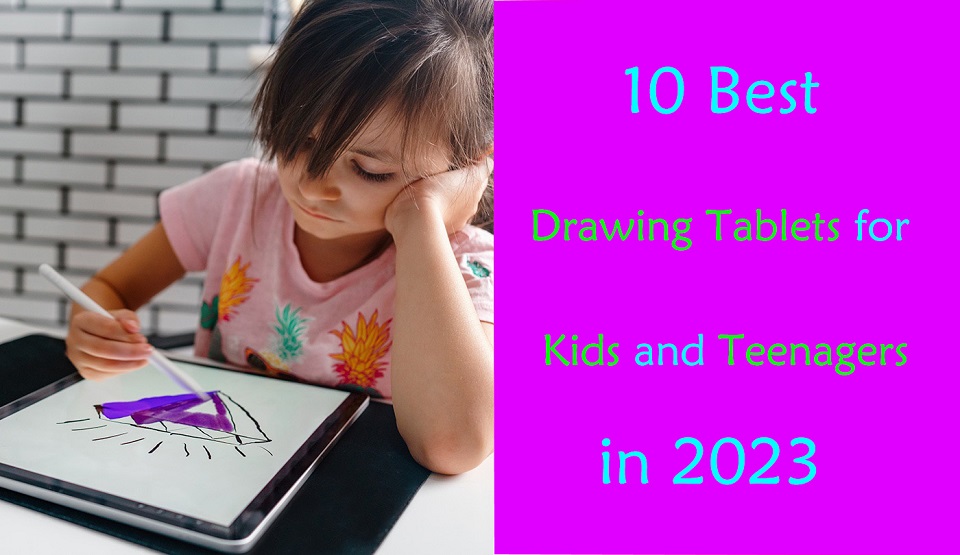
All kids love to draw. Drawing helps to develop their imagination, fuel their creativity, express themselves, and enhance their artistic abilities.
If your kid is passionate about drawing, doodling and writing, it is a must to provide them with essential items to enhance their skills.
Your child can be extraordinary or can something better if he/she has the right gadget and resources in their hand.
Digital art tablets are a fantastic gift for creative young learners, Which typically involve a stylus and a responsive surface, are a great addition to any toy box.
Endlessly reusable, they are eco-friendly, mess free, and safe—your toddlers won't be eating crayons or sticking paint in their mouths.
This allows Kids to explore different brushes and colors on the digital canvas. and can email art work to her family or print out multiple copies to give to friends at school.
It's also a wonderful opportunity for parents to bond with their children and participate in their creative journey.
But the problem is that there are so many drawing tablet brands, types and models available on the market. It can all be very overwhelming for a parent who just wants to get a good tablet for their curious child.
Fear not, we have narrow the pool of options down to the best models on the market. We'll also talk in depth about some topics related to tablets for kids.
That way, you'll be able to make a better choice when you're shopping for a drawing tablet for your child.
What is a Drawing Tablet?
A drawing tablet, also known as a graphics tablet, is a device that allows artists to draw and create digital art using a stylus pen and a touch-sensitive surface.
It allows you to interact with a drawing software such as Krita, illustrator or Photoshop.
The tablet is connected to a computer or standalone, which allows the artist to see their creations in real-time on their screen as they draw on the tablet.
Is a drawing tablet worth it?
Drawing tablets offer several advantages over traditional drawing methods.
They allow for more precise control and accuracy than mouse when drawing.
With a stylus pen, artists can create lines and shapes with ease, and pressure sensitivity allows for control over the thickness and opacity of the lines.
Drawing tablets also offer the ability to undo mistakes and make changes easily, as well as the ability to work with layers and other digital tools that can enhance the creative process.
How many types of drawing tablets for kids?
If you're not a major drawing tablet user yourself, you might find yourself suddenly intimidated by the nuances of the drawing tablet market.
When it comes to the best drawing tablets for kids and teenagers, there are 4 main categories to think about.
The naming of the 4 types of tablets can be confusing, so let's understand what they're called and the main differences.
1. LCD Writing Tablet
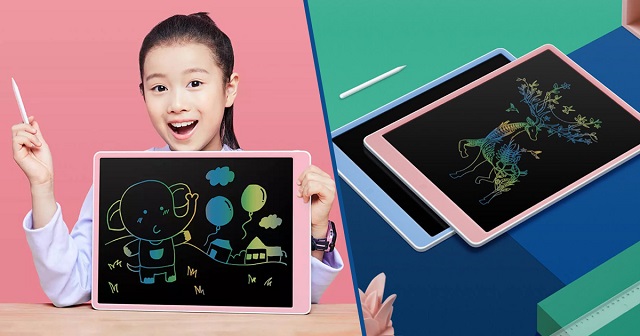
LCD writing tablets use liquid crystal display technology to create a digital writing surface that can be easily used with a stylus or other writing tool.
Moreover, these digital surfaces can be reused multiple times because of the integrated erase function.
The most popular use of LCD Writing Tablets is perhaps as a children's toy, a doodling device, something that replaces paper, doodling books and chalkboards, saving a lot of money for parents due to low price.
Some common criticisms of the generic LCD Writing Tablets have included their inability to save the work or erase partially without deleting the entire screen.
2. Non-screen Drawing Tablet
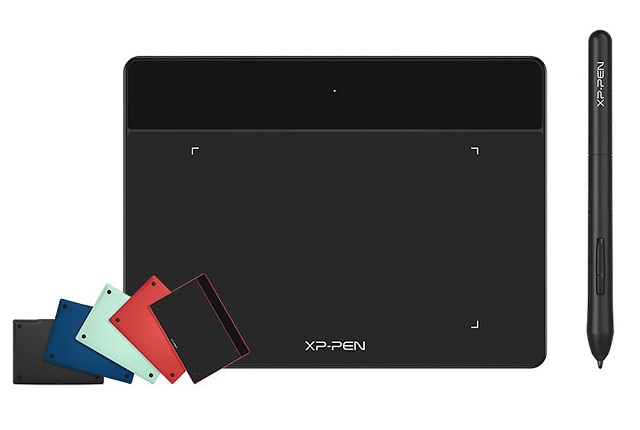
A non-screen graphics tablet is the most basic type of drawing tablet. It consists of a stylus pen and a touch-sensitive surface that connects to a computer (Windwos, Mac, Linux and Chrome OS) or Android mobile device.
They can connect to computer using a single USB cable or wireless using bluetooth or 2.4GHz wifi.
The tablet itself does not have a display, so artists must look at their screen while drawing on the tablet. This requires hand-eye coordination, so it may be difficult to use at first. There will be a several-day learning curve.
However, Screenless tablets are usually cheaper than other types of drawing tablets, Most are under $100, making them a great option for beginners and amateurs.
3. Drawing tablet with screen
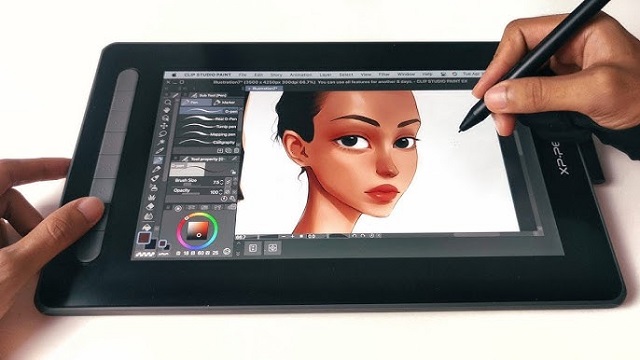
This type of drawing tablet comes with a built-in screen. This allows the artist to draw directly on the tablet's display, which can provide a more natural and intuitive drawing experience.
Display drawing tablets come in a variety of sizes and resolutions, from 10-inch with 1080p resolution to 32-inch with 4K resolution. However, they are typically more expensive than non-screen graphics tablets, which can cost anywhere from $200 to $4000.
There are also a lot of cables (USB-C, HDMI, power cable) you need to plug in to connect to a computer and it won't function wirelessly like the non-screen tablet does.
4. Standalone Drawing Tablet
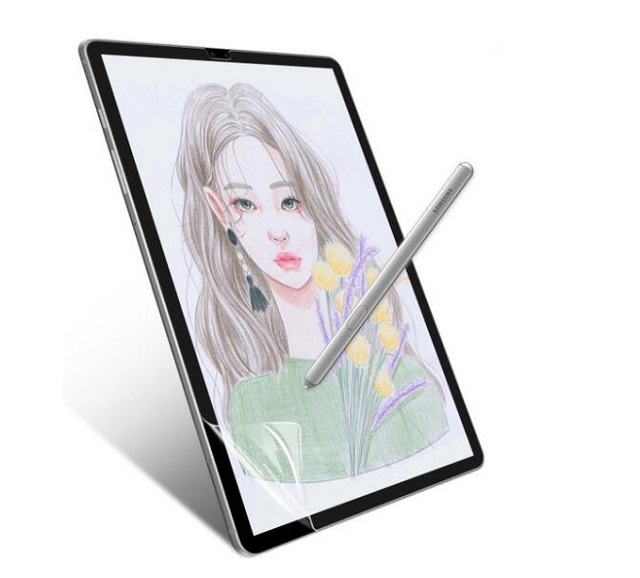
This type of drawing tablet does not need to be connected to a computer or mobile device to work. These tablets often have built-in operating systems (Windows, iOS and Android), computer, screen and stylus.
They can be used for tasks like watching videos, browsing the internet and playing games, in addition to creating digital art.
Standalone drawing tablets are the most expensive type of drawing tablet, but they offer the most versatility, portability and convenience.
How to Choose the Right Drawing Tablet for Kids?
If you're not a major drawing tablet user yourself, you might find yourself suddenly intimidated by the nuances of the drawing tablet market.
We've added this buyer's guide section to help you find the best tablet. There are a few things that you should keep in mind when choosing a drawing tablet for your child:
Size of drawing area
Different drawing tablets have different sizes, and it is the working area / screen size that defines the size of the tablets.
The bigger the size of the working area / screen, the higher the price will be in most cases.
A bigger working area/ screen provides a better and comfortable drawing experience while smaller tablets provide better portability.
Pressure Sensitivity
Pressure sensitivity refers to the amount of pressure needed to create a line or shape with the stylus pen. A higher level of pressure sensitivity allows for more precision and control when drawing.
Most modern drawing tablets come with varying levels of pressure sensitivity, usually ranging from 2048 to 8192 levels.
The higher the level of pressure sensitivity, the more control a kid has over the thickness, opacity, and texture of their lines and strokes.
Operating System and Compatibility
When choosing a drawing tablet with or without screen, it is important to consider its compatibility with your computer or mobile device.
Most drawing tablets are compatible with both Windows and Mac operating systems, but some may not be compatible with certain art software or devices (chromebook and android).
For standalone drawing tablets, Even while the iPad, windows and Android tablets are capable devices, a Windows tablet or iPad may be a better option if you're looking for something that you will use primarily for drawing.
On the other hand, the Android google play store lacks the large number of apps offered on iOS and Windows.
Brand
Wacom has long been the go-to brand for digital artists and creatives when it comes to pen tablets, but they're overpriced due to brand name. Huion and XP-Pen are both great, affordable options.
For standalone drawng tablets, Amazon Fire, Microsoft surface, Apple iPad and Samsung Galaxy tab are good picks.
Parental Controls
Parental controls on laptops and tablets allow you to automatically limit the amount of time your child spends on their device, as well as to otherwise control and monitor their screen time.
Luckily, Most tablets and laptops will offer these in some form, but you need to check it before buying.
Safety and Durability
The kids may be cute, but they aren't exactly careful, so the tablet needs to be able to roll with the punches.
If the drawing tablet is without screen, it will be more durable and have a longer lifespan.
Cracked screens reveal sharp edges, so displays with reinforced, shock-proof bezels are a fantastic choice.
Additionally, Purchase a good case can protects drawing tablet from shock, drops and scratches.
Age Group
For young kids under the age of 7, a simple LCD Writing tablet that allows them to draw and doodle is perfect. They don't need anything fancy.
As children get older or for teenagers, more advanced drawing tablets can help them practice, fine-tune, and learn different methods of design and draw.
In fact, even adults can use pen tablet for their daily routine: writing, drawing, taking notes, editing photos, Annotating PDFs and much more.
Price Tag
Kids doesn't need fancy tech, something basic enough to be built durable is just fine
In addition, Even if they've got talent, they could just as well be enamored with something else within a month.
So you can lessen the blow to your finances by choosing the most affordable option that still appeals to your child.
If you have a teenager who’s serious about diving into graphic design at a professional level, it’s a good idea to get something with lots of features and functionality.
10 Best Drawing Tablers for Kids in 2023
Below, we'll go through 10 best drawing tablets for kids. You'll get details and feedback on each one. That way you'll be able find a perfect fit.
1. iPad 9th Gen
2. Samsung Galaxy Tab S6 Lite
3. Microsoft surface Go 3
4. Amazon Fire HD 10 Plus
5. One by Wacom
6. XP-Pen Deco Fun
7. Huion Inspiroy H640p
8. XP-Pen Artist 12 (2nd Gen)
9. Wacom One
10. Huion Kamvas 13
Conclusion
If your kids have an interest in digital art or creative activities, getting a drawing tablet will help with that.
With which, they can draw, sketch, write, animate, and create projects that can express their creativity.
There should be at least one drawing tablet on our list that's perfect for your child's abilities and age group.
We hope you find our reviews helpful! Your choice would depends on your child's age, needs, preference and your budget.
Furthermore, We suggests limiting recreational screen time to 1-2 hours per day for children aged 2-5 and setting consistent limits for older children based on their individual circumstances.
Source: https://pctechtest.com/best-drawing-tablets-for-kids-and-teenagers
